The Rocky Mountaineer is considered one of the most luxurious and scenic train experiences in North America, with service through Western Canada and the American Rocky Mountains. What began as a family-owned enterprise in 1990 is now the world’s largest privately-operated luxury train experience.
I had the opportunity to take the Rocky Mountaineer and try it for myself recently, when my partner Jessy and I ventured from the West Coast to the Rocky Mountains for two days of grandeur aboard the train.
While I’ve taken a few train trips before, this would be my first time onboard a luxury train of any kind, and I was excited to see how it would compare to my many flights in premium cabins.
In This Post
- Rocky Mountaineer – Routes
- Rocky Mountaineer – Classes of Service
- Rocky Mountaineer “First Passage to the West” – Booking
- Rocky Mountaineer “First Passage to the West” – Departure
- Rocky Mountaineer “First Passage to the West” – Cabin
- Rocky Mountaineer “First Passage to the West” – Seat
- Rocky Mountaineer “First Passage to the West” – Dining Car
- Rocky Mountaineer “First Passage to the West” – Day 1
- Rocky Mountaineer “First Passage to the West” – Day 2
- Rocky Mountaineer “First Passage to the West” – Other Facilities
- Conclusion
Rocky Mountaineer – Routes
There are four distinct rail routes offered by the Rocky Mountaineer, which operates from April to October each year:
- “First Passage to the West”, which we took, is the most popular route, and was previously known as the “Kicking Horse Route”. This itinerary encompasses a two-day trip from Vancouver to Lake Louise or Banff, with an overnight stop in Kamloops en route.
- “Rainforest to Gold Rush” runs from Vancouver to Jasper over the course of three days, with stops in Whistler and Quesnel.
- “Journey Through The Clouds” travels from Vancouver to Jasper, with only one stop in Kamloops along the way.
- “Rockies to The Red Rocks” is a two-day route available in the US Rocky Mountains. This route runs from Moab to Denver, and is currently the lone route outside of Canada.
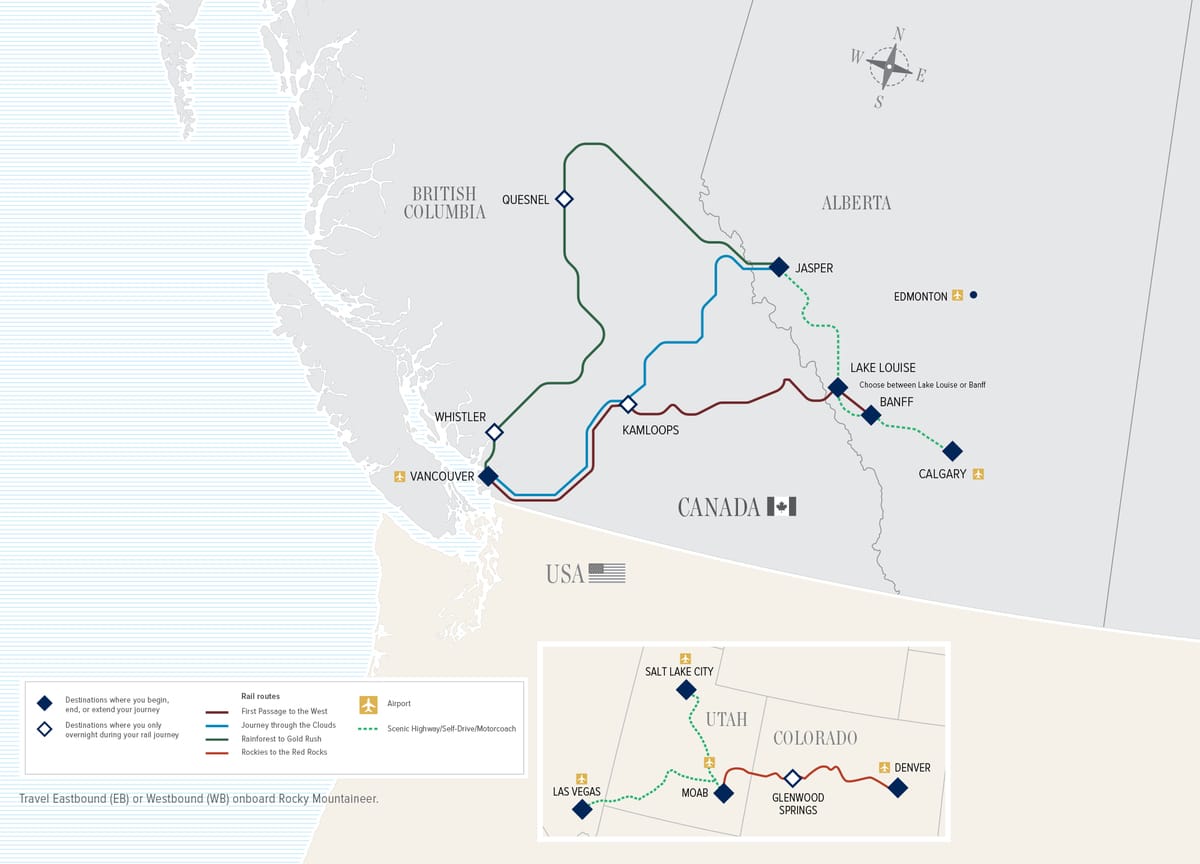
Several packages are available. We embarked on one of the “Short Journeys”, which takes two or three days across the various routes.
Mid-length trips are known as “Rocky Highlights”, which provide extra days to visit prominent stops, and “Circle Journeys” are the longest possible booking option, which allows passengers to combine multiple routes for a more extensive experience.
Rocky Mountaineer – Classes of Service
The SilverLeaf cabin is the base-level offering onboard the Rocky Mountaineer, while the GoldLeaf cabin is Rocky Mountaineer’s premier class, with an elevated railway experience.
Both include complimentary meals and snacks, as well as alcoholic and non-alcoholic beverages. However, with the GoldLeaf Service, there are a few notable extra inclusions.
SilverLeaf is a single-level carriage with stationary seats and standard windows. In comparison, GoldLeaf has a two-level carriage, with a dining room and outdoor viewing platform on the lower level.
Furthermore, GoldLeaf features full-dome glass windows on the upper level for unparalleled landscape views. Moreover, the seats are roomier, and have the ability to recline.
If you’re travelling in SilverLeaf, you also can upgrade to SilverLeaf Plus on certain routes, which grants you access to a lounge car. This lounge has its own dedicated host, bar, and lounge chairs, which makes for a nice, social atmosphere.
Rocky Mountaineer “First Passage to the West” – Booking
You can book the Rocky Mountaineer directly online or through a travel agency. A travel agent can arrange the train ride as a part of a more extensive package trip through the region.
For a two-day journey on the First Passage to the West route that travels from Vancouver to Banff, it’s around $1,800 (CAD) in SilverLeaf and $2,000 (CAD) in SilverLeaf Plus. Booking a GoldLeaf journey comes with a price tag of around $2,500 (CAD) per person.
Recall that Rocky Mountaineer also offers a partnership with Aeroplan. If you have Aeroplan Elite Status of at least 50K status or a premium Aeroplan co-branded credit card, you get an automatic upgrade from SilverLeaf to GoldLeaf, subject to availability at the time of booking.
Furthermore, all Aeroplan elite members, as well as premium co-branded credit cardholders, will enjoy a hotel room upgrade on the first and last nights of their journey.
As an Aeroplan elite member or premium credit card holder, your best bet is to book SilverLeaf, confirm an upgrade to GoldLeaf if possible, and also secure upgraded accommodations at the hotels along the way.
It’s also possible to redeem Aeroplan points for Rocky Mountaineer gift cards to cover the ticket cost, although it isn’t necessarily the highest-value use of Aeroplan points.
For full disclosure, I booked this journey on the “First Passage to the West” route in the GoldLeaf class of service at a favourable travel agent rate to review the experience.
Rocky Mountaineer “First Passage to the West” – Departure
For this two-day experience from Vancouver to Banff, we showed up at the Vancouver trainyard bright and early at 7am.
The Rocky Mountaineer Station is located close to the Pacific Railway Station; however, the Rocky Mountaineer has a separate trainyard of its own.


The check-in process is smooth and swift. Simply show the attendants your boarding pass, and they will grab your checked luggage. Luggage is then loaded onto a separate bus that travels by road to Kamloops, and eventually onwards to Banff.
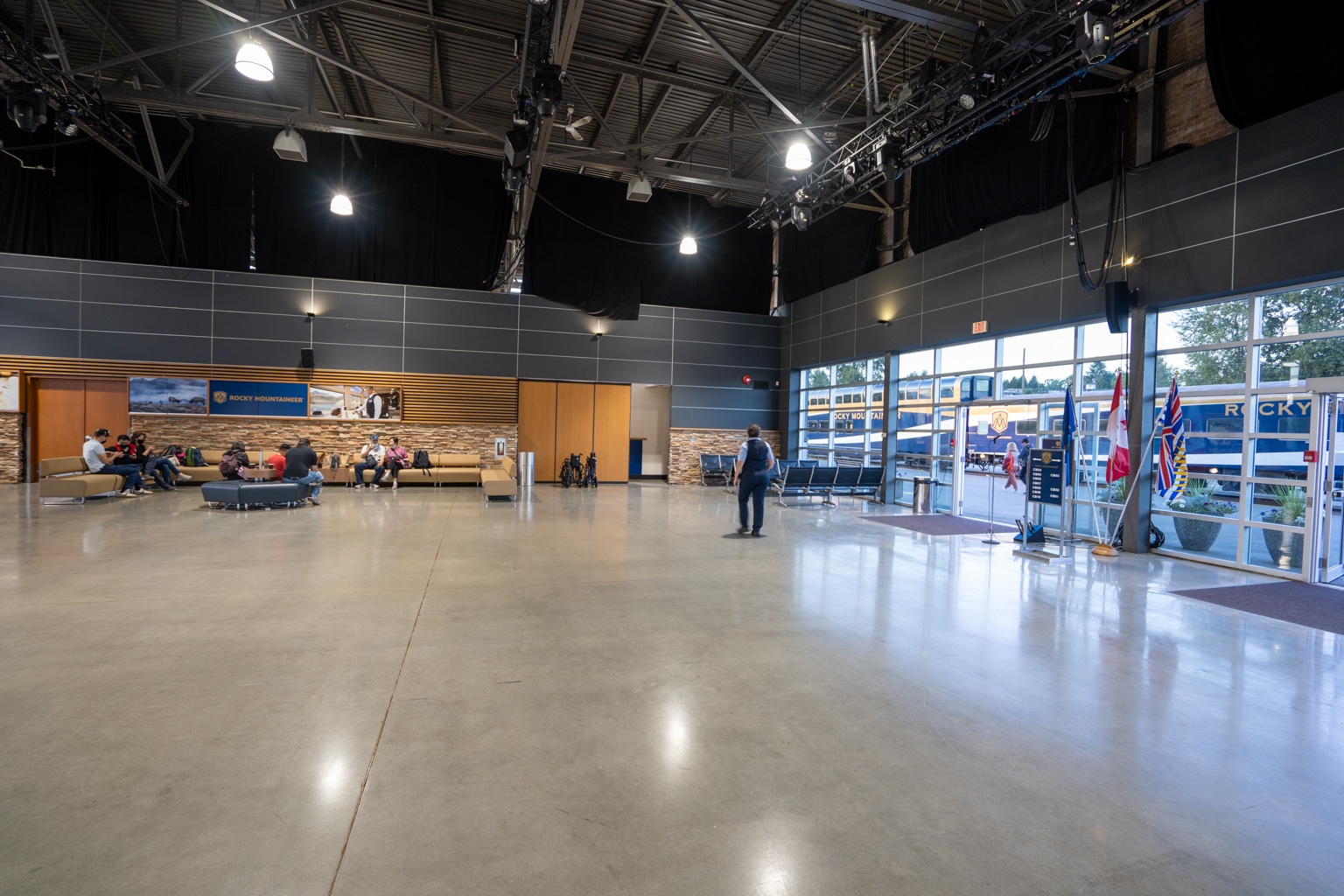
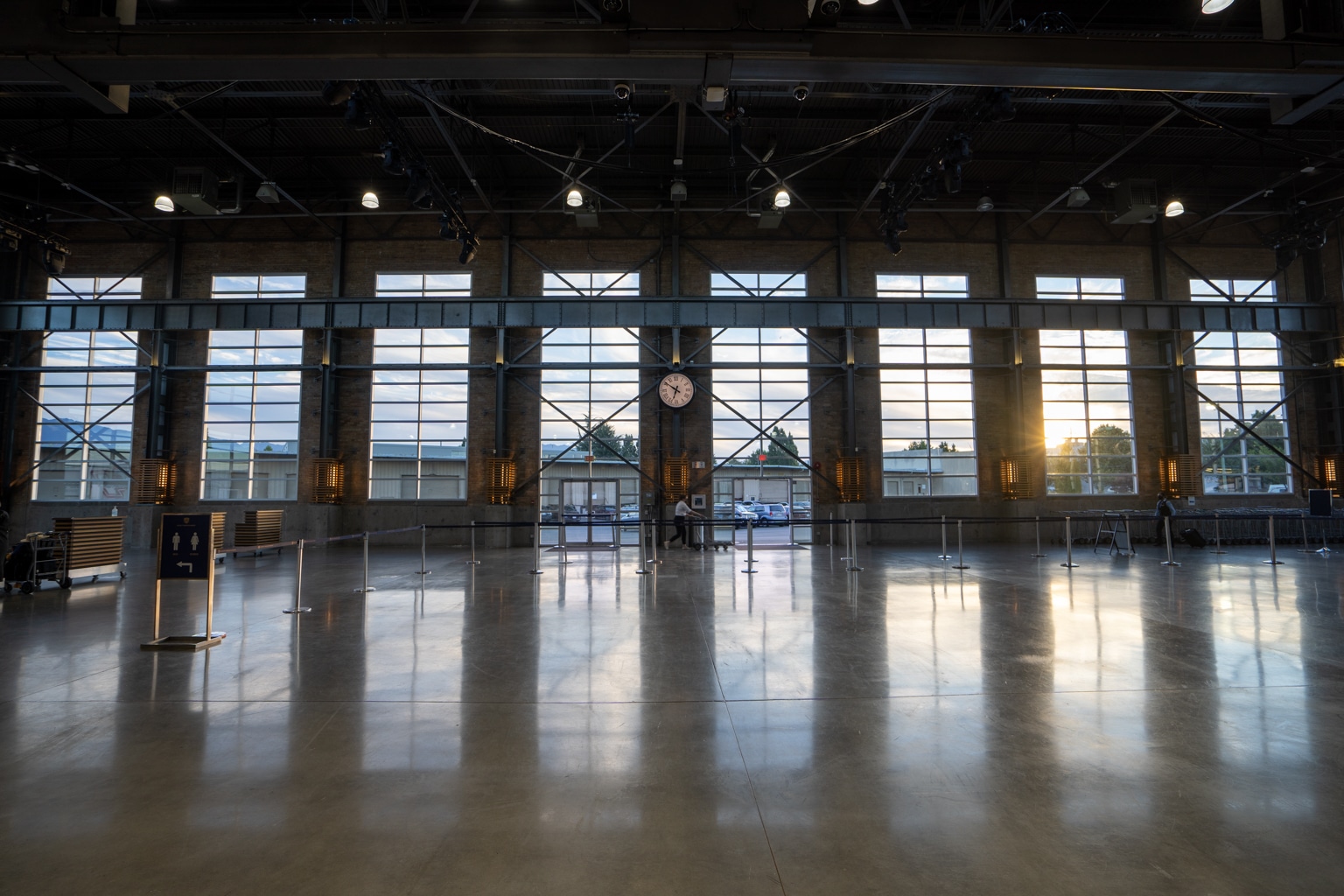
The boarding pass includes your pre-assigned seat and coach for the journey. For those on a “Circle Journey” round-trip booking, a different coach and seat are assigned for each leg.
Before making our way onboard, we were invited to help ourselves to some coffee or tea in the waiting area.
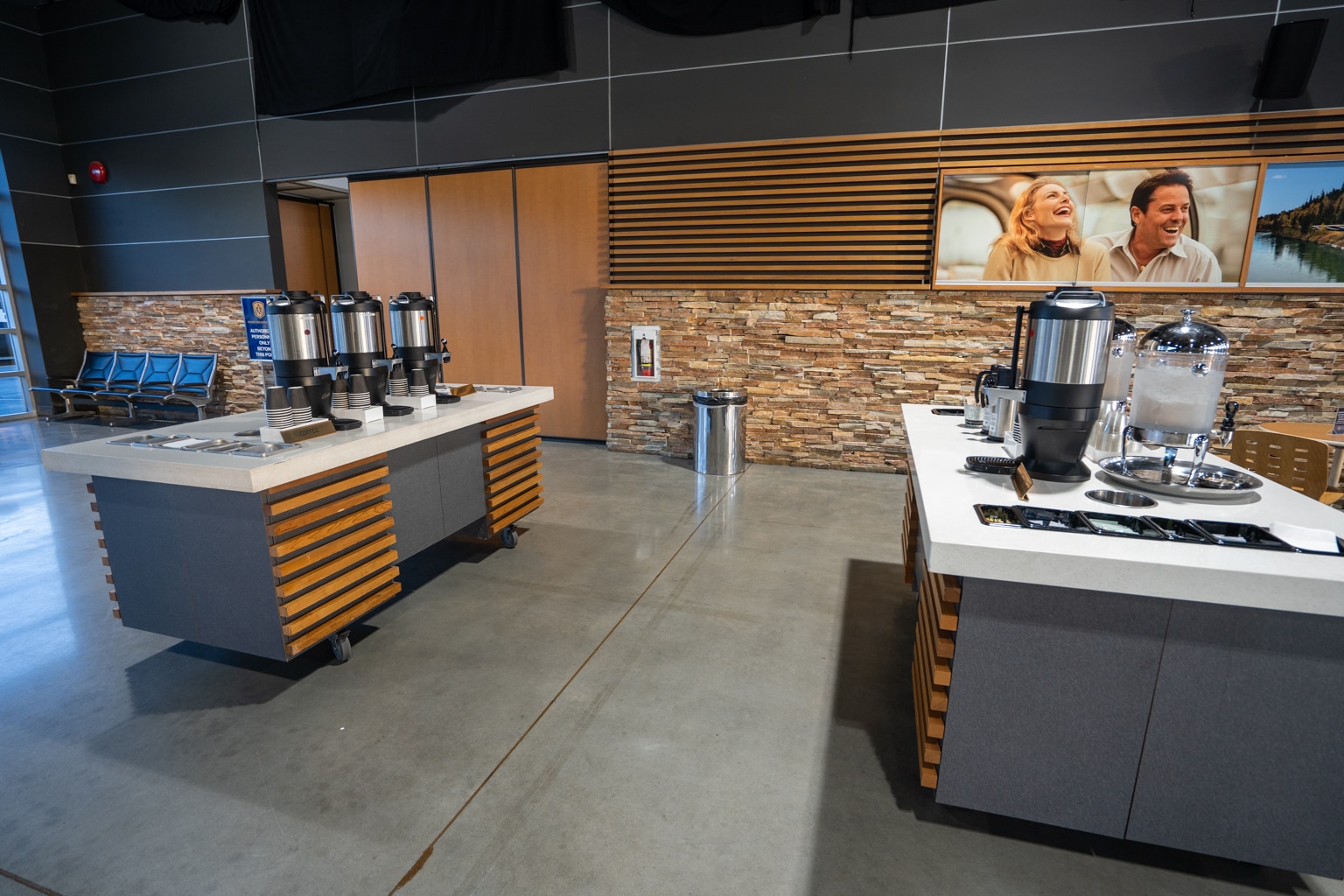
As I sipped on a warm beverage, I spent some time admiring the exterior of the beautiful façade of the train.
The exterior is adorned in a deep blue, with touches of gold and white. The double-mountain logo is printed sharply between a Canadian and British Columbian flag.
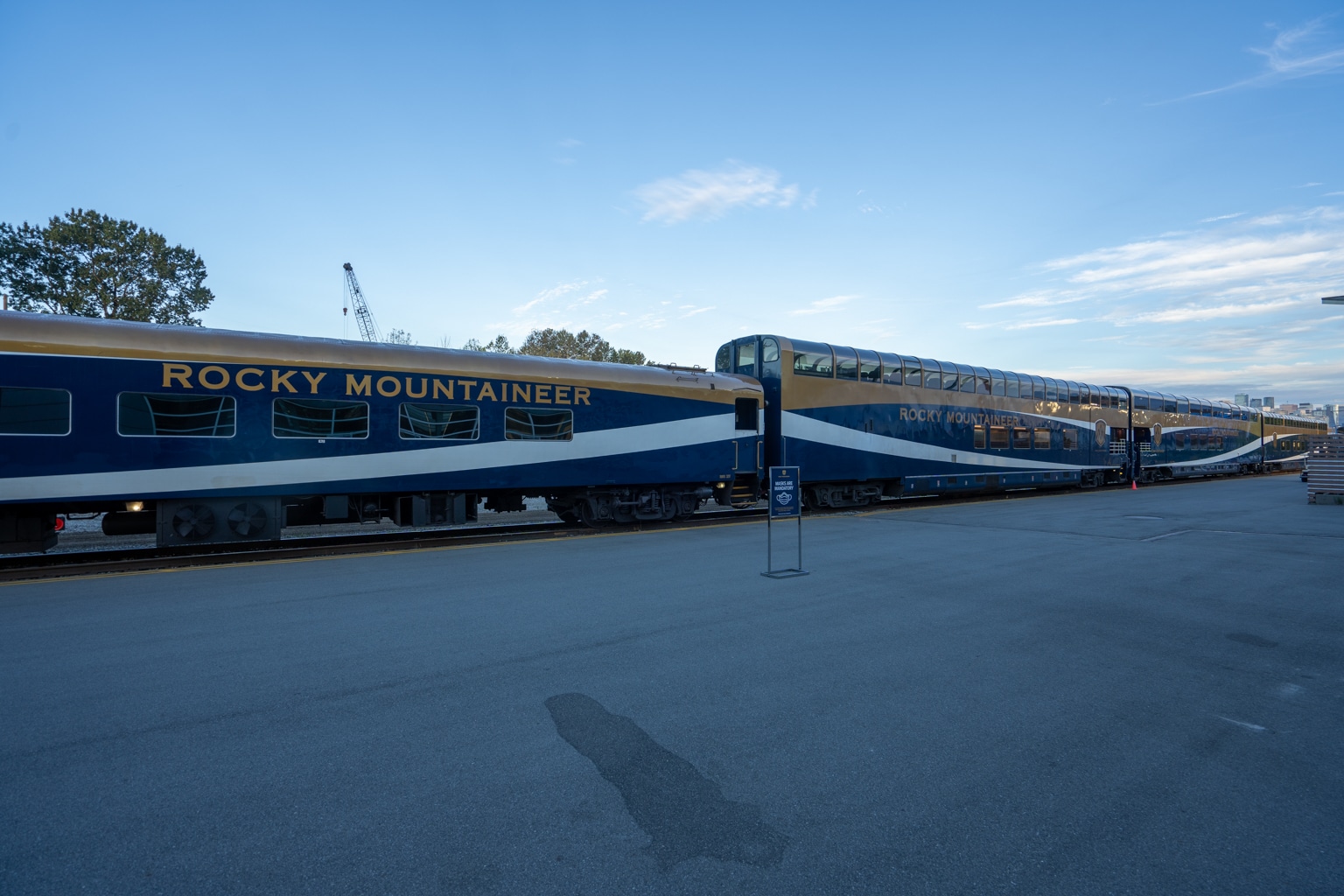
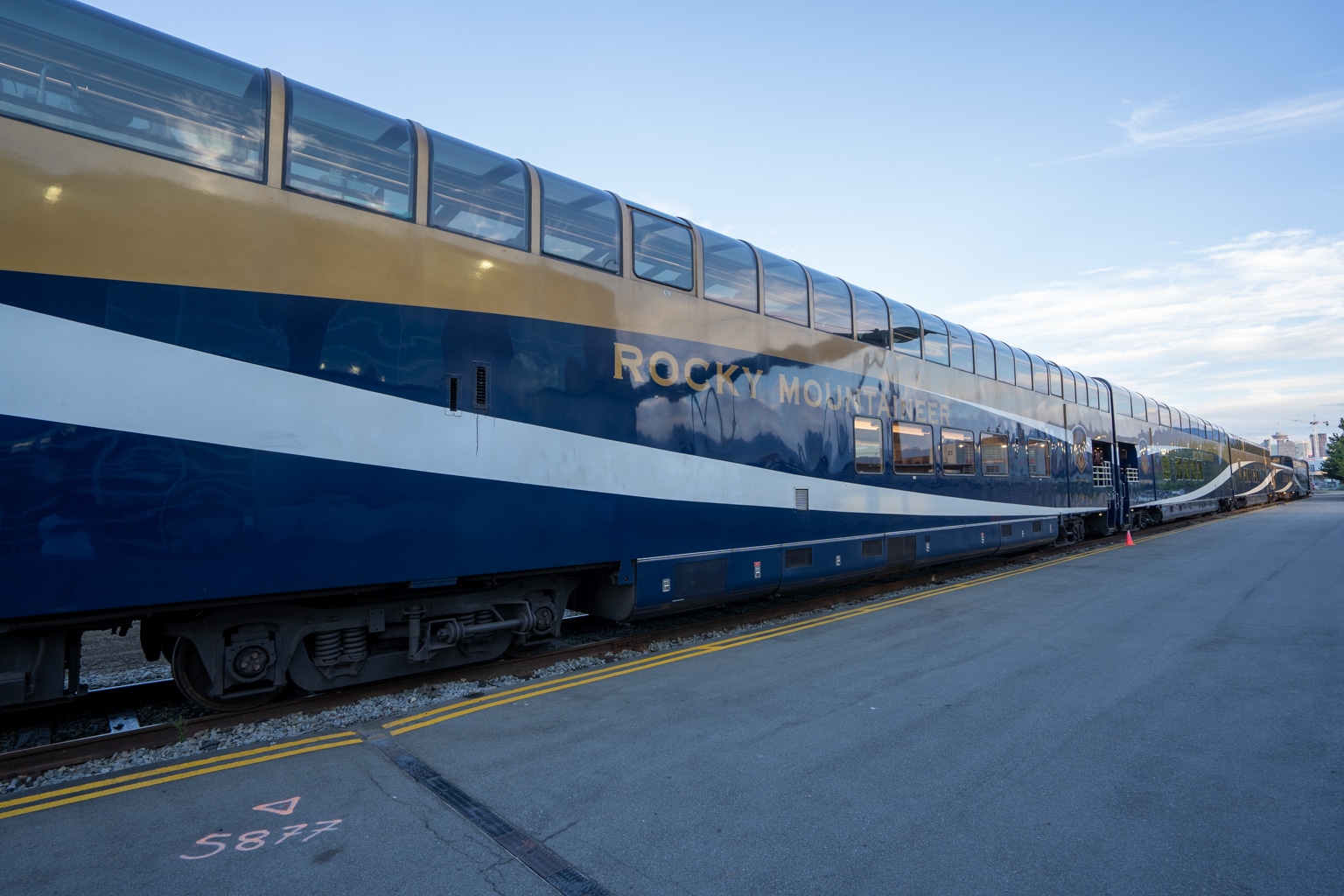
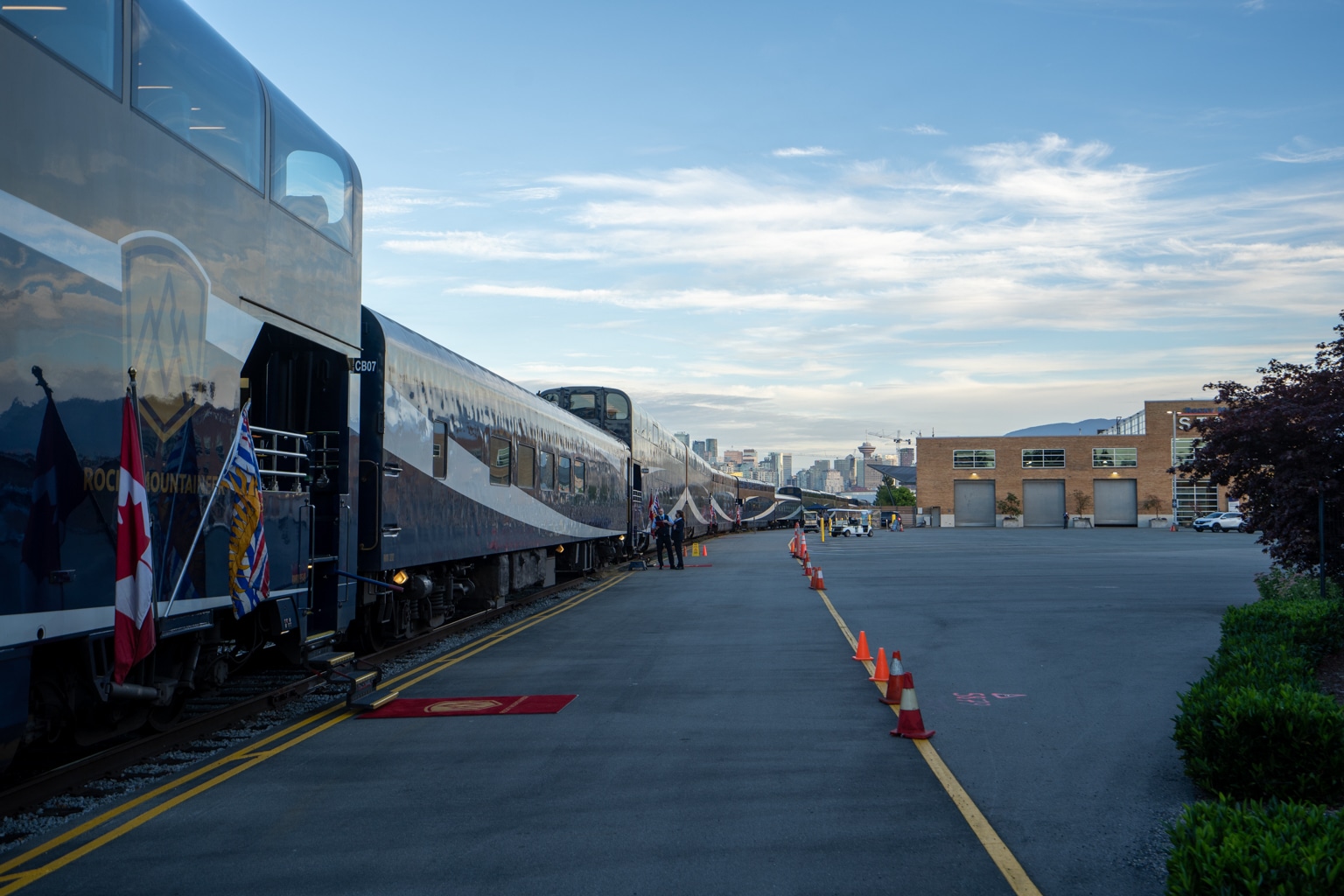
Below the train steps was a vibrant red carpet, ready to welcome us onboard and into the GoldLeaf cabin to kick off this exciting two-day journey.
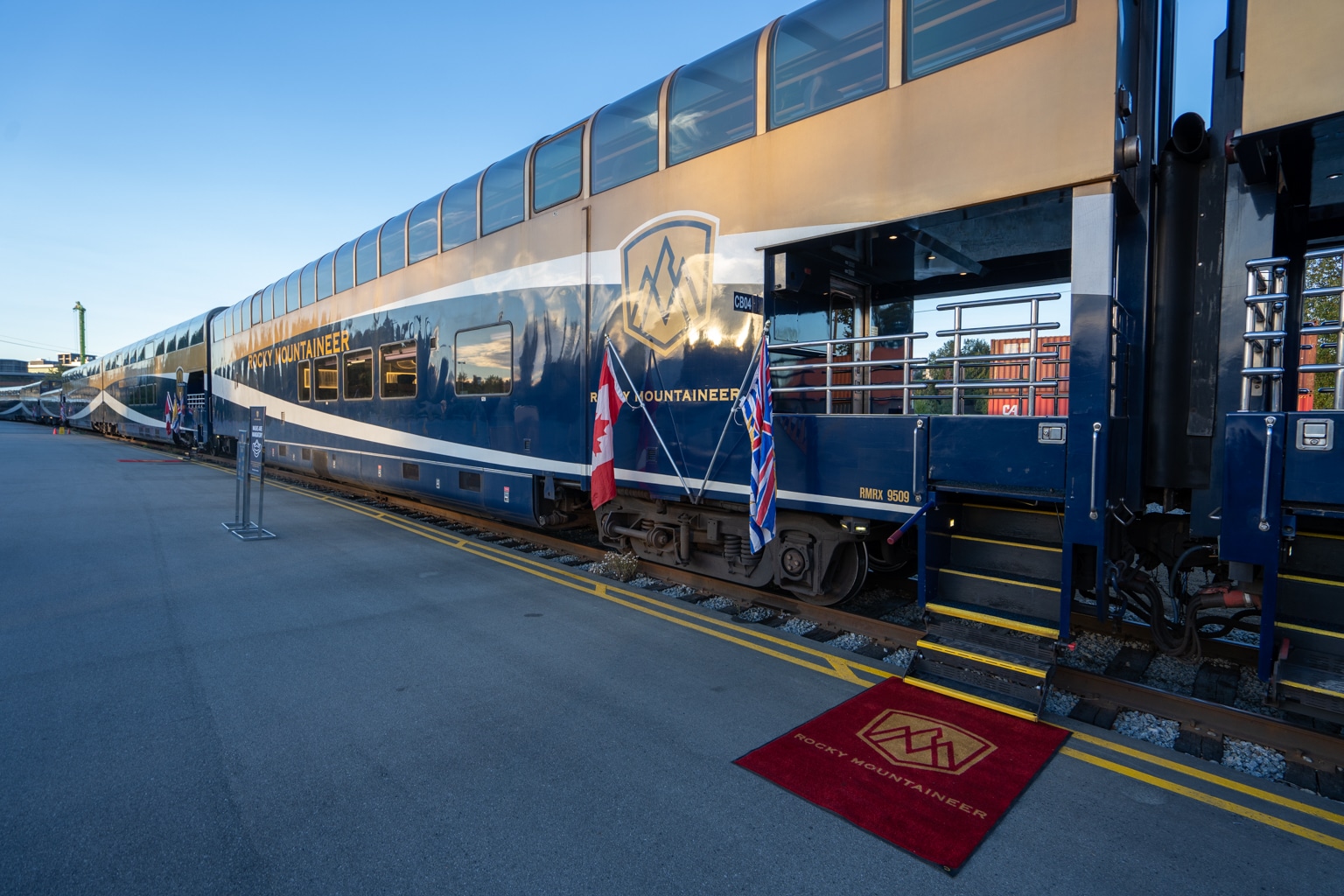
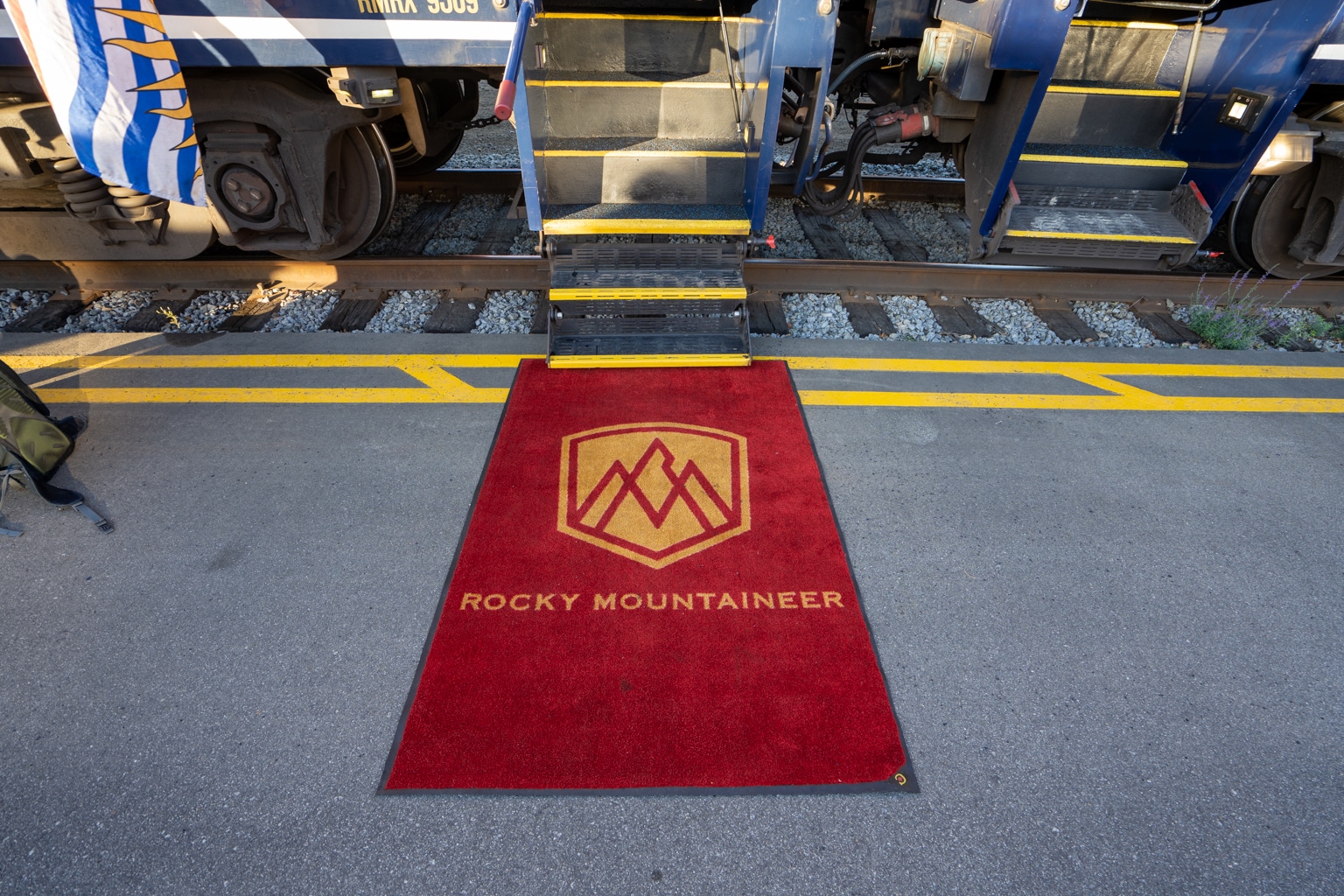
Rocky Mountaineer “First Passage to the West” – Cabin
In the GoldLeaf cabin, the lower deck plays host to the dining car, where passengers go for their meals. The upper deck is the viewing cabin, accessible by a set of curved stairs.
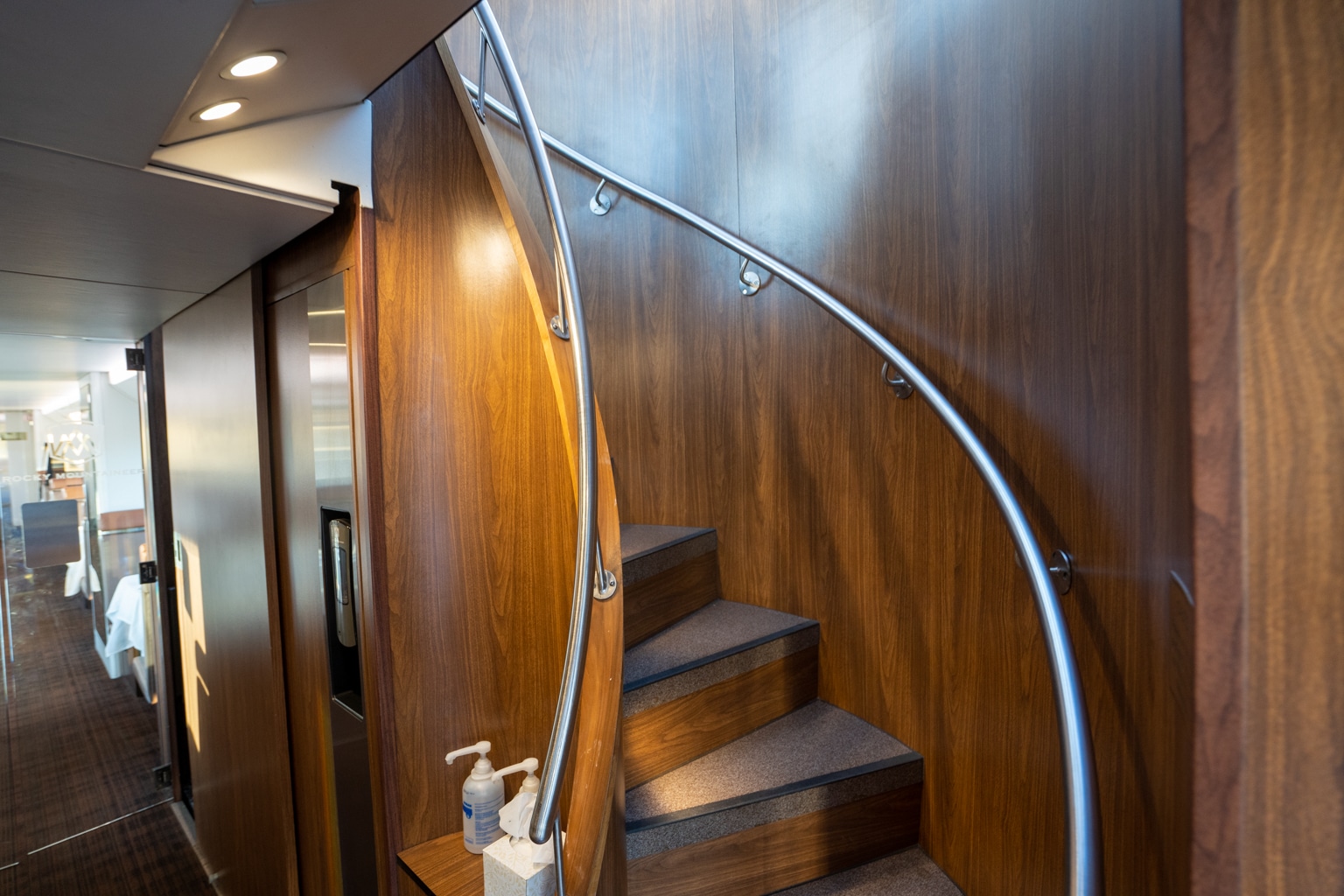
The interior of the upper cabin has an ultra-modern appearance. It’s sleek and clean, with a full glass dome ceiling providing crisp, uninterrupted views.
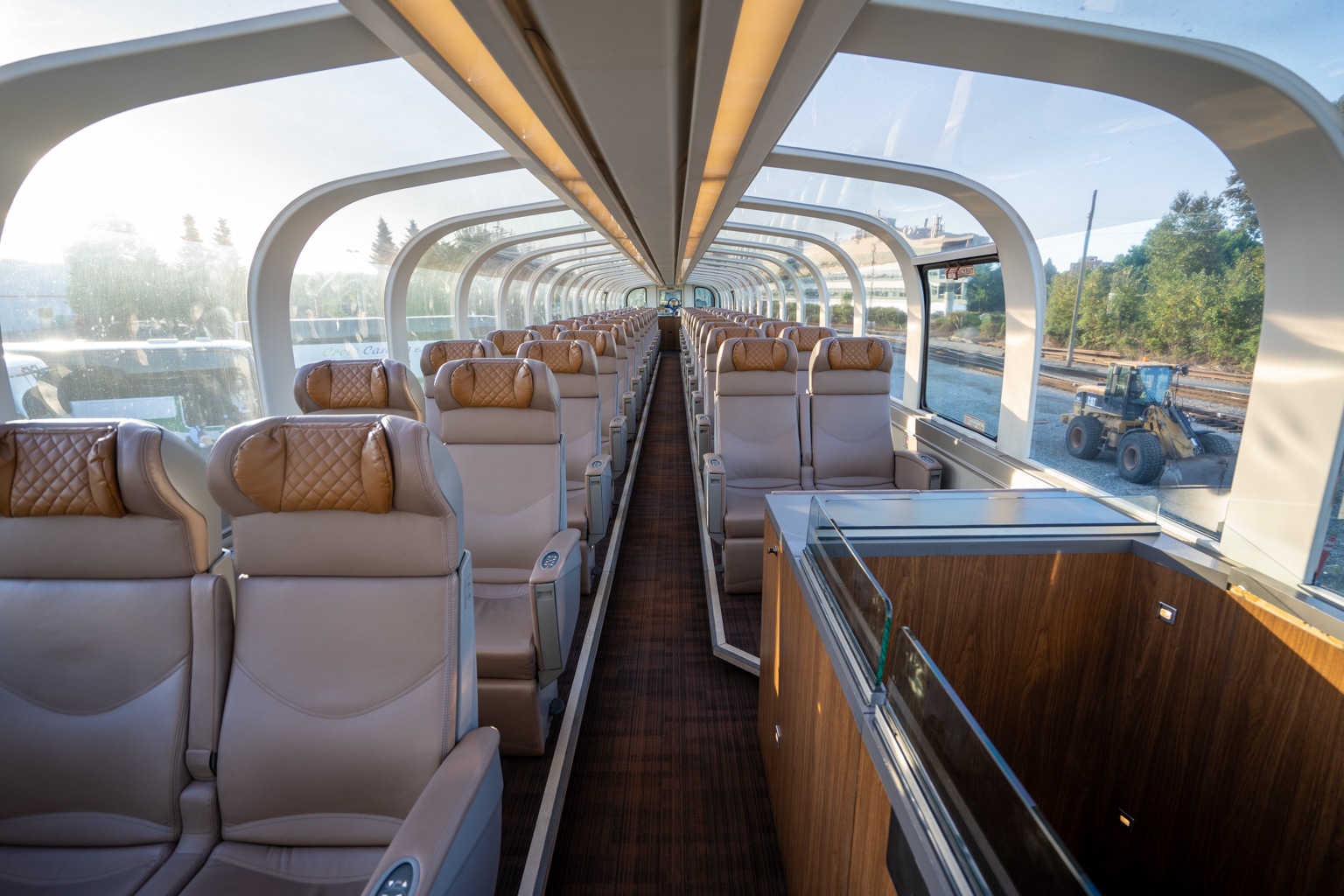

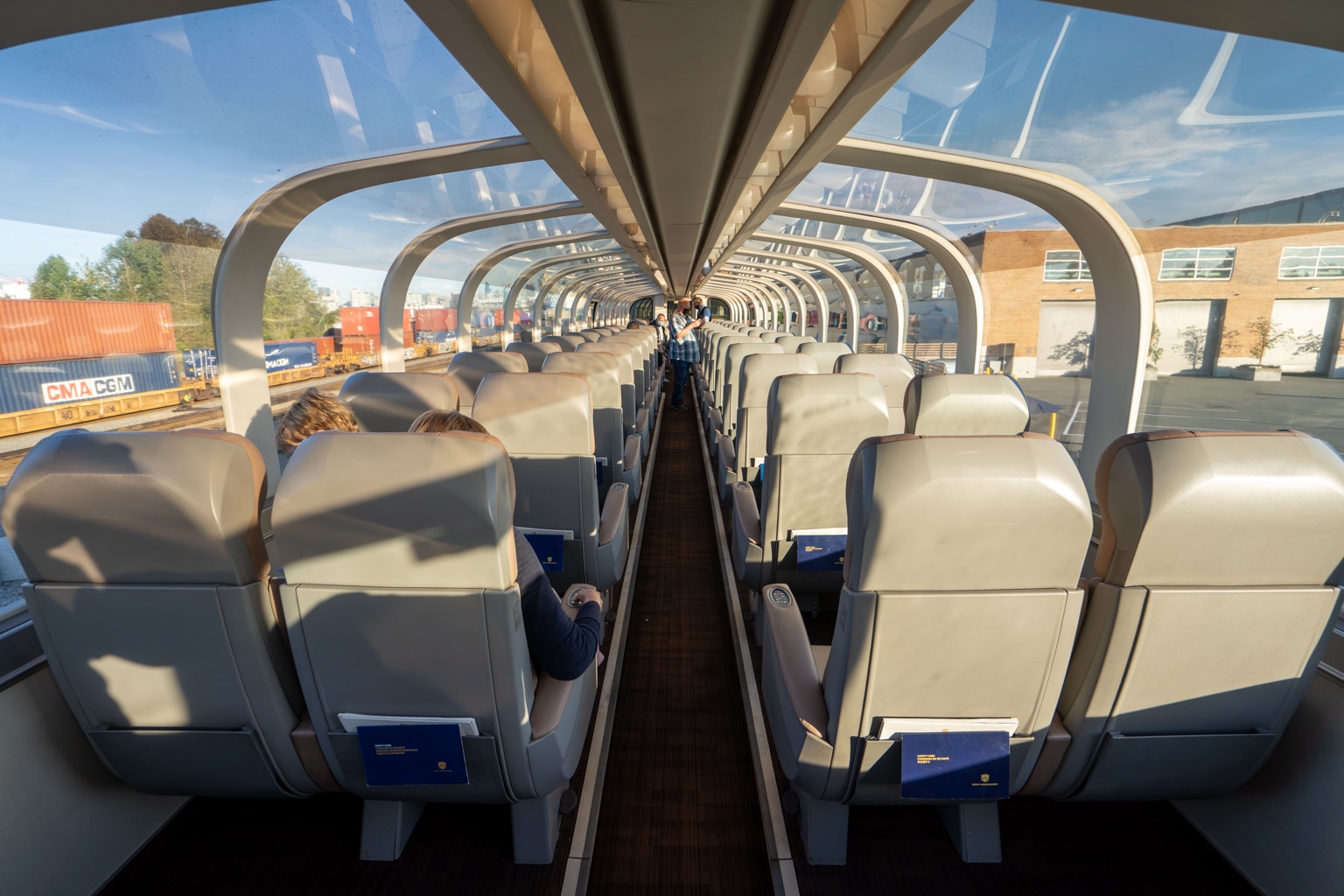
The cabin has a soft natural colour palette, with leather-lined seats and touches of wooden elements.
This upper-level viewing cabin is where drinks and snacks are served, and is also where passengers pass the time during the day. At the far end of the viewing deck is a galley area, where the staff gather to prepare drinks and snacks.
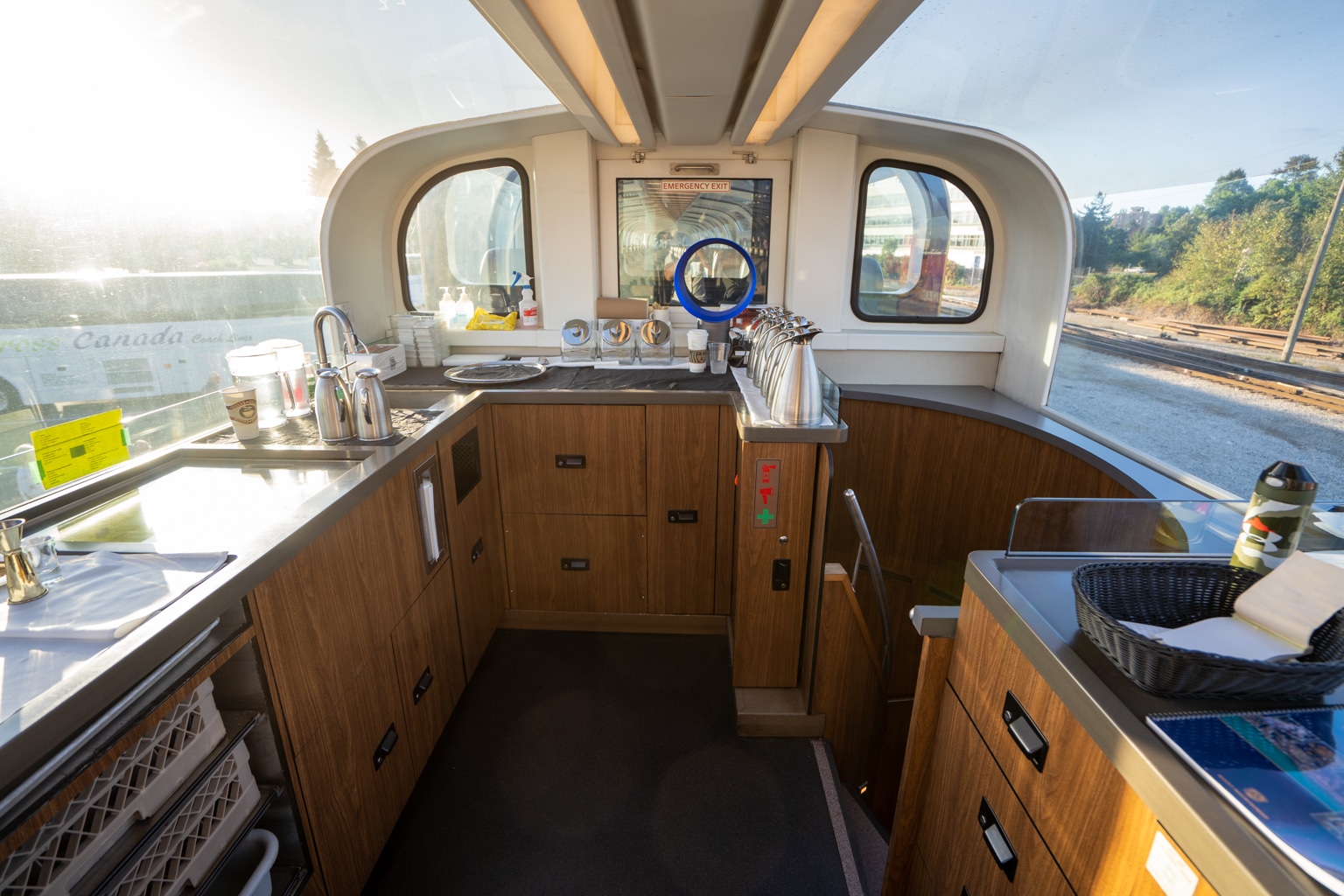
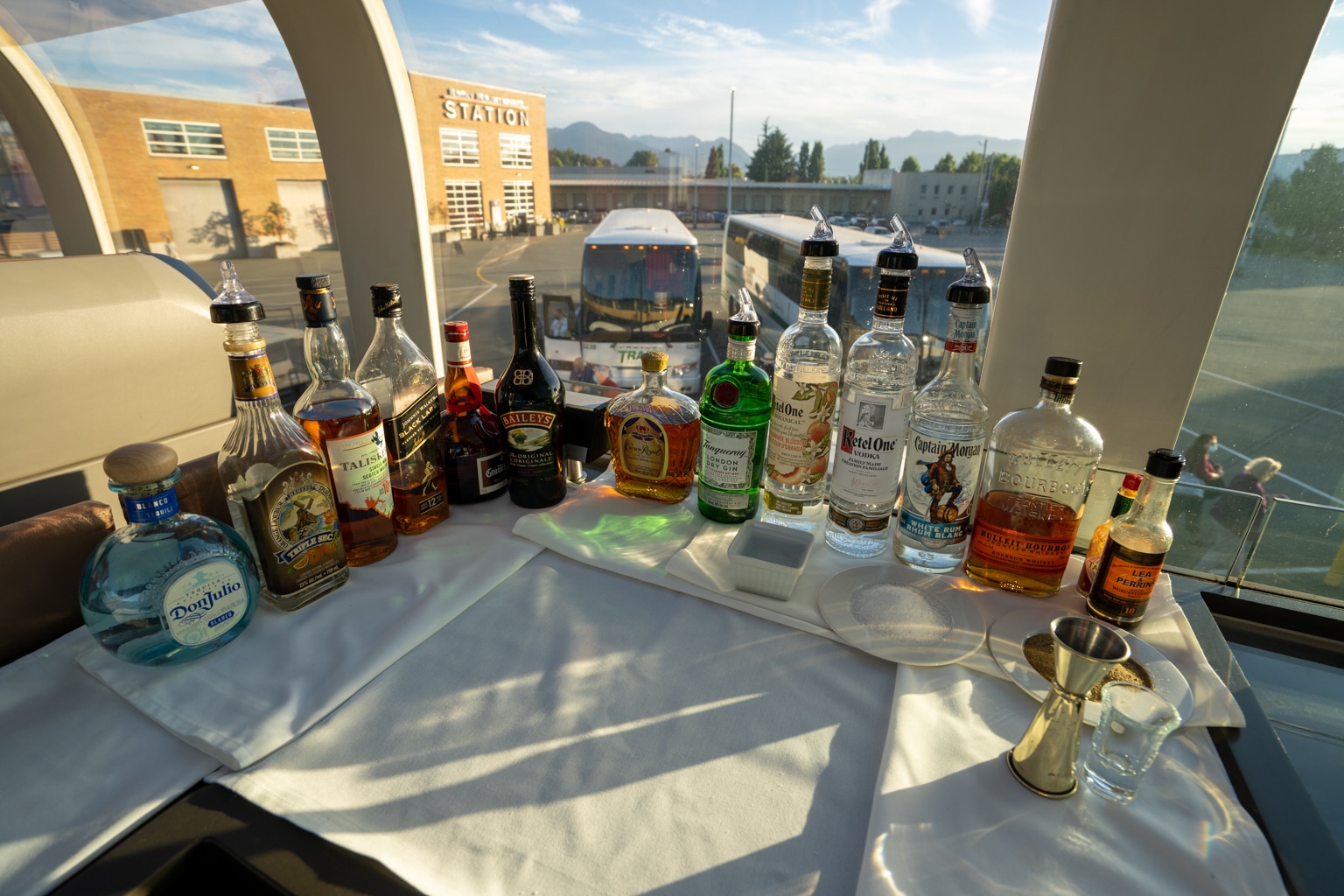
The GoldLeaf cabin is arranged in a 2-2 configuration across 18 rows, and can accommodate up to 72 guests.
Couples travelling together are usually seated together. If you’re travelling alone, you’ll most likely be seated next to a stranger.
Keep in mind that luxury train journeys are typically a social affair, and you’re encouraged to socialize with other guests whether you’re up in the viewing deck or down below in the dining car.
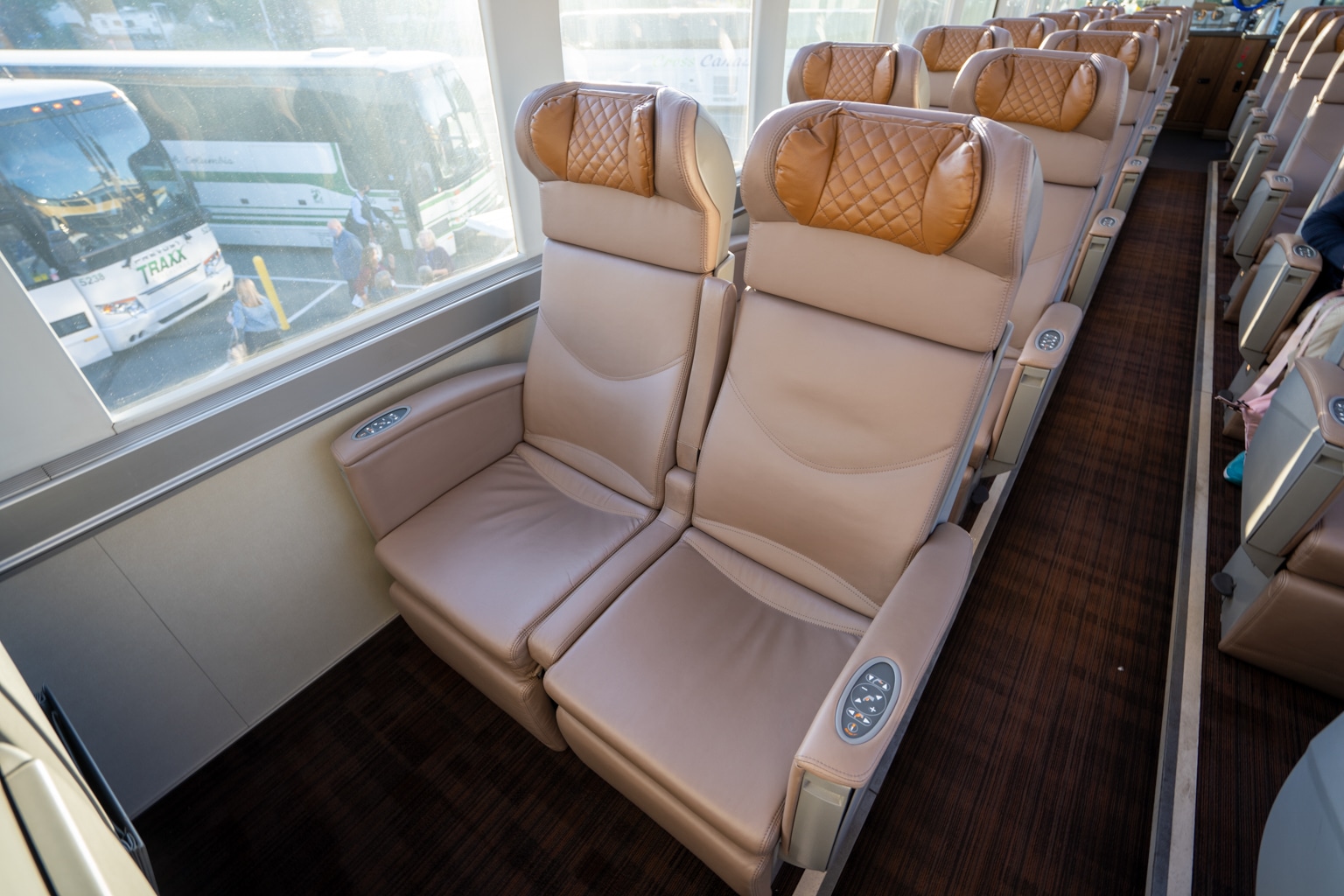
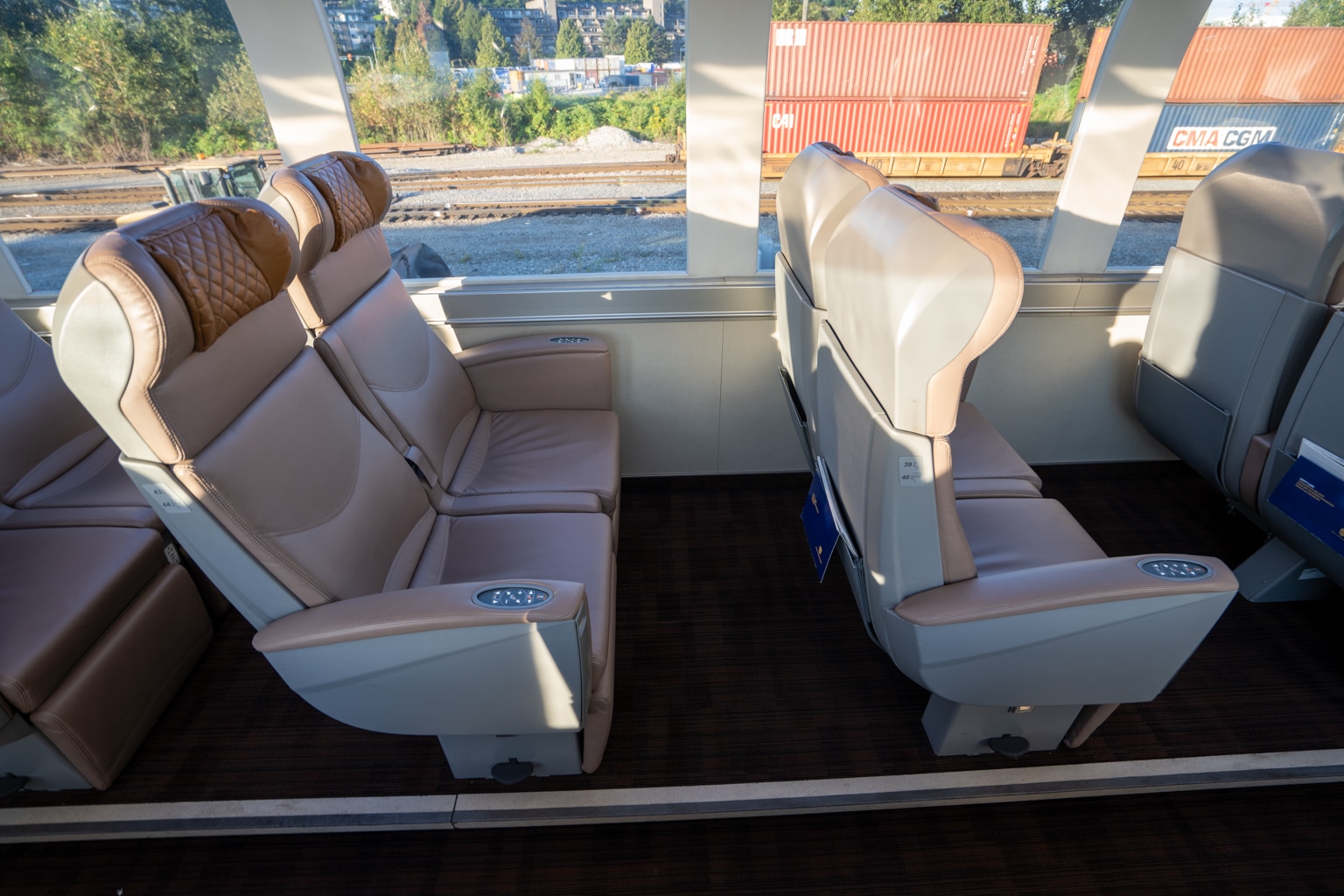
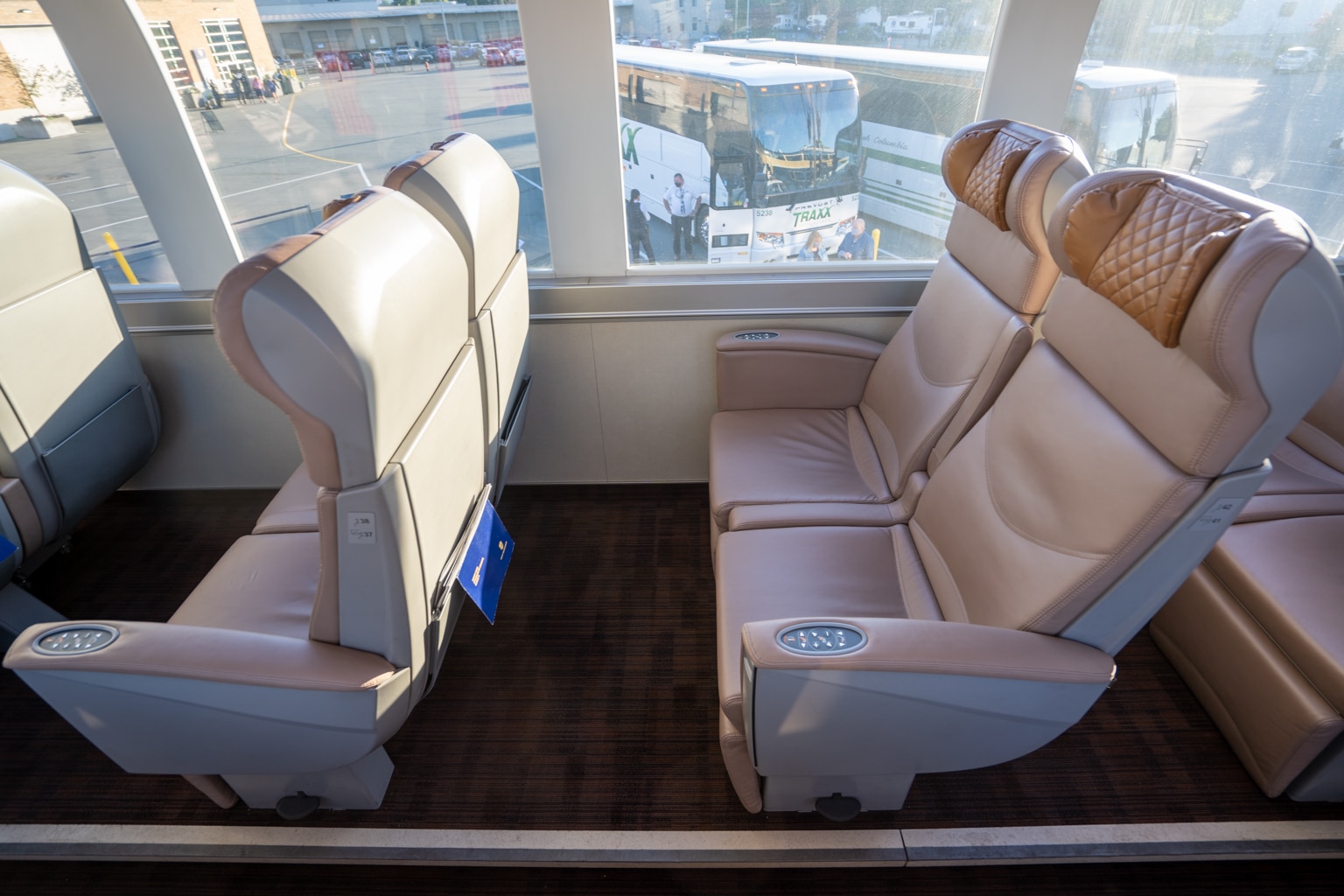
The GoldLeaf cabin’s true highlight is the viewing deck, with its expansive glass ceiling windows that offer panoramic views of the passing scenery.

Rocky Mountaineer “First Passage to the West” – Seat
The leather seats onboard Rocky Mountaineer’s GoldLeaf cabin are reasonably comfortable. I’d say they’re comparable to an airplane’s premium economy seats.

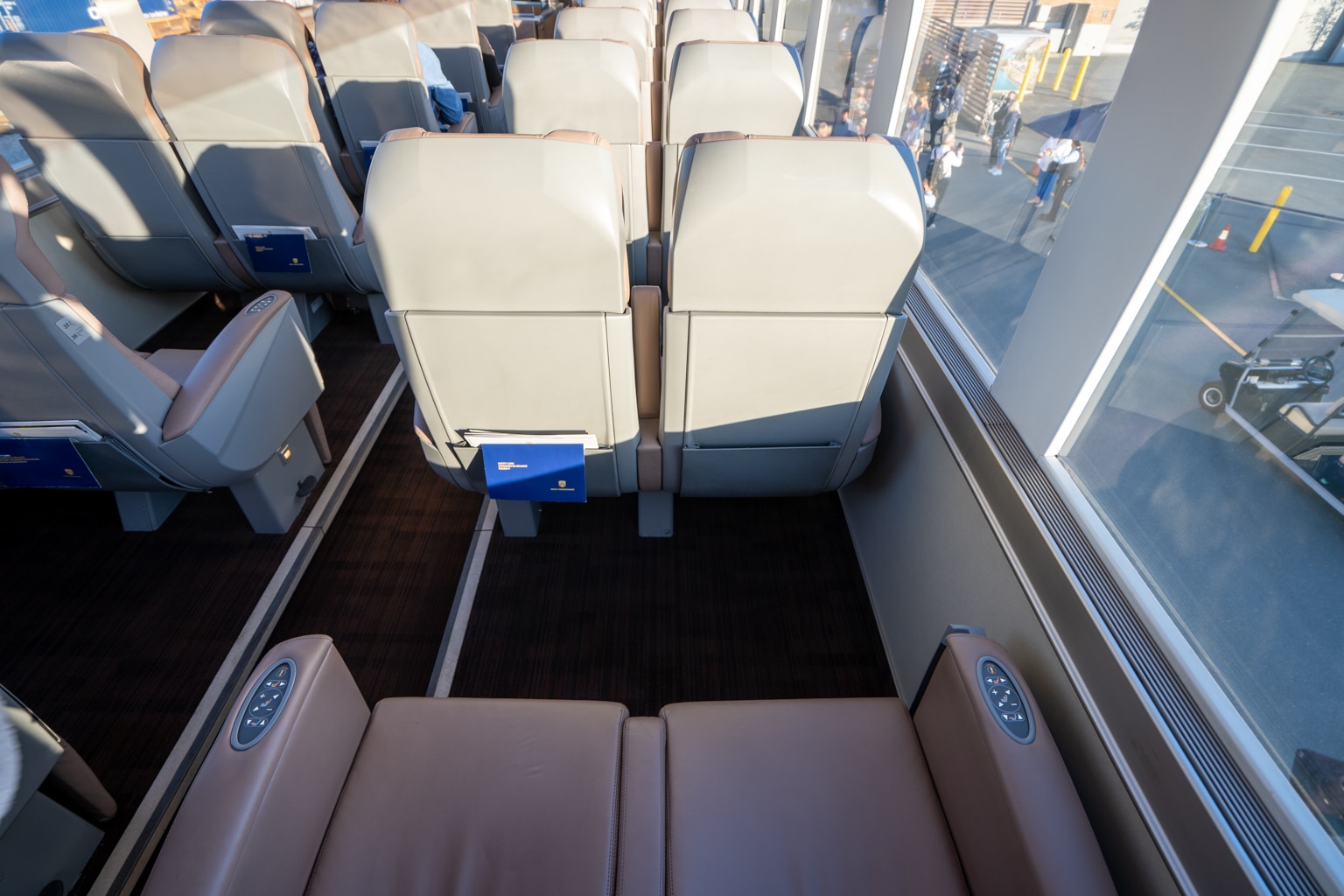
Navigating the seat is quite simple, as controls are located on the seat’s armrest to fine-tune your seat’s position. Here, you can adjust the seat’s angle, recline, footrest, and temperature.
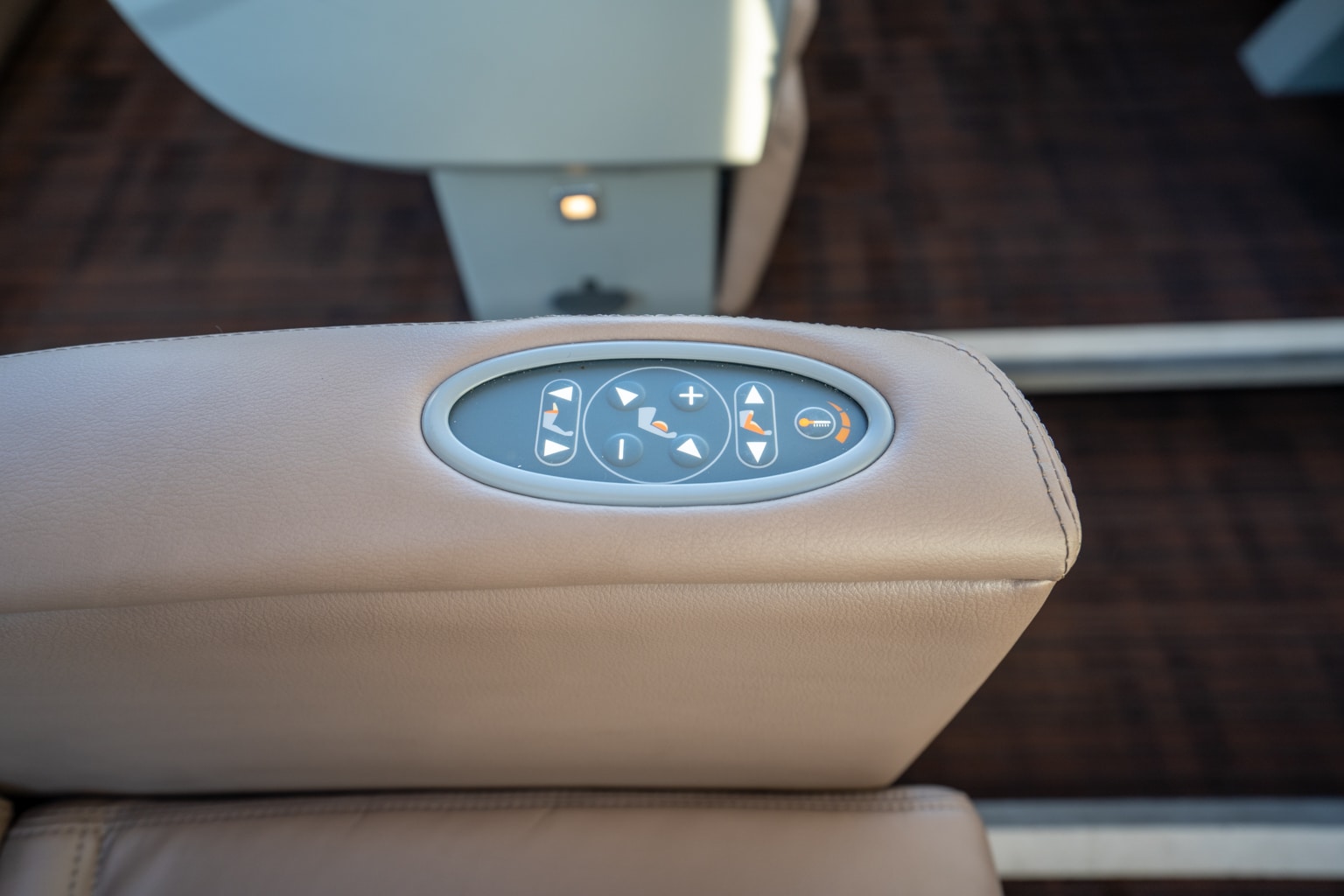
The GoldLeaf cabin seats allow you to recline a fair bit, which is a feature you won’t find in the seats of the SilverLeaf cabin.
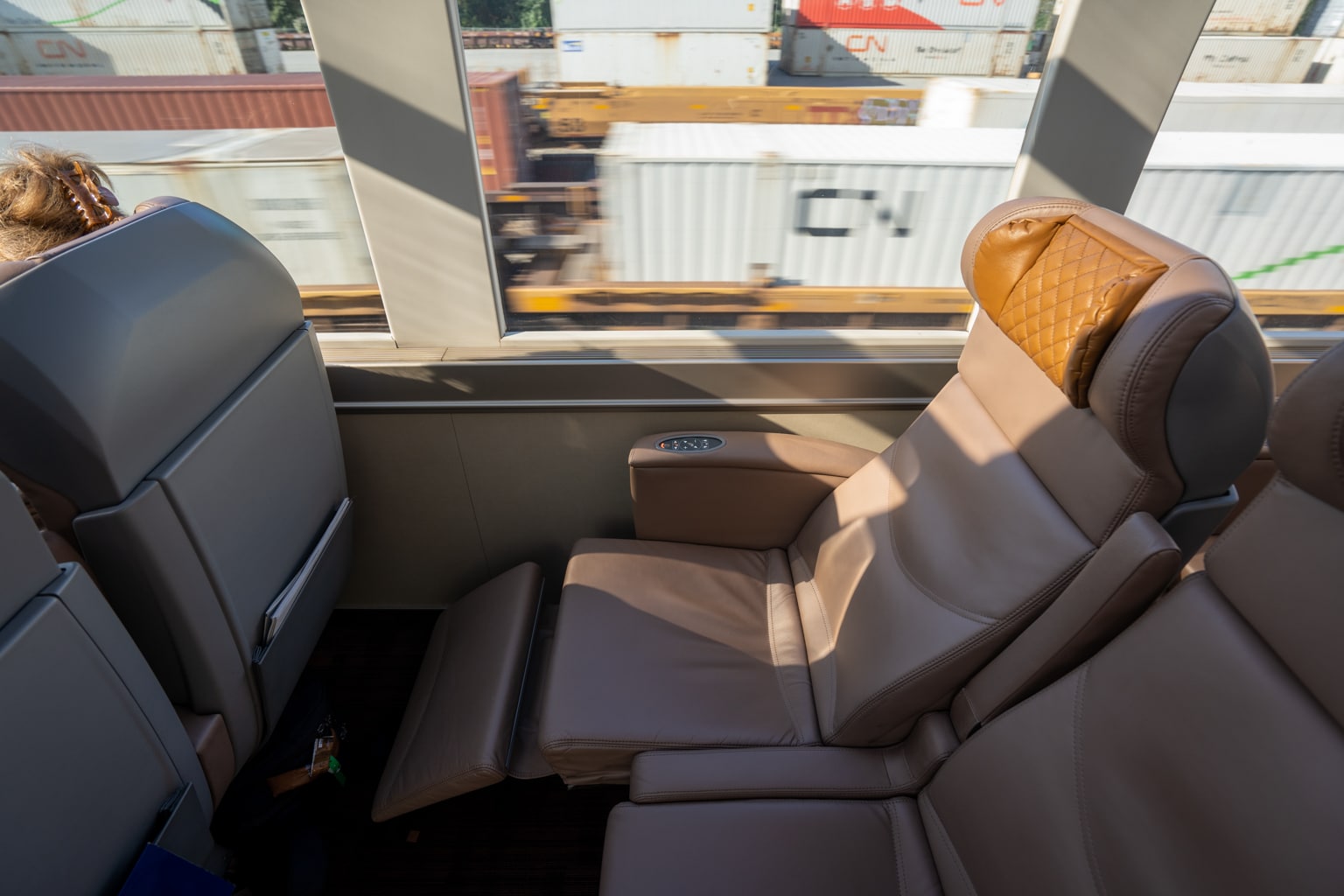
Built-in seat warmers keep the seat toasty and cozy, as the air conditioning is cranked on at the beginning of the train ride to keep the cabin from overheating later. Thus, the seat warmer comes in quite handy in the mornings.
Should you need a bit of storage space, there is a pocket in the back of the seat in front of you, and some space below that seat.

A tray table pops directly forwards from the armrests, and then rotates upwards and then downwards along another axis into place. There’s enough space for a snack and drink, but more fulsome meals are consumed downstairs.

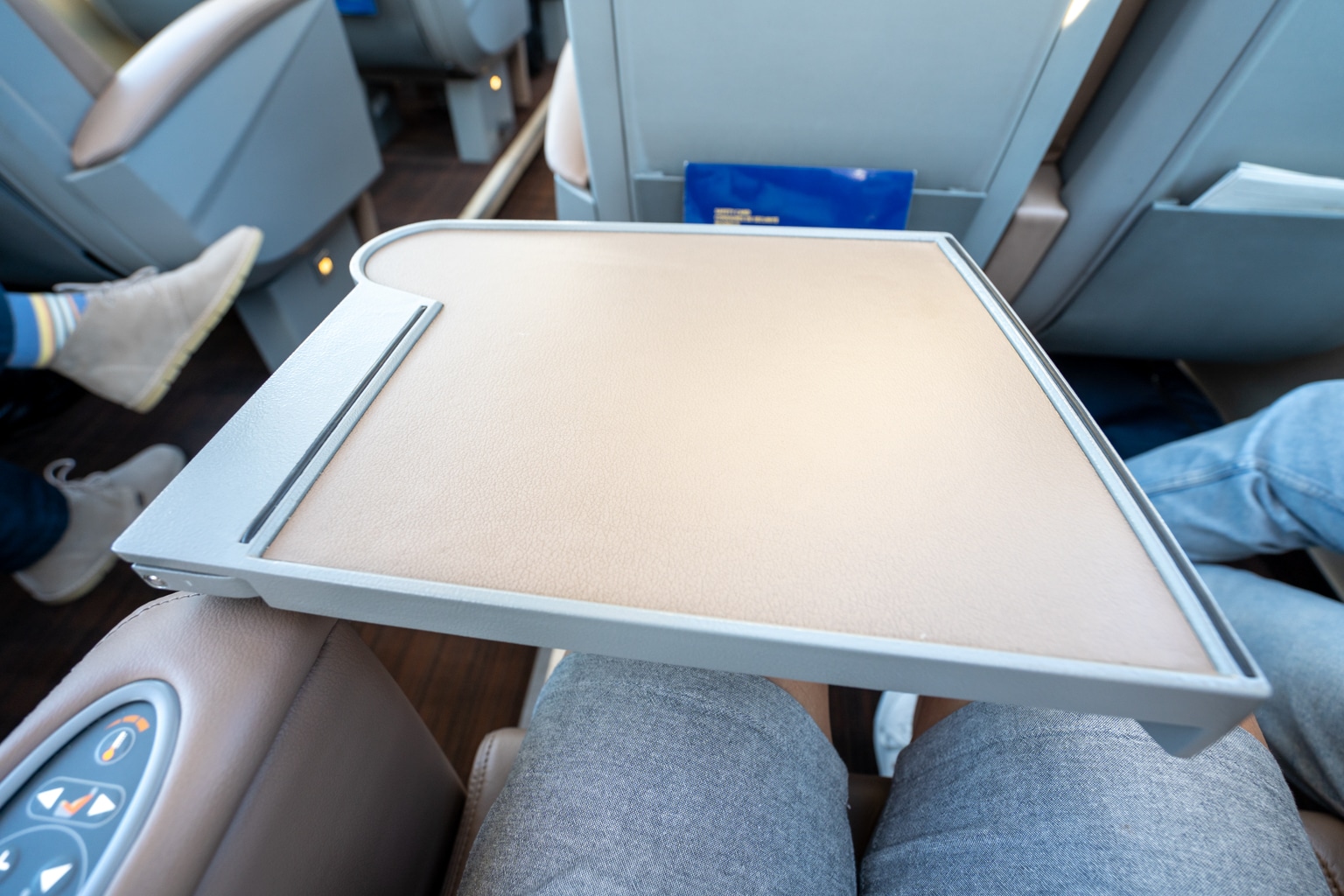
Rocky Mountaineer “First Passage to the West” – Dining Car
Heading back down a set of stairs, an automatic glass door provides access to the dining car. Breakfast and lunch are served on the train on both days, while snacks are provided at your seat.
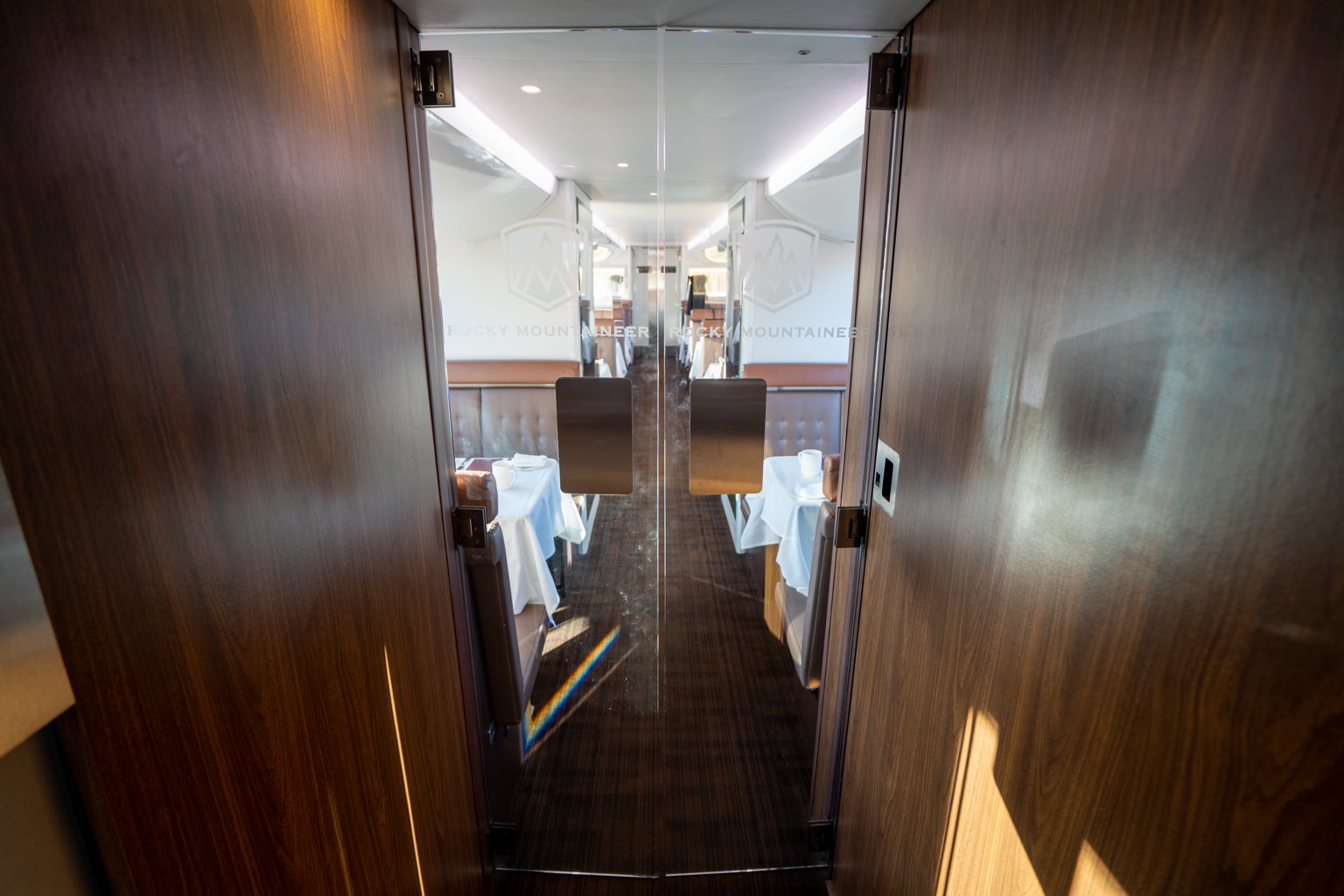
There are more passengers onboard the train than can fit in the dining cart at once. So, passengers are separated into two groups, and are invited to take their meals in two separate intervals.
On the first day, our group was the first to head down for both breakfast and lunch, and then on the second day, we had to wait until the first group finished dining.
If you’re part of the group who has to wait for breakfast, you’ll be treated to a beverage service and freshly baked pastries on the viewing deck while you wait.
The dining car has a handful of two-person and mostly four-person booths, available on a first-come-first-served basis.
If you’re travelling solo or as a pair, you could find yourself seated at a four-person booth, which provides another opportunity to connect and socialize with fellow passengers.
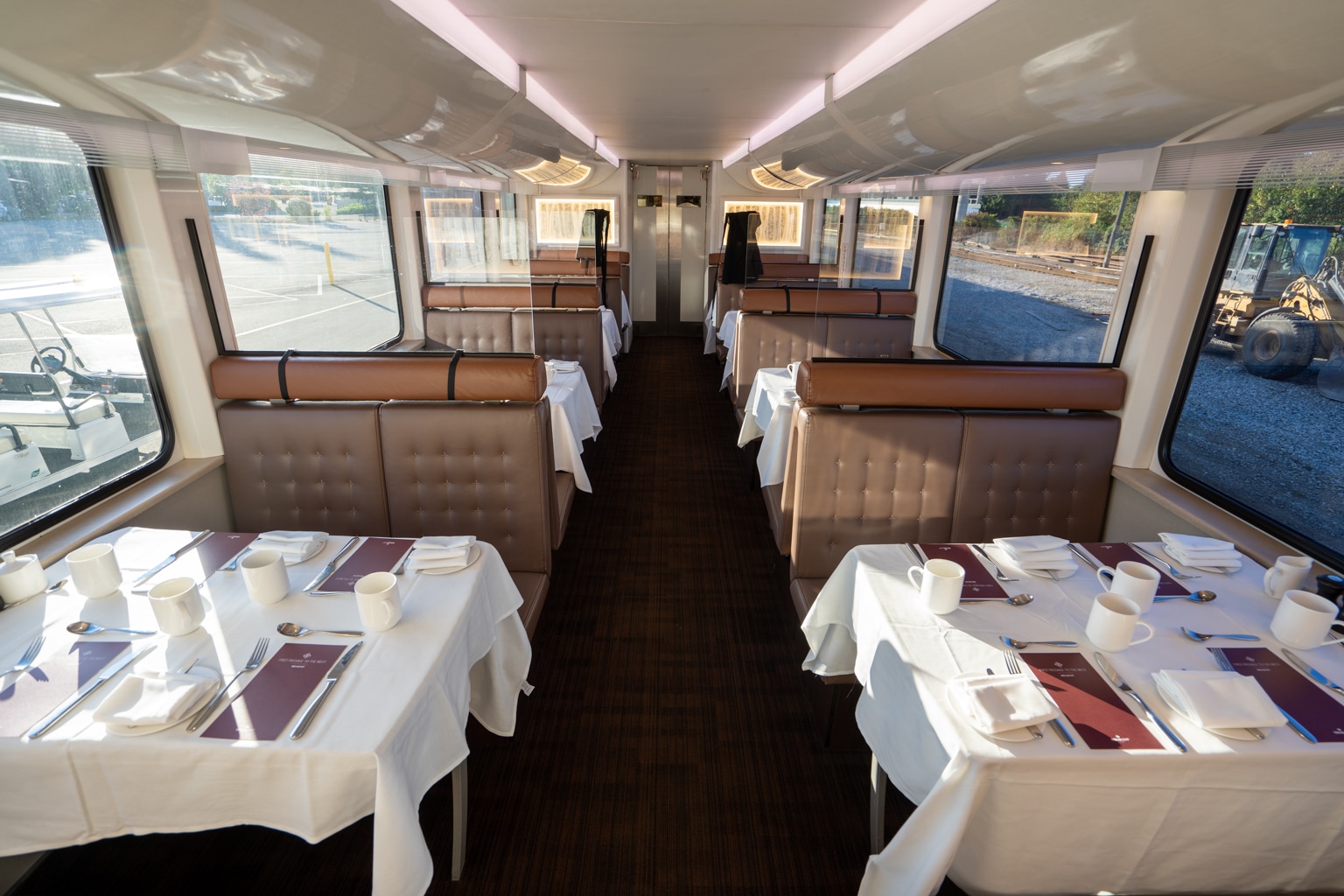

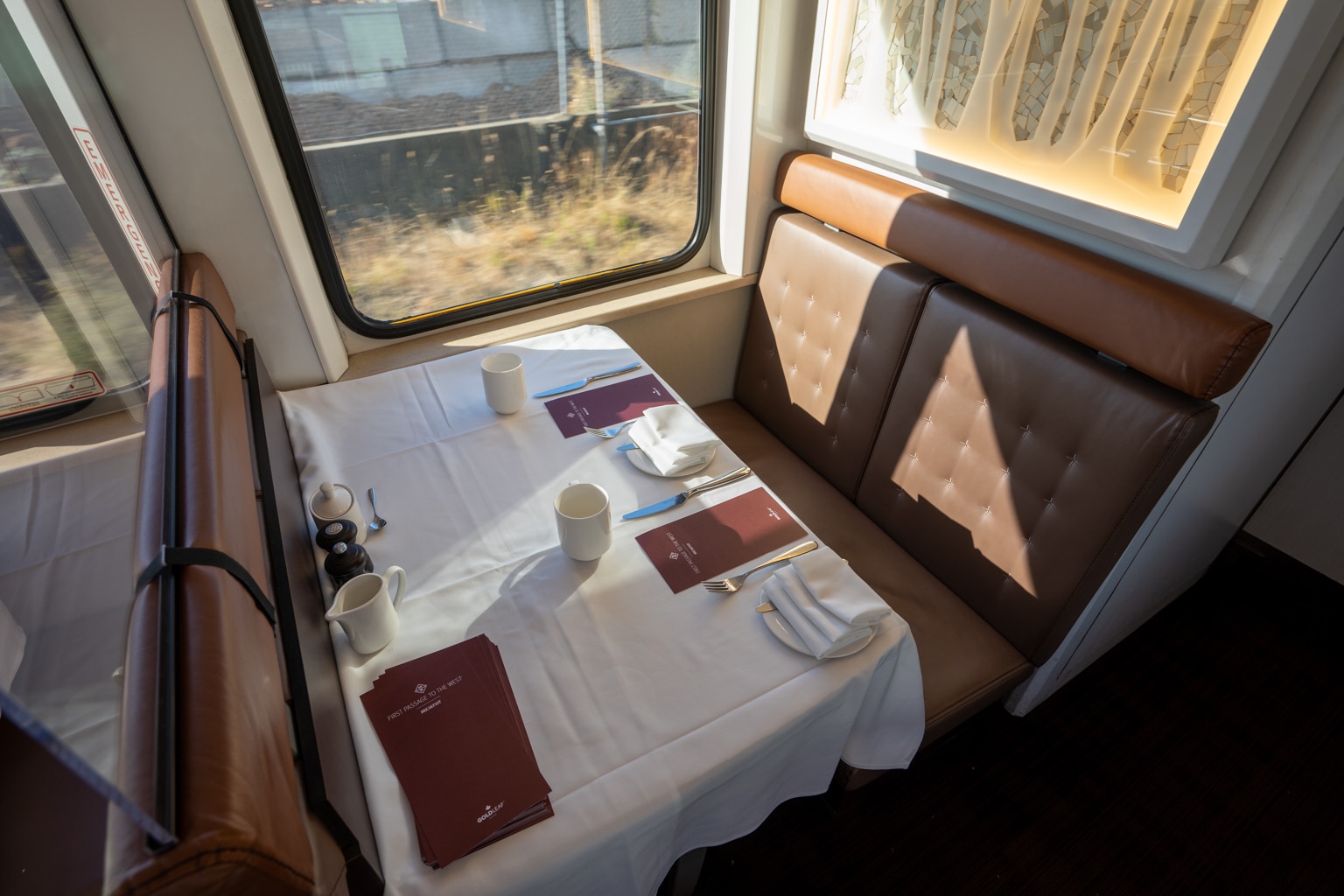
Note that there’s no meal offered for dinner, so if you’re looking for something to eat later in the day, you’re on your own – whether that’s during the intermediate stop in Kamloops or upon arrival in Banff or Lake Louise.
Rocky Mountaineer “First Passage to the West” – Day 1
Shortly after our departure from Vancouver, we headed down for breakfast and sat down with a friendly elderly couple from Australia.

We started with a few fresh croissants, followed by a very intricately garnished cocktail with strawberries and apple slices in the glass, and a goldenberry at the top.
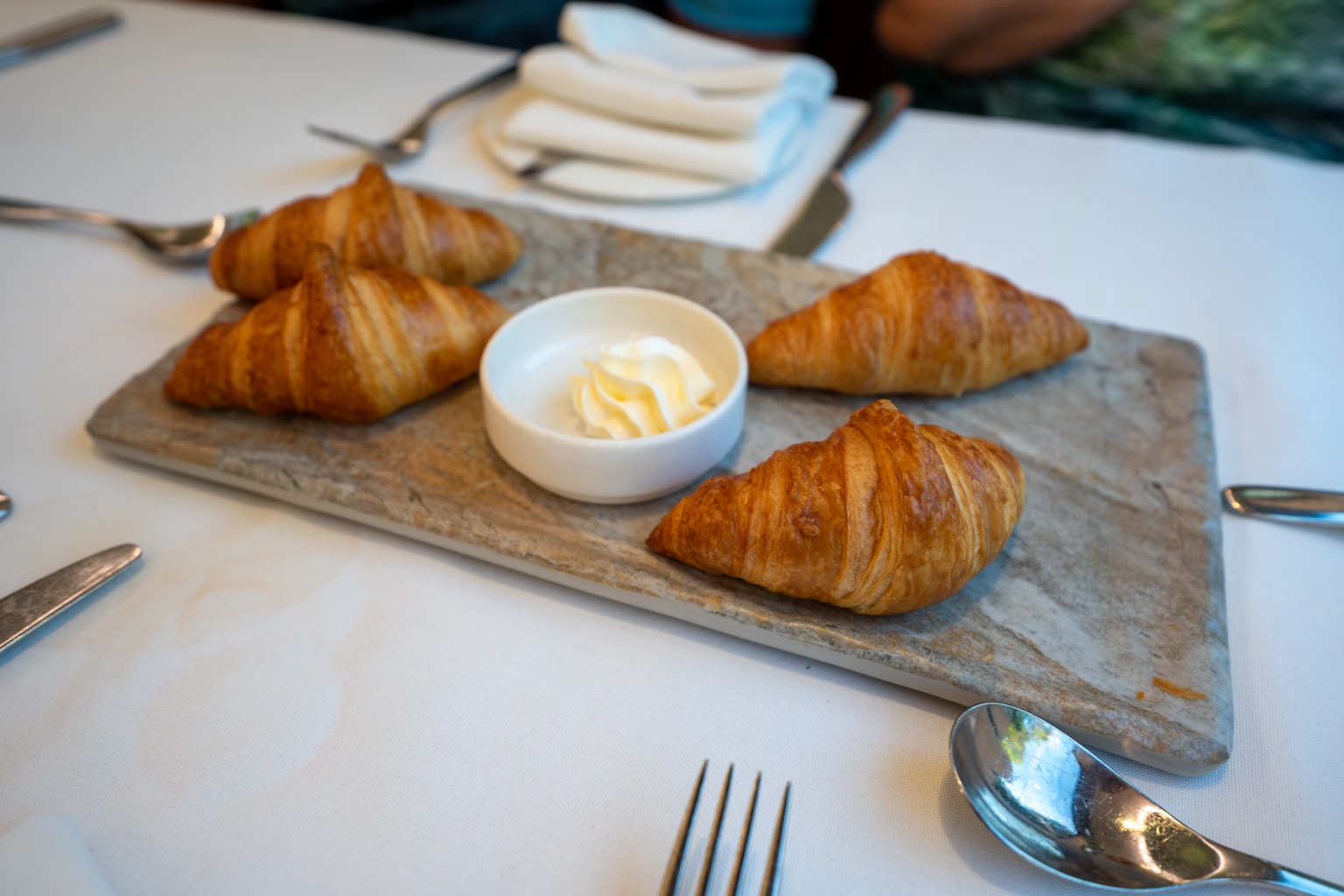
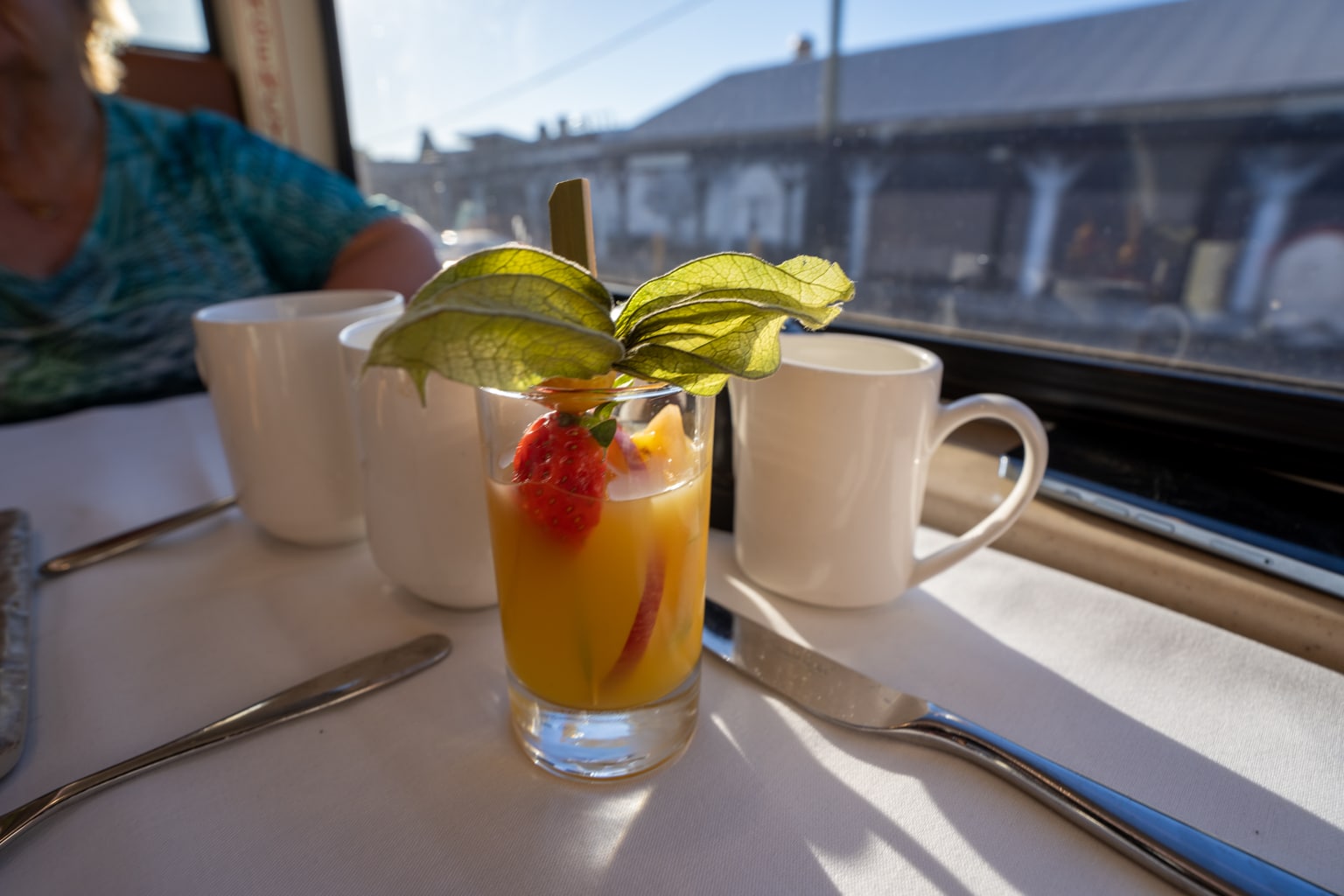
I ordered the Shuswap bacon breakfast skillet, which was a bowl of soft sunny side up eggs over crispy bacon, tender mushrooms, roasted tomatoes, and baked potatoes.

Meanwhile, Jessy ordered the Eggs Benedict, which came with hollandaise sauce poured over sizzling bacon and tender salmon, as well as tossed arugula and crunchy home potatoes on the side.
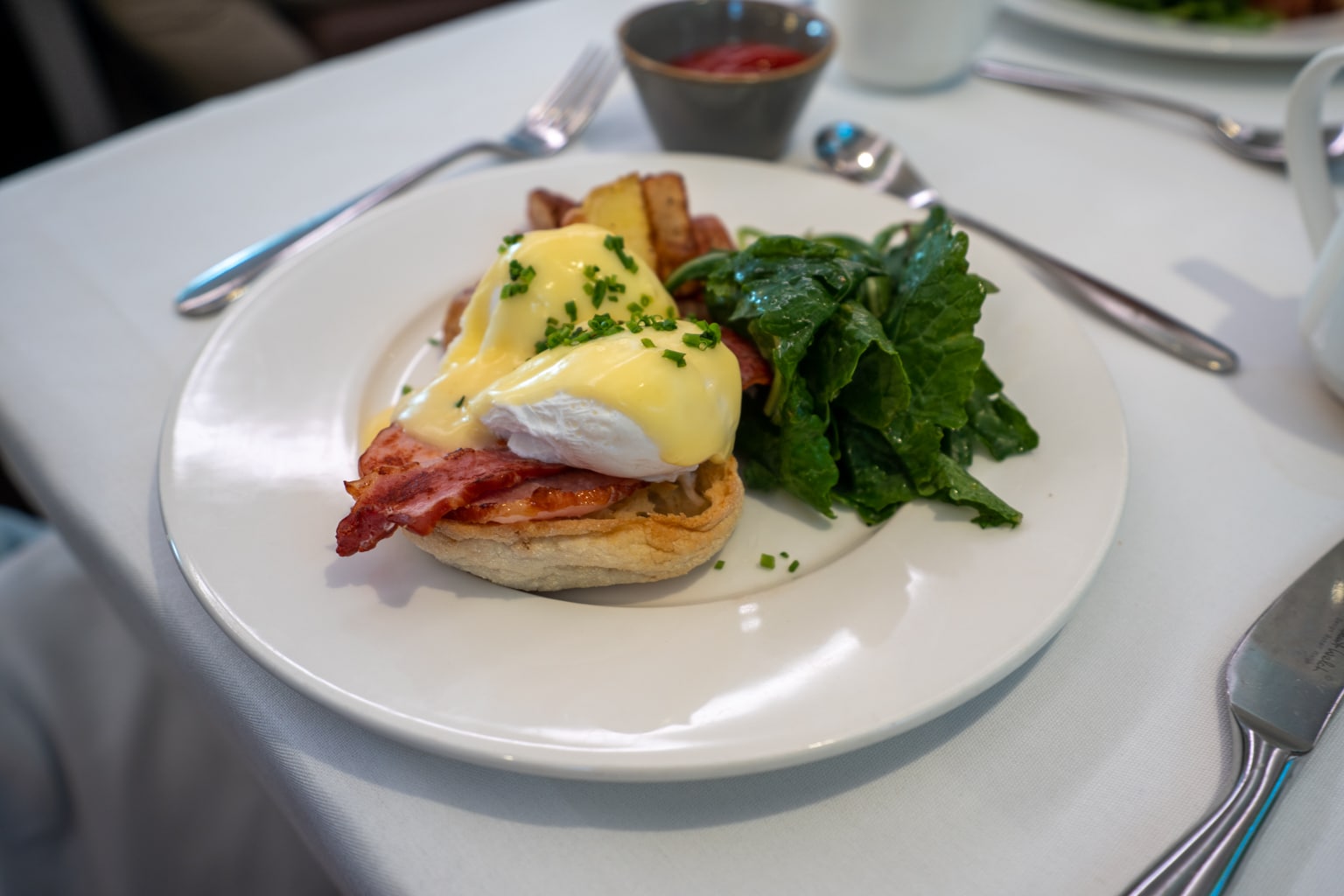
Both breakfast dishes were delightful, well-prepared, and very much befitting of the GoldLeaf cabin. They were a step above what you might expect on a train, and I was impressed with the kitchen staff’s ability to prepare meals of such quality onboard a moving carriage.
I’d compare the overall dining experience onboard Rocky Mountaineer to somewhere in-between business class and First Class, although not quite at the level of first-rate dining on the ground.
After breakfast, it was time for drinks back at our seat, where I helped myself to some hot chocolate and some snacks that were handed out. It was still before noon, so I didn’t get started on the alcoholic drinks quite yet.
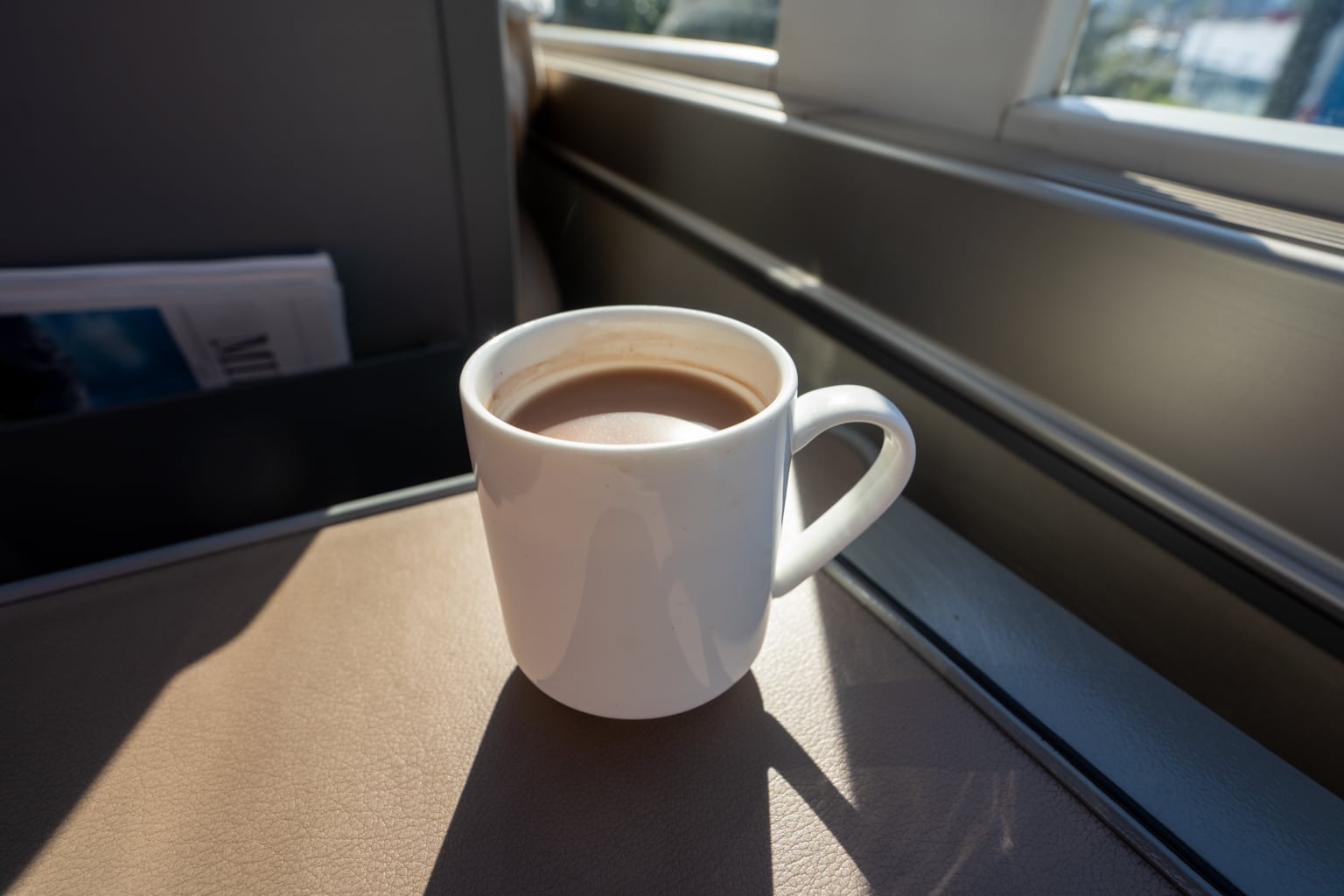
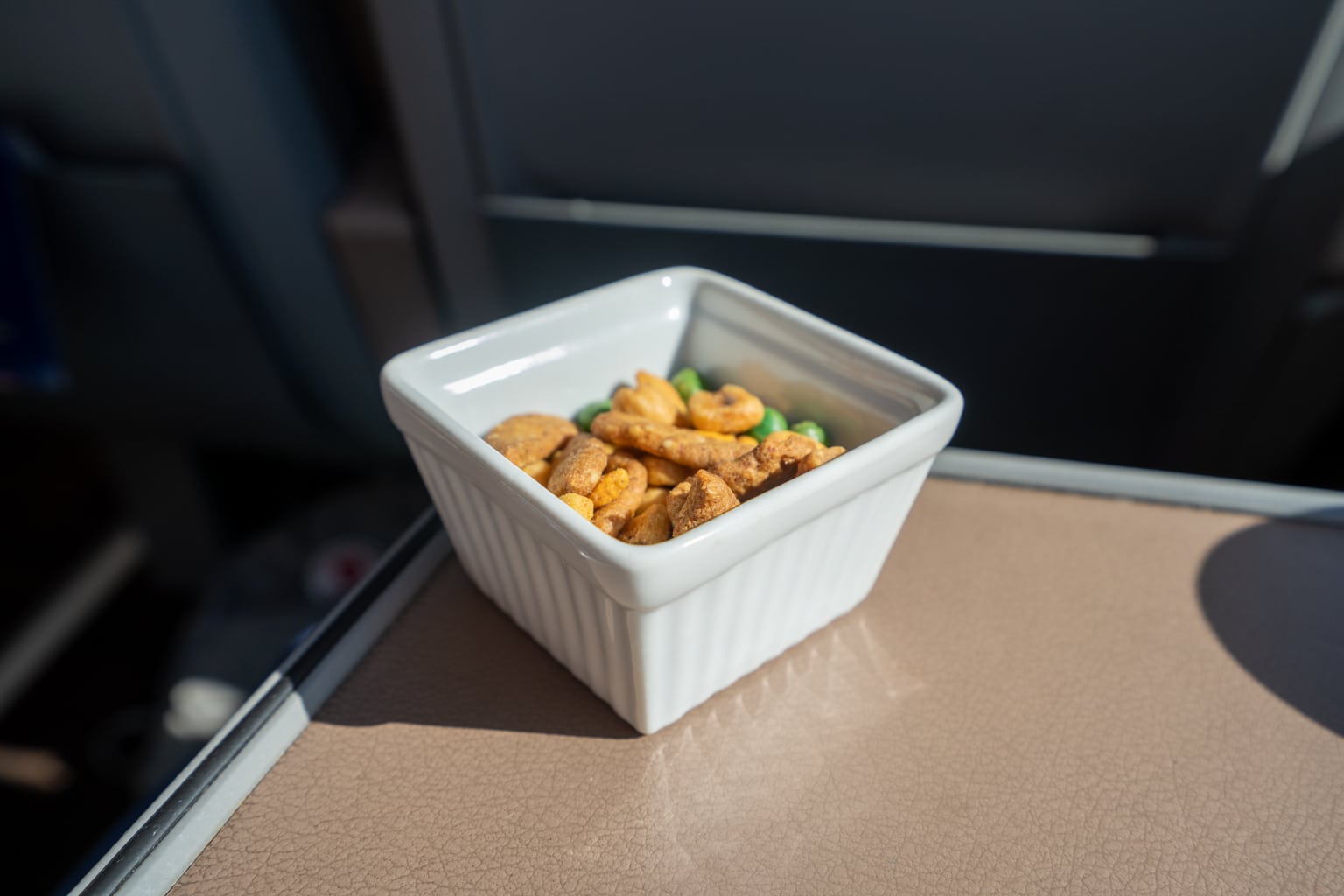
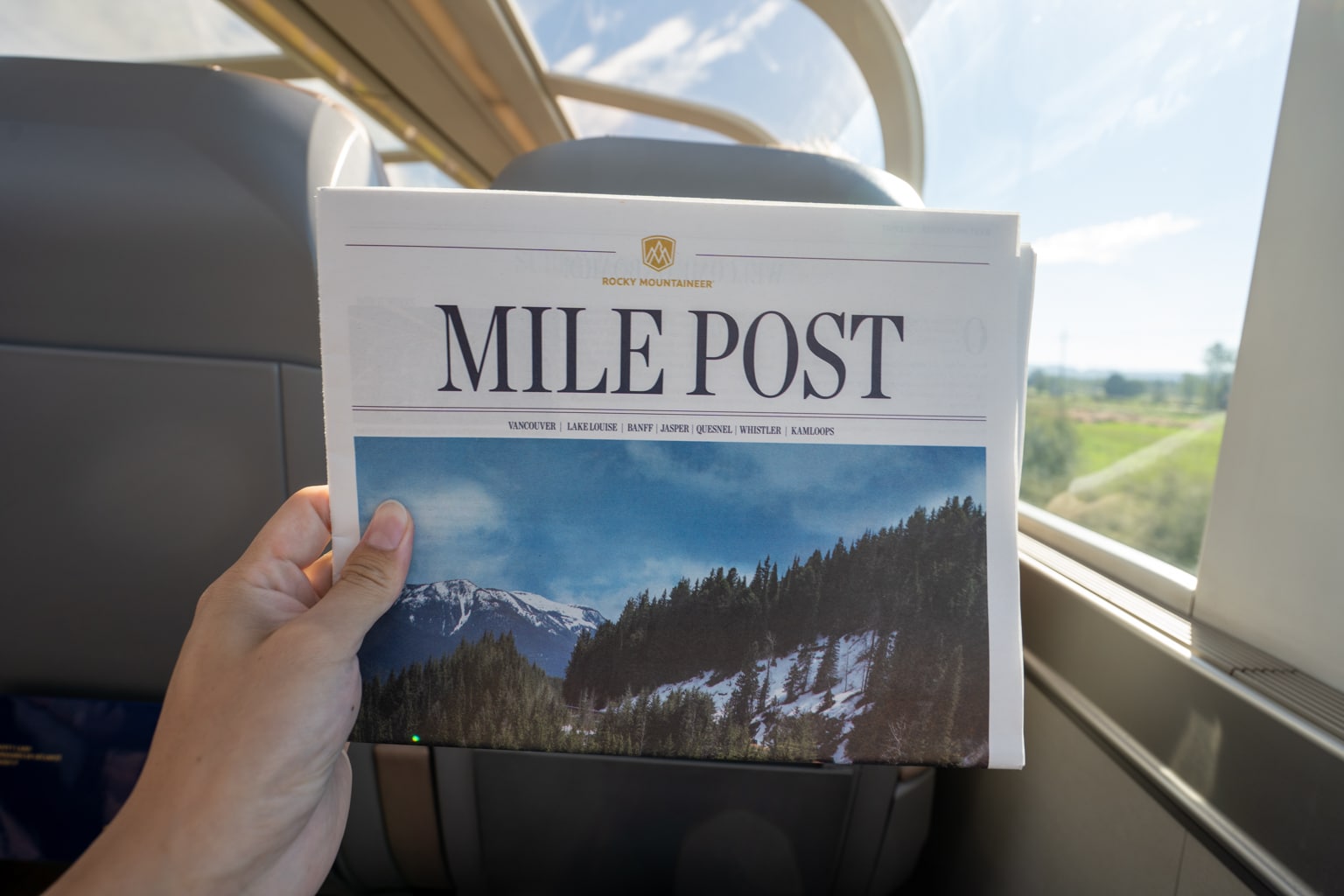
To be honest, there isn’t all too much to do while on the train, which we quickly discovered as we made our way north through British Columbia. Aside from drinking and taking in the views, we occasionally went downstairs to the outdoor vestibule for a breath of fresh air.
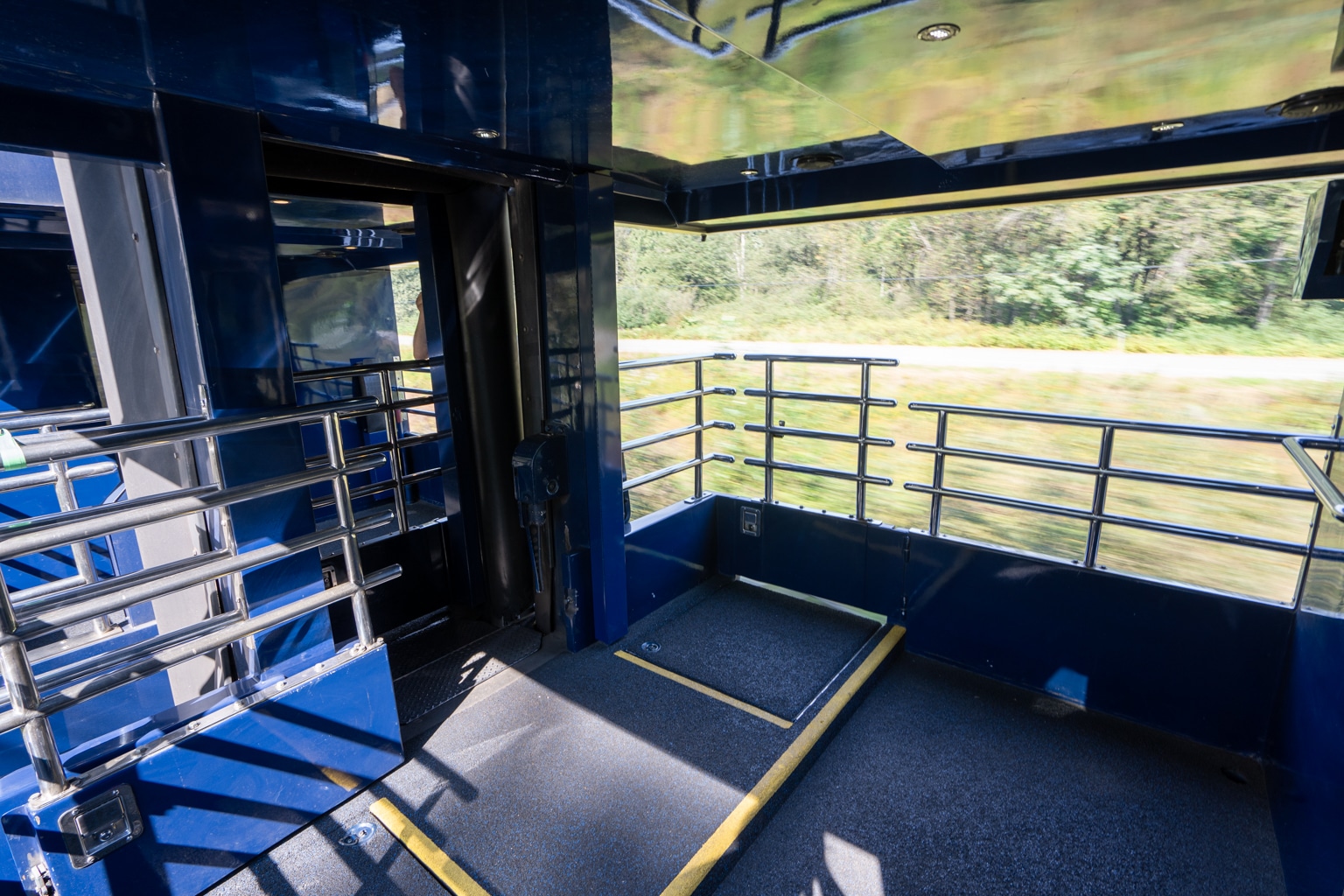

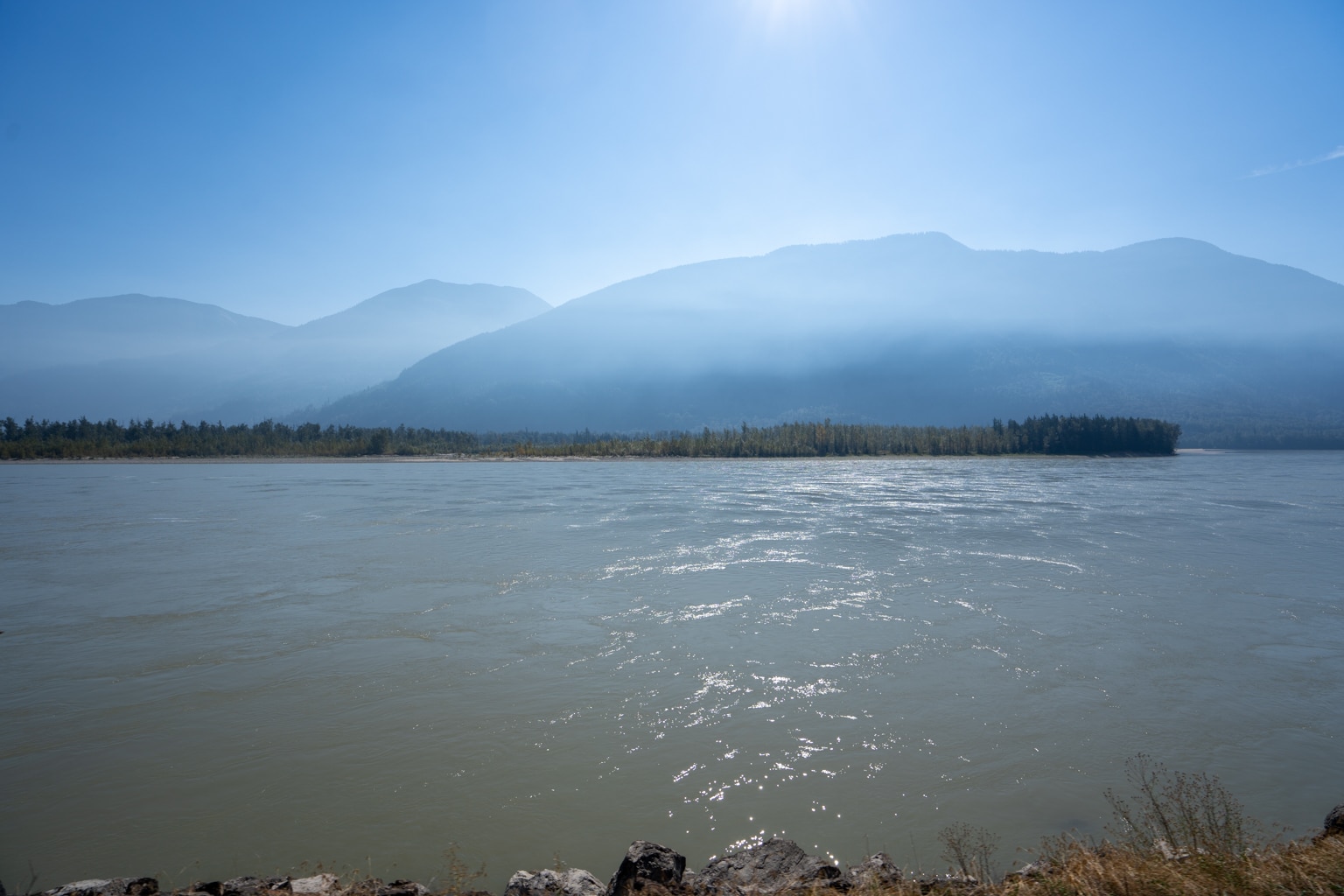
Eventually, we switched our hot chocolate out for gin sodas, and continued to take in the views of the forests and fields of the Fraser Valley.
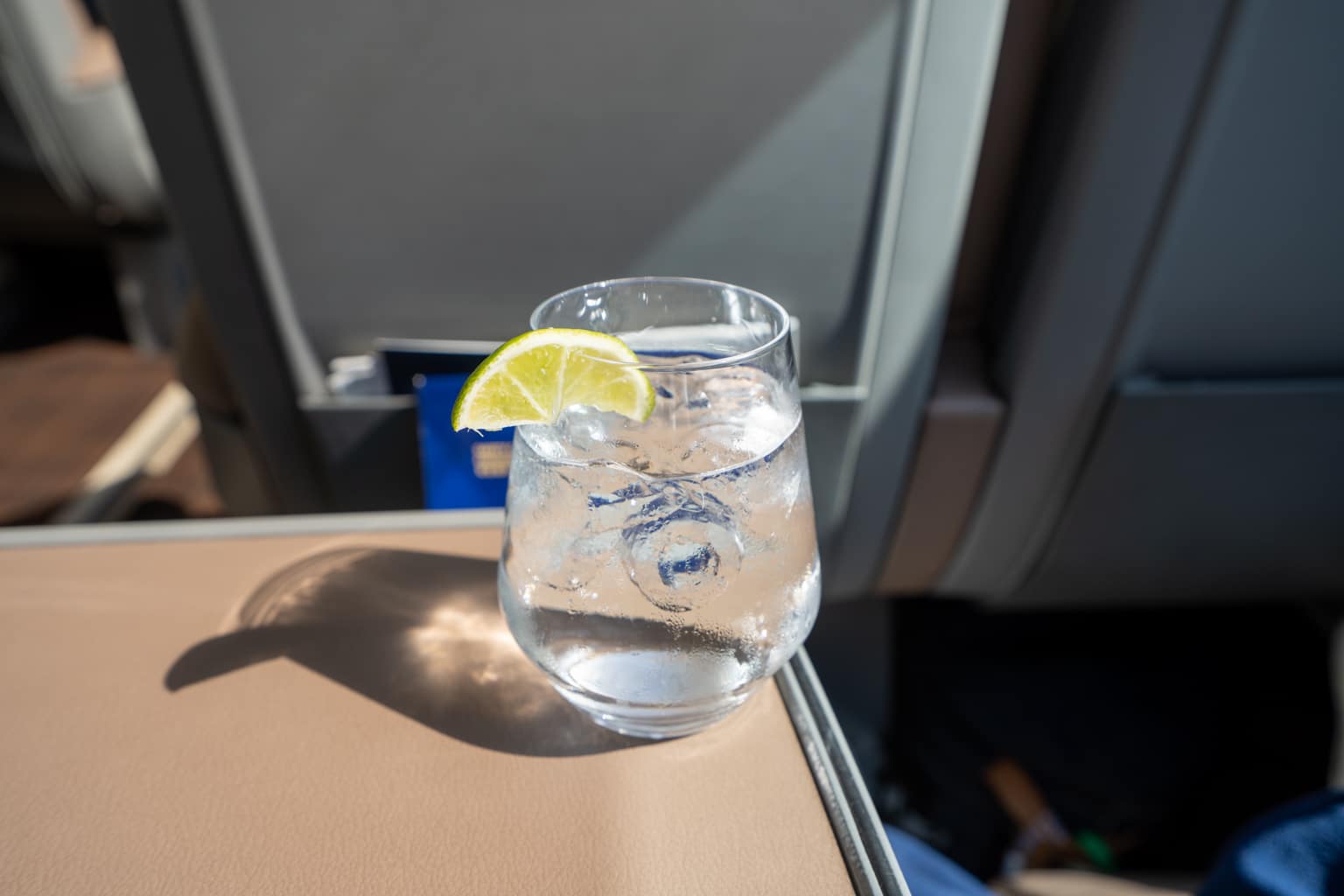
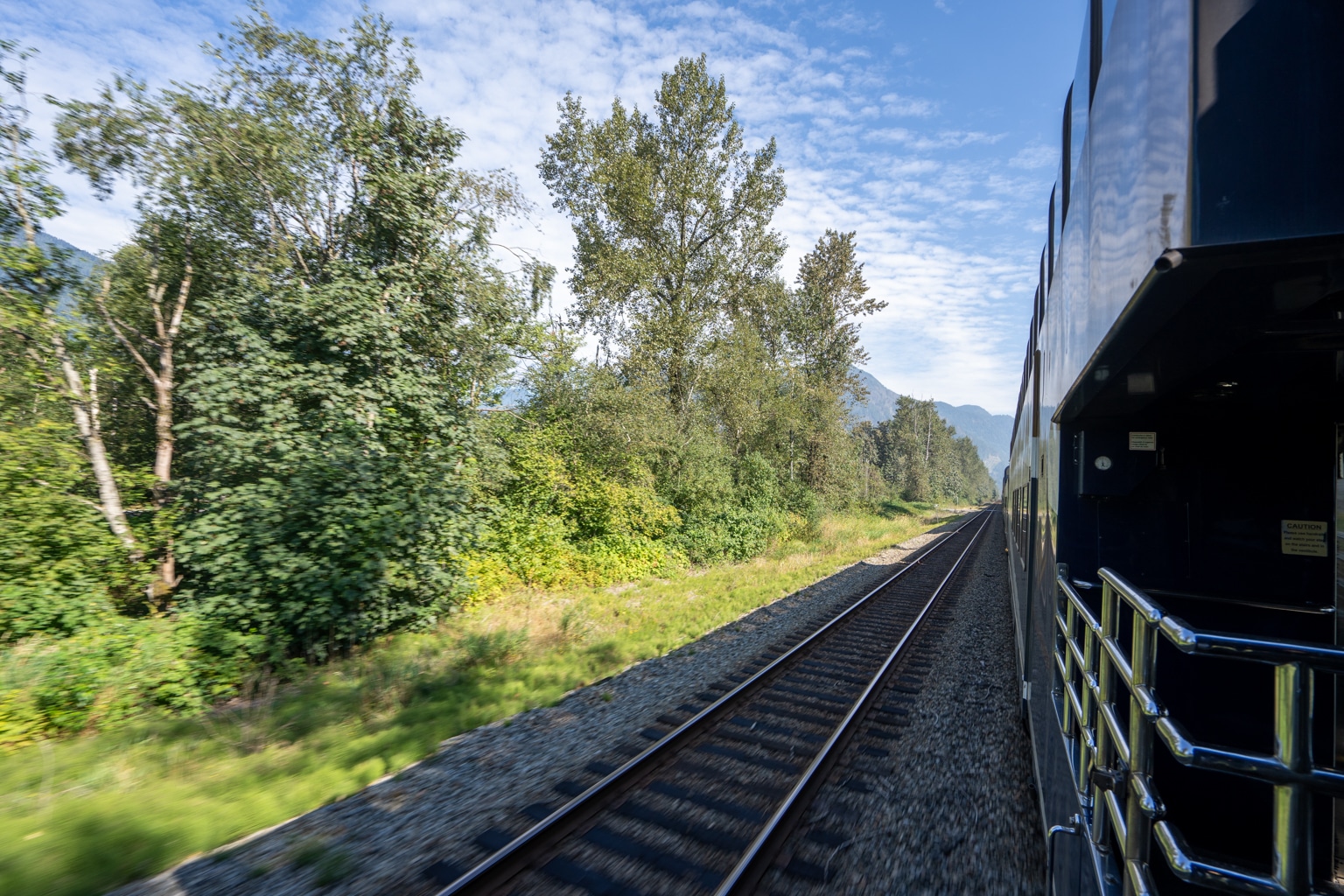
As we sipped on our drinks and prepared to head down for lunch, we passed by one of the main points of interest of the day.
The rushing white waters of Hell’s Gate in the Fraser Canyon were quite a sight to behold, as it’s an abrupt narrowing of the river with towering rock walls.
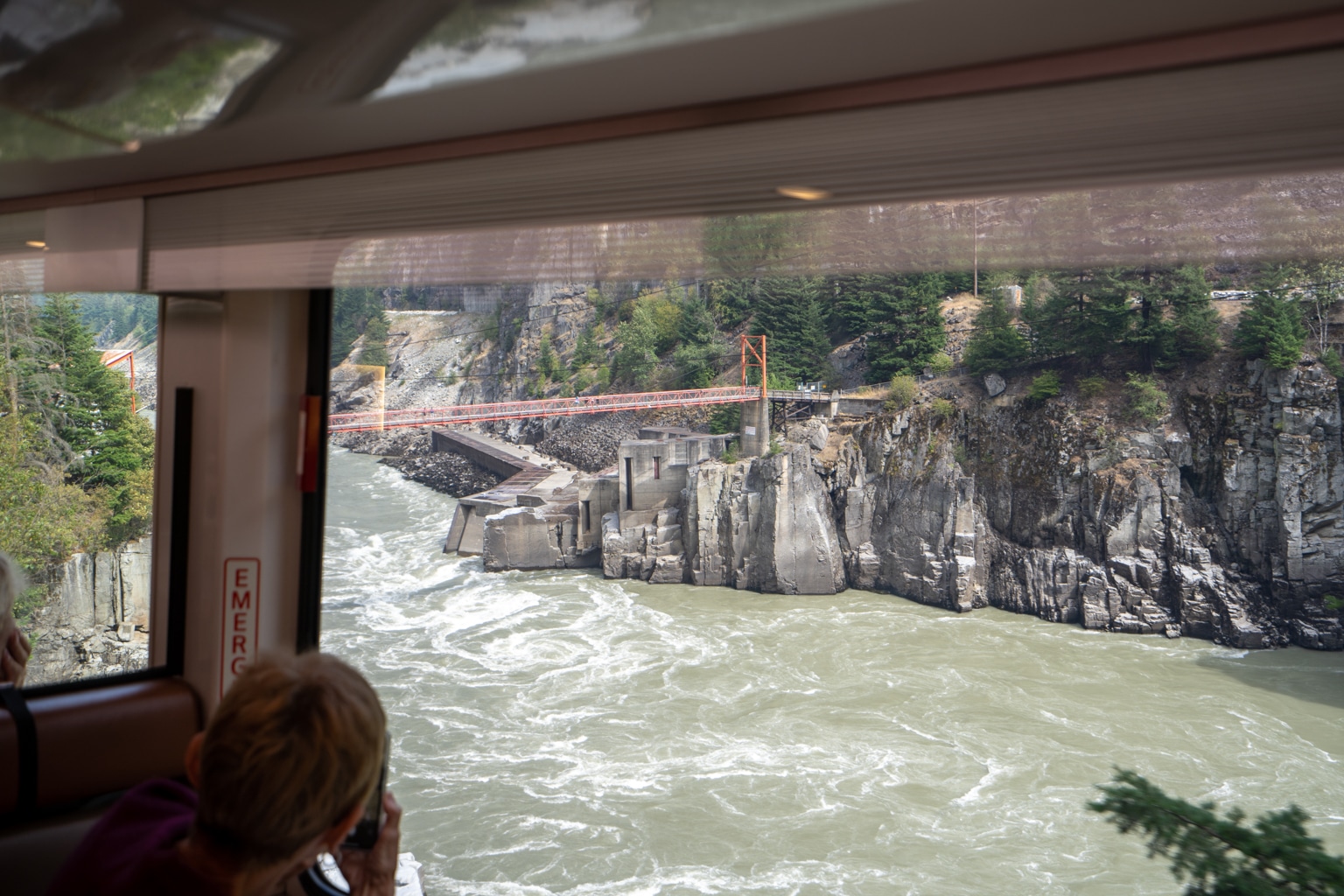
For our lunch starter, we had a small candied salmon platter with some naan bread to share.
I then opted for the steak with roasted vegetables as my main course, while Jessy chose the healthy tofu bowl with grains and vegetables.
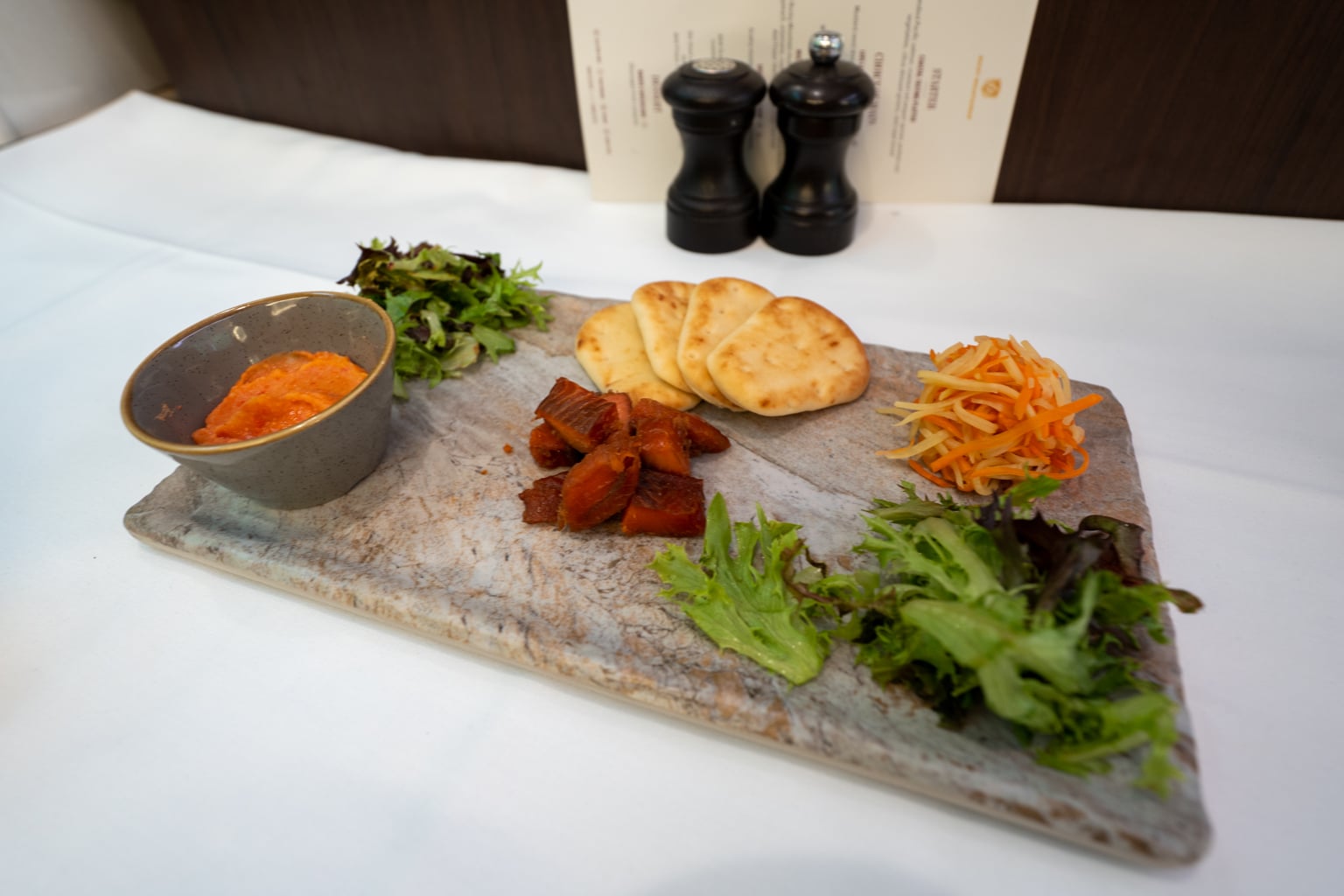
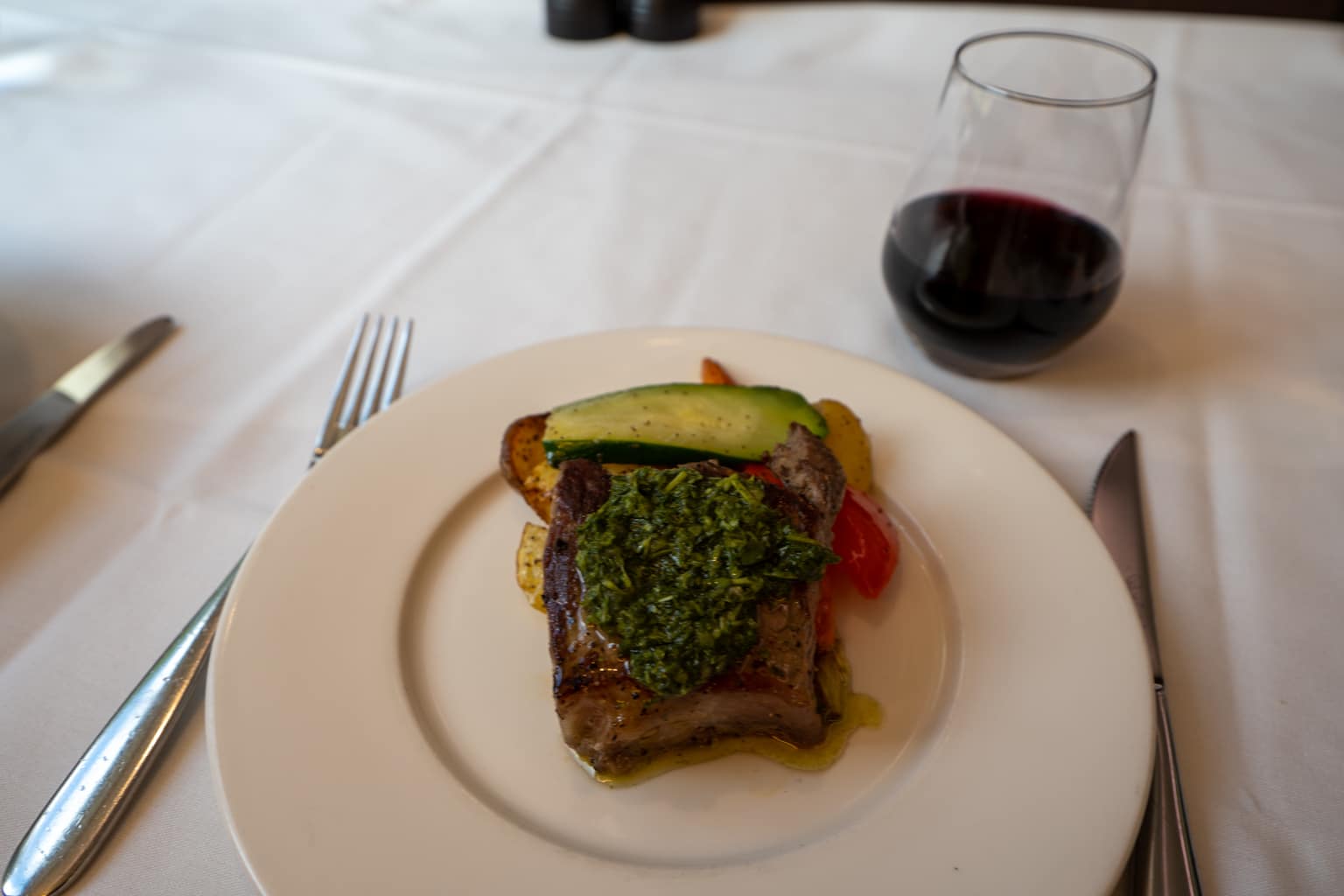
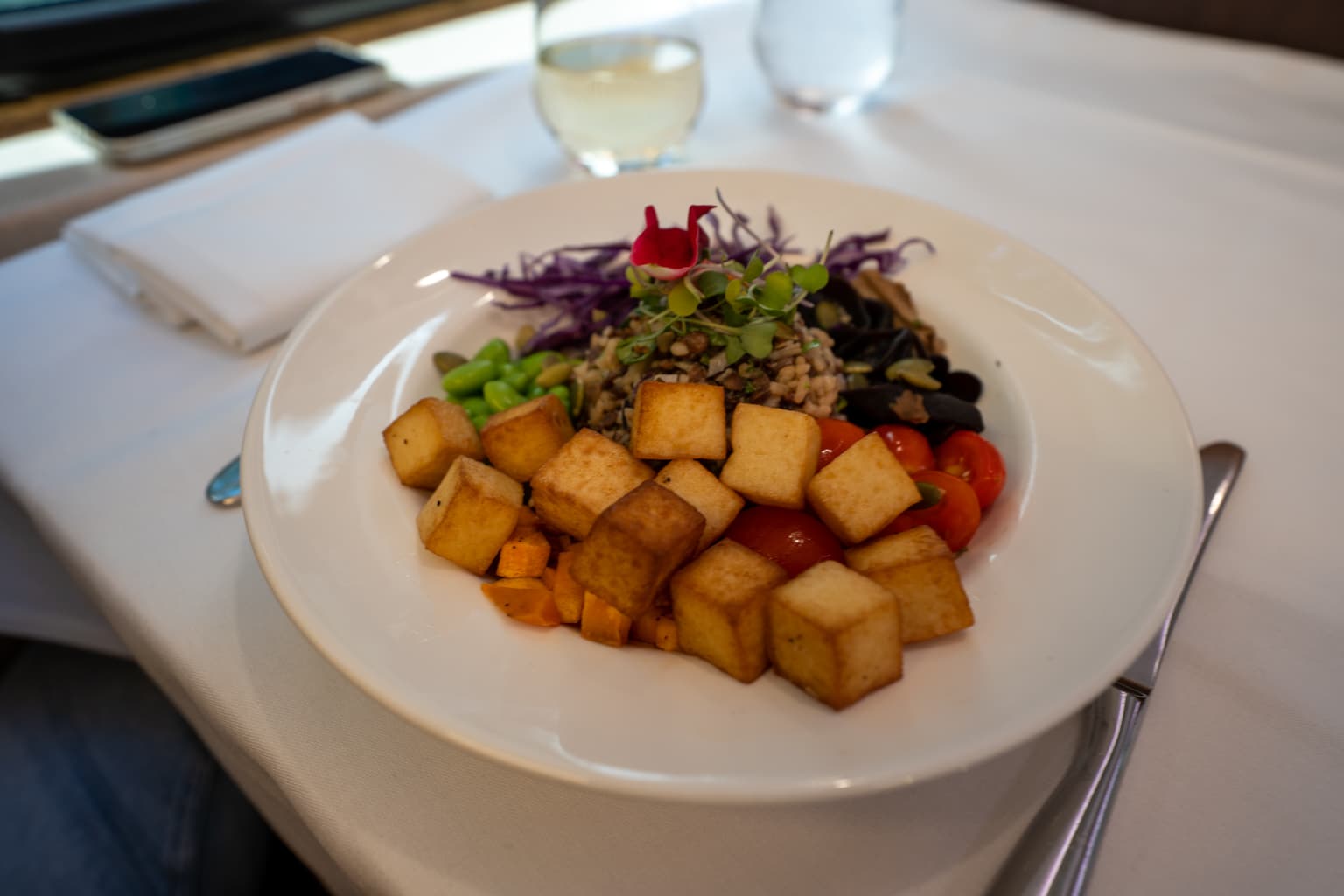
For dessert, we ordered some cheesecake, which was creamy and sweet, with a raspberry sauce drizzled over it.
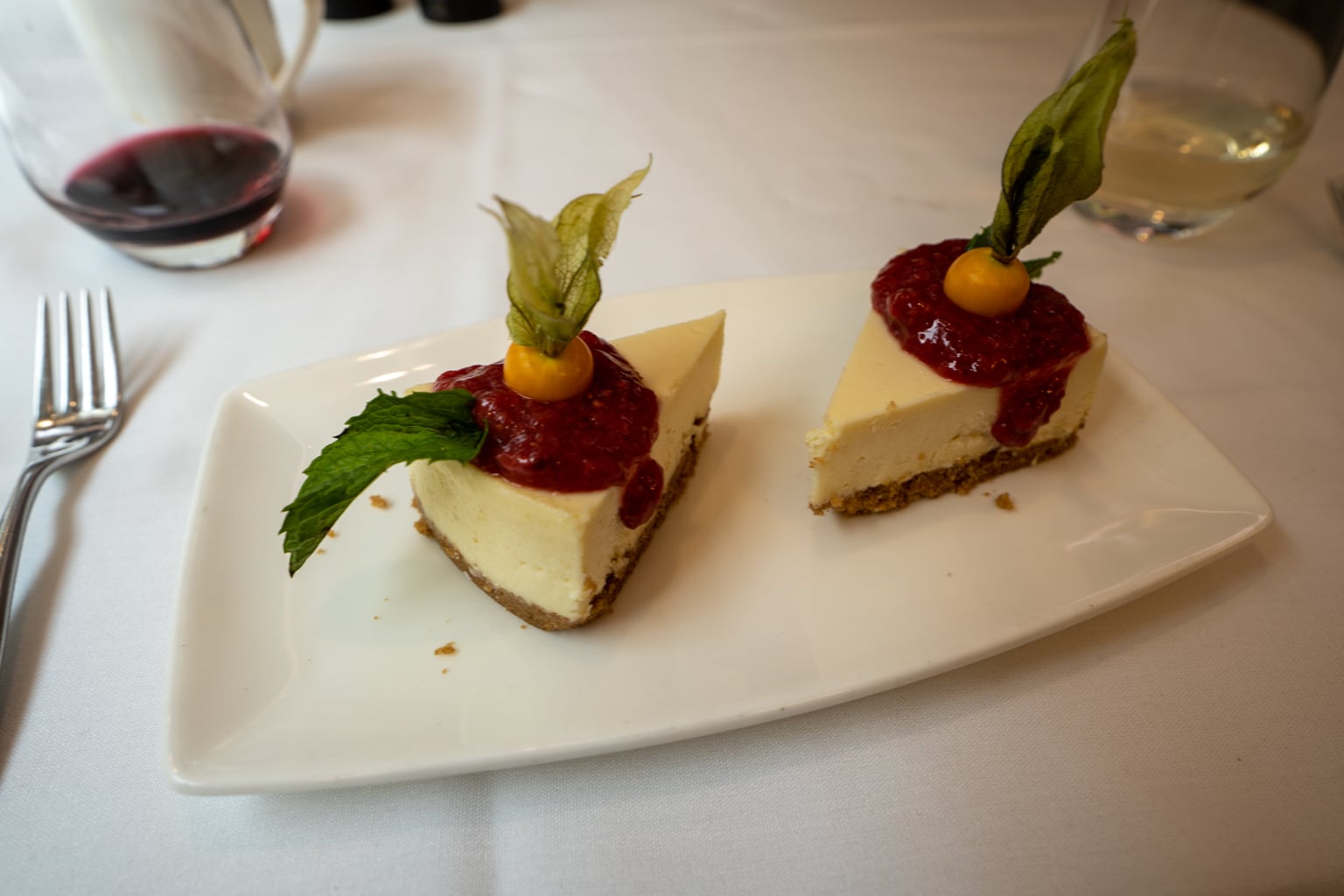
As we continued towards Kelowna, the scenery began changing from lush and green to dramatic and dry. We passed by the town of Lytton, BC, which was devastated by wildfires the previous summer, making this leg a more sombre part of our journey.
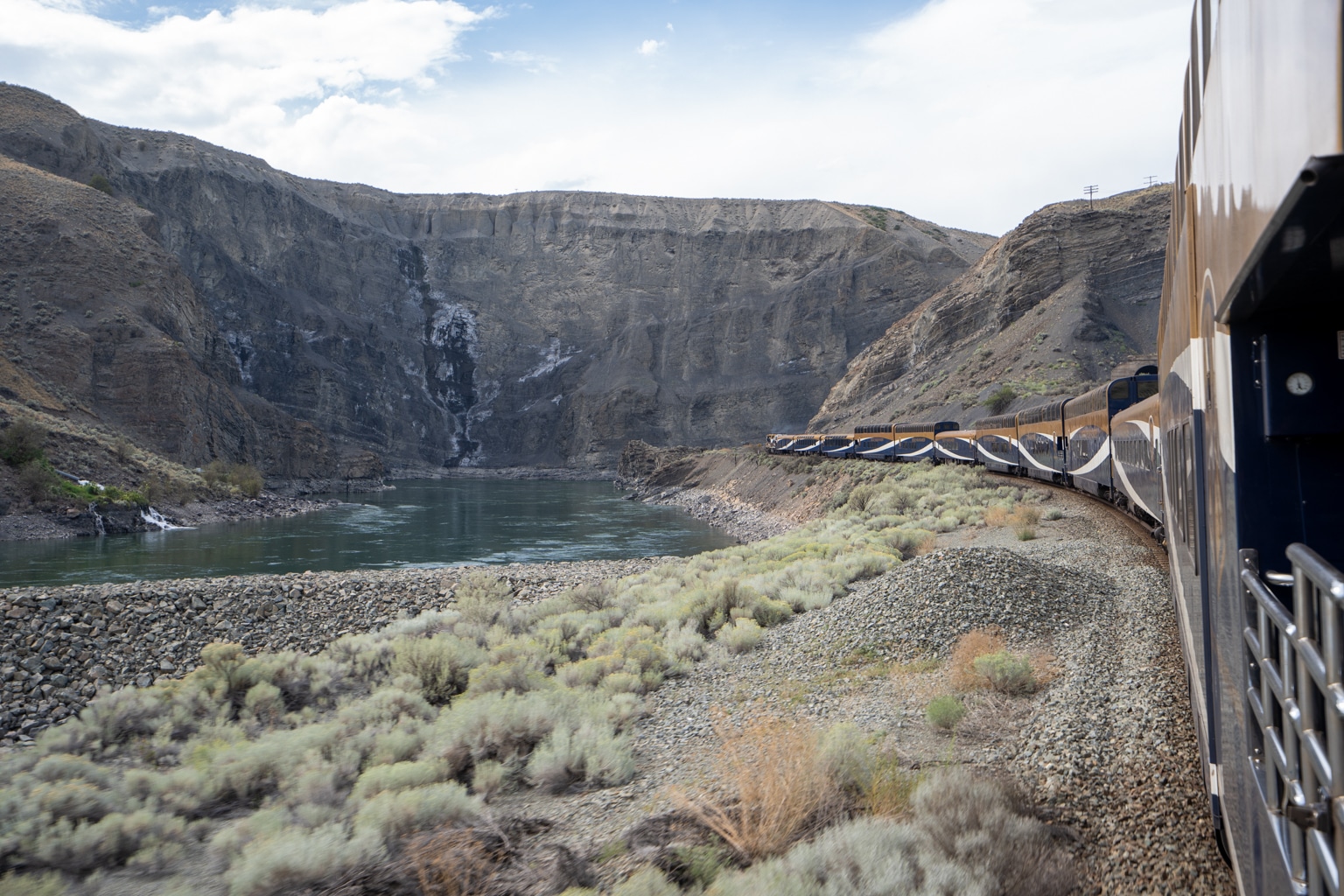

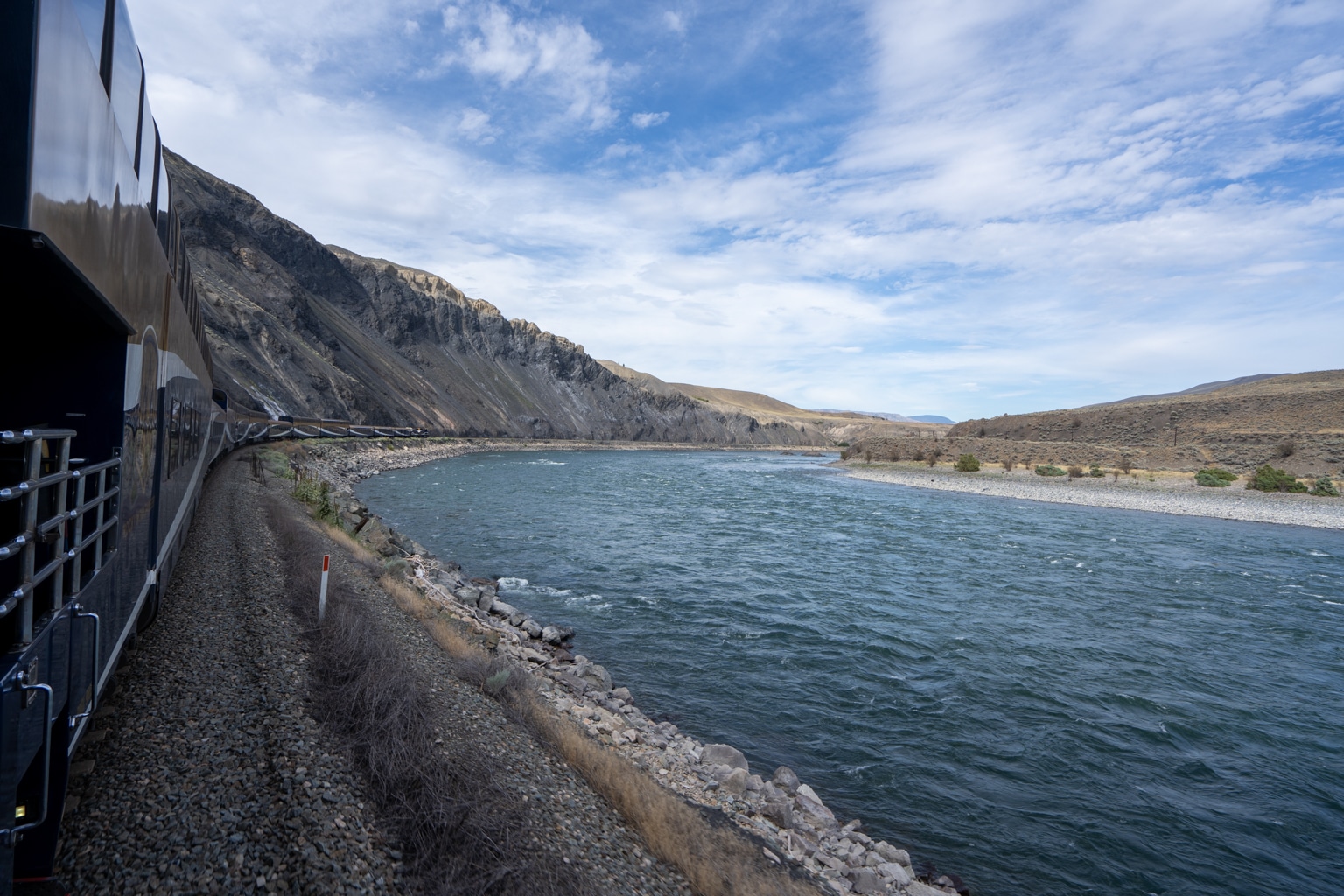
Around 5:30pm, we arrived in the city of Kamloops, BC. Our hotel keys to the Delta Kamloops were provided directly on the train, so we didn’t need to check in.
Rather, we simply disembarked from the train and boarded the coach that brought us directly to the hotel, and immediately headed upstairs to our room.
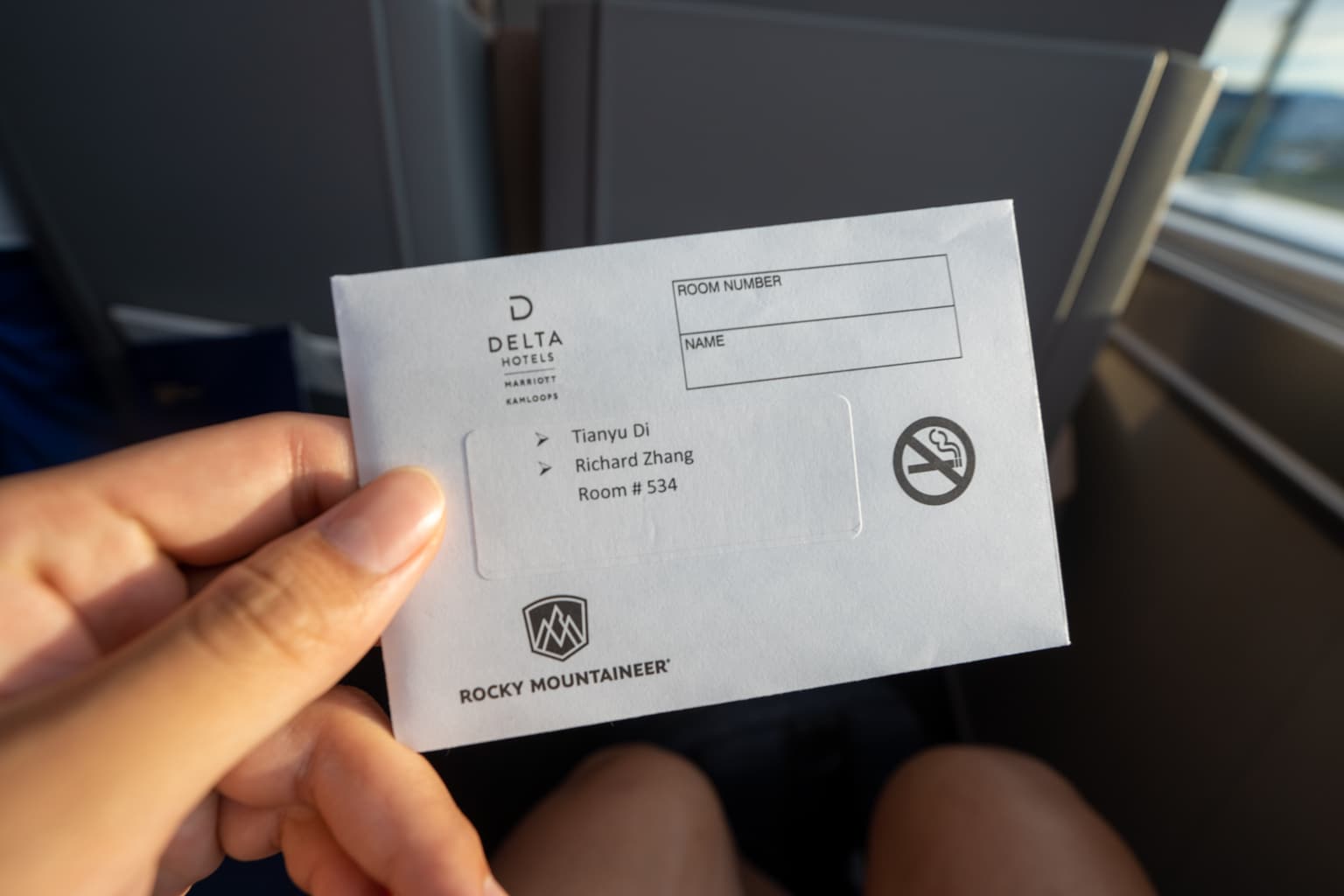
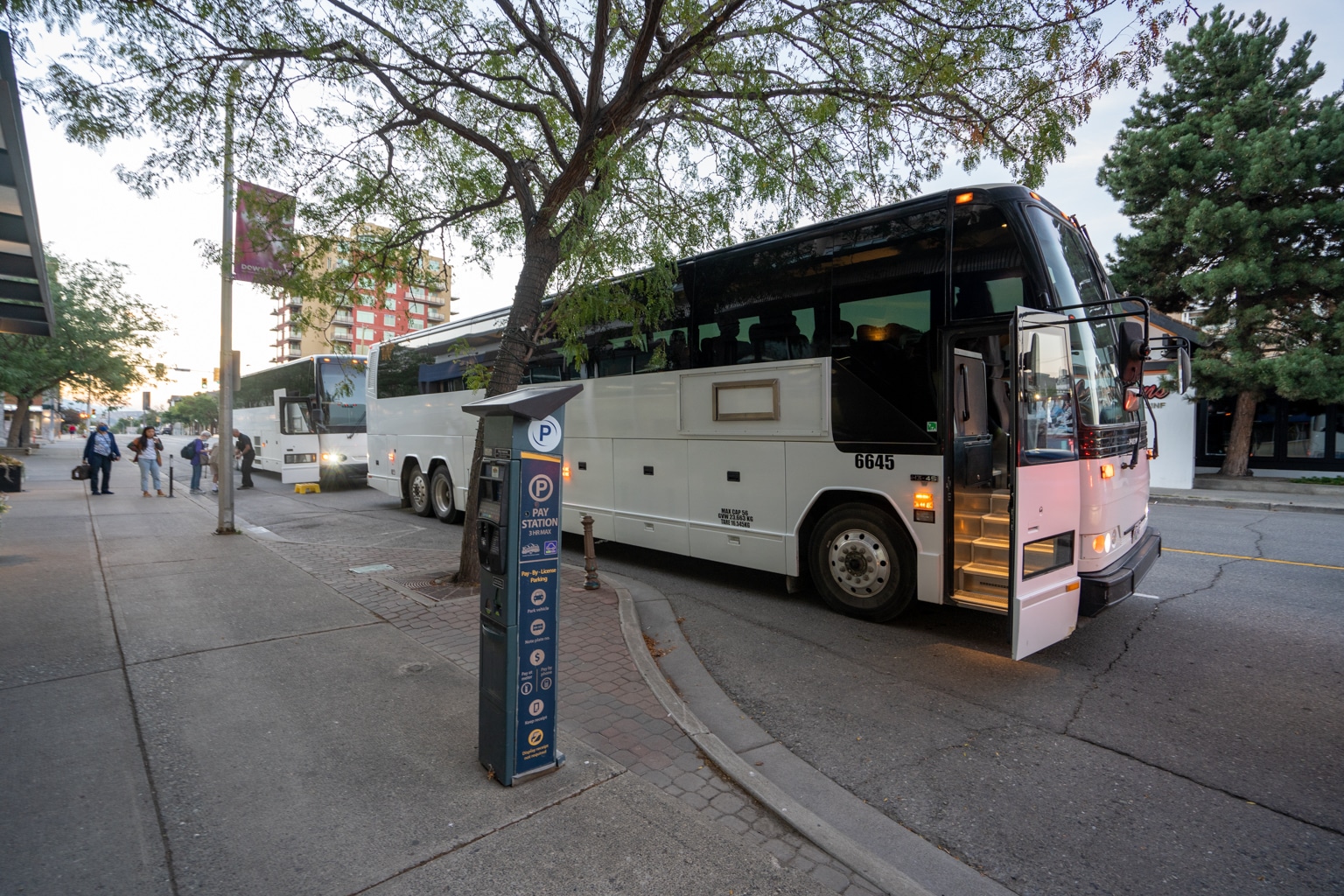
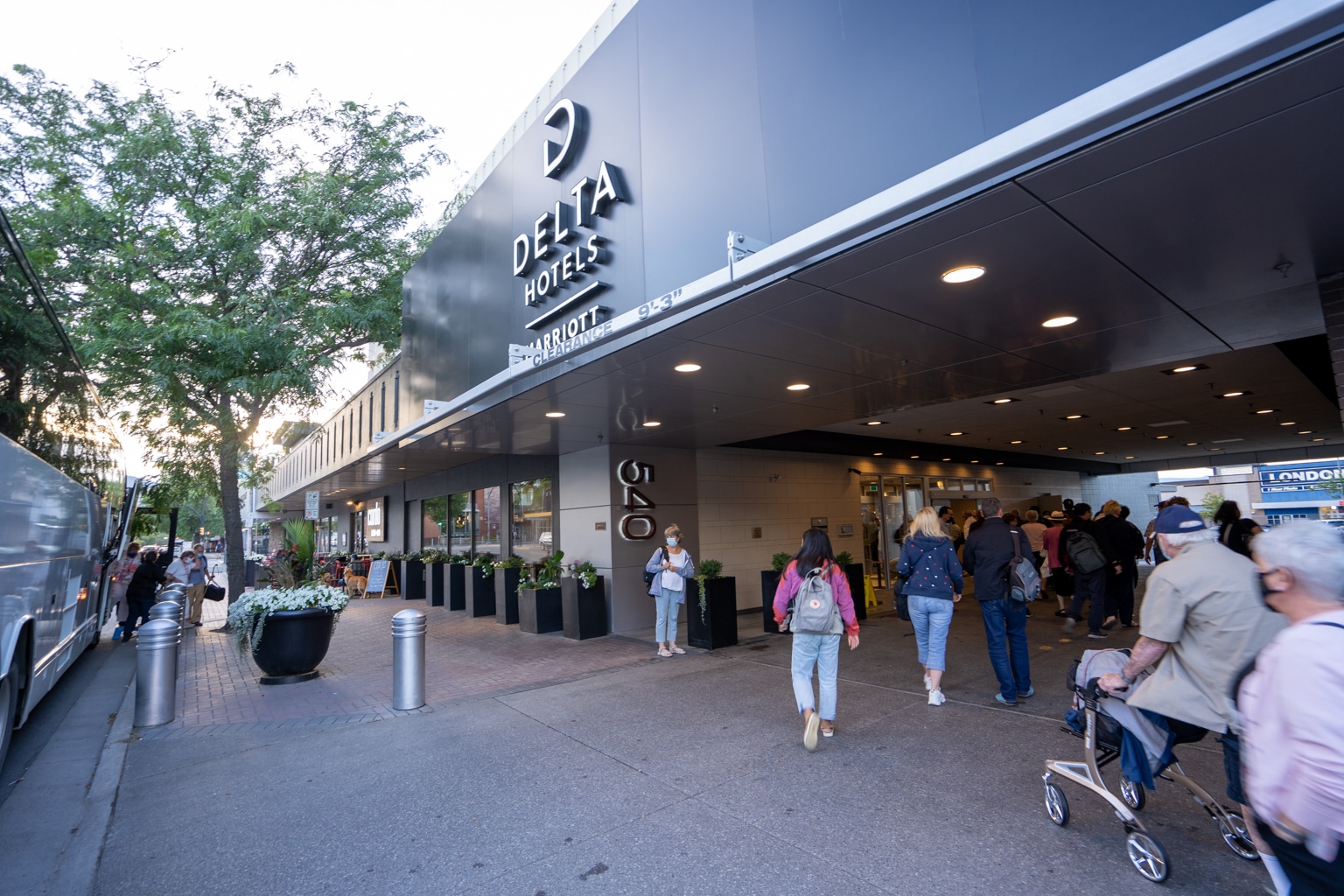
I’ll review the Delta Kamloops in a separate article, so stay tuned for that.
Rocky Mountaineer “First Passage to the West” – Day 2
Day 2 began with another bright and early start, boarding the bus at the Delta Kamloops at 6:15am to return to the Kamloops trainyard.
On this day, we were the second group to head down for breakfast. While we waited, the train staff came through the viewing deck with some coffee, tea, and pastries.
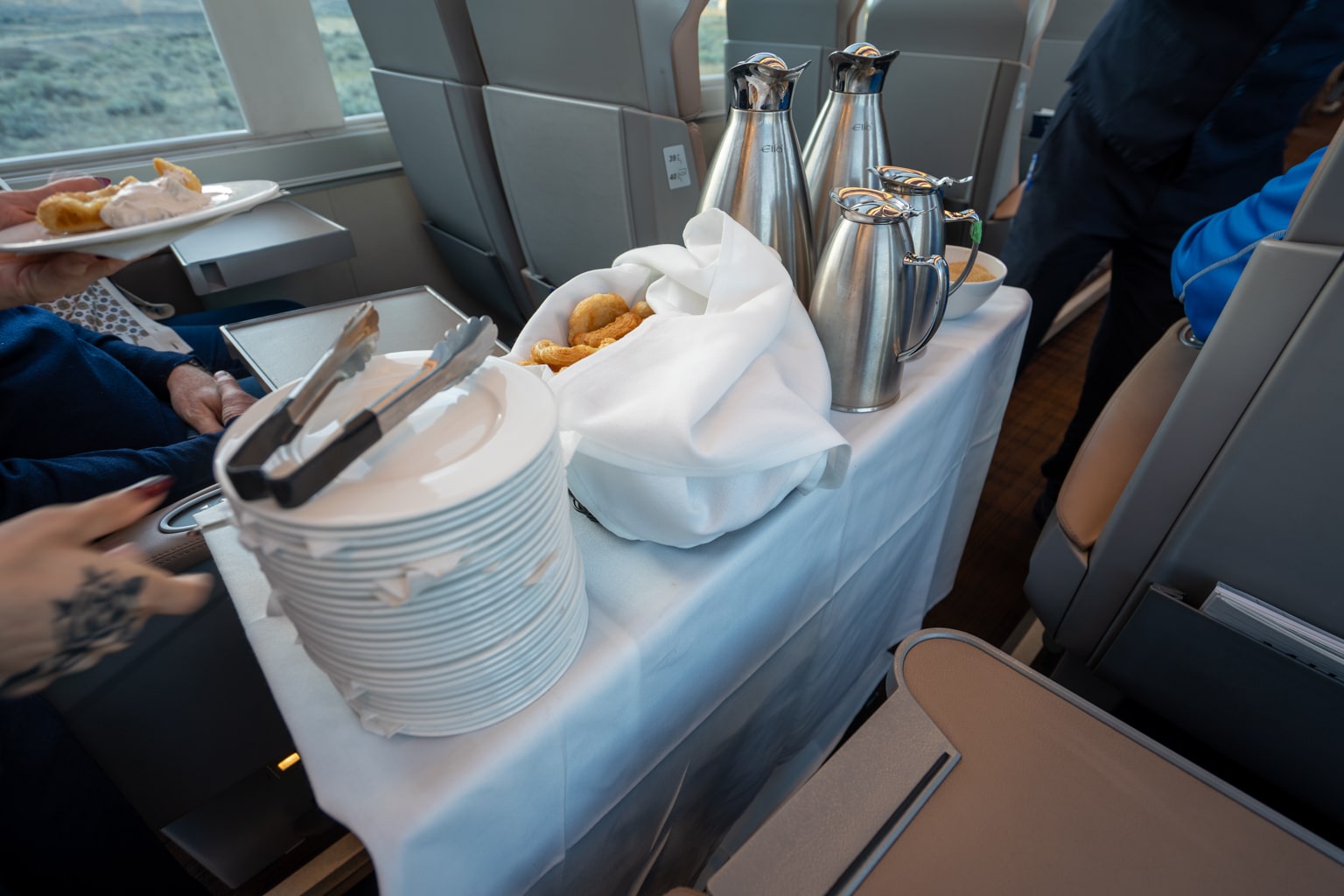
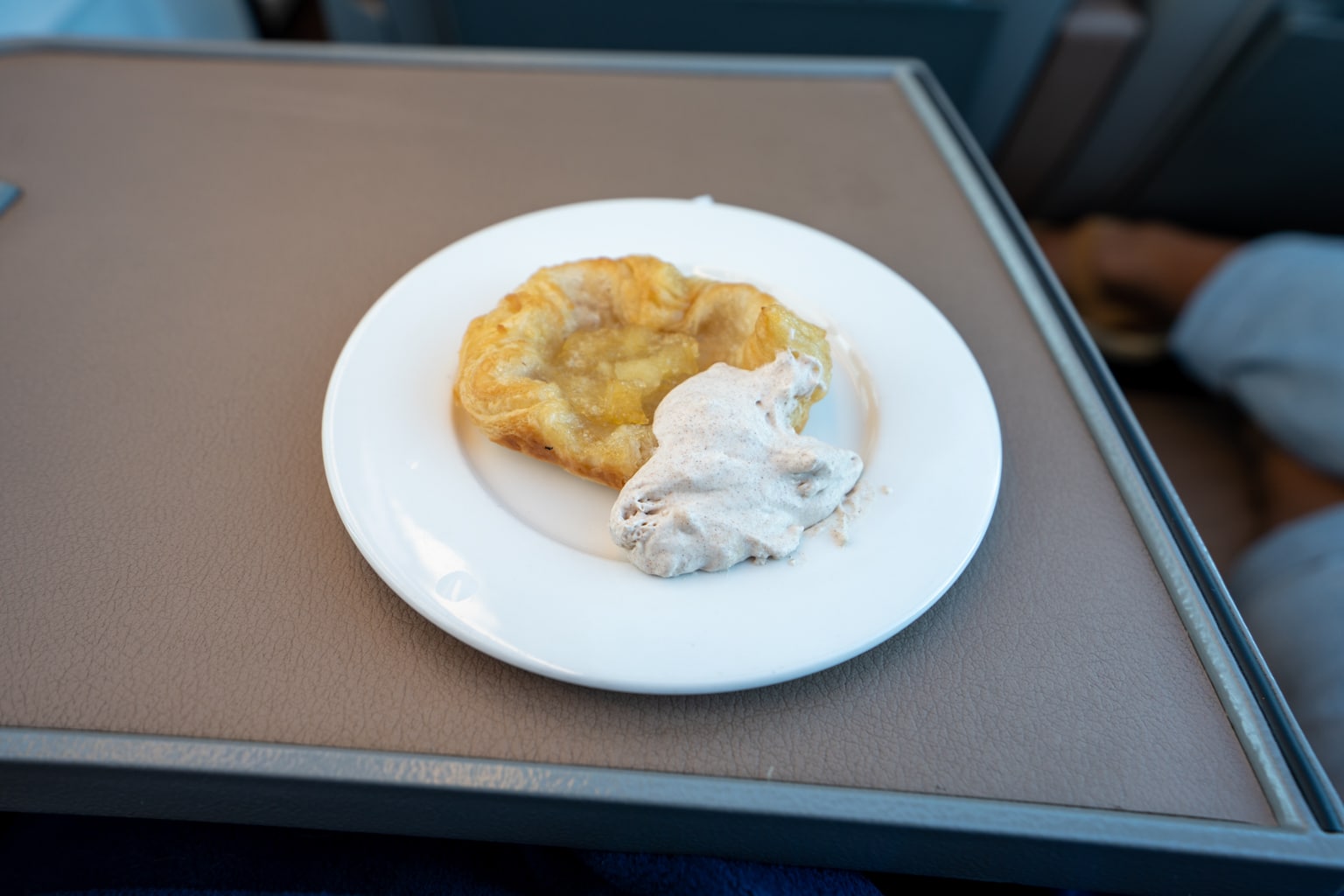
We began breakfast with more croissants and refreshing smoothies. This time, I had eggs with roasted potatoes topped with salmon for my main dish, while Jessy had a yogurt parfait bowl.



After breakfast, I returned to my seat and opted for a Caesar, continuing to admire the views as we approached the border of British Columbia and Alberta. The scenery became lush and green once again, as we moved into the mountains.
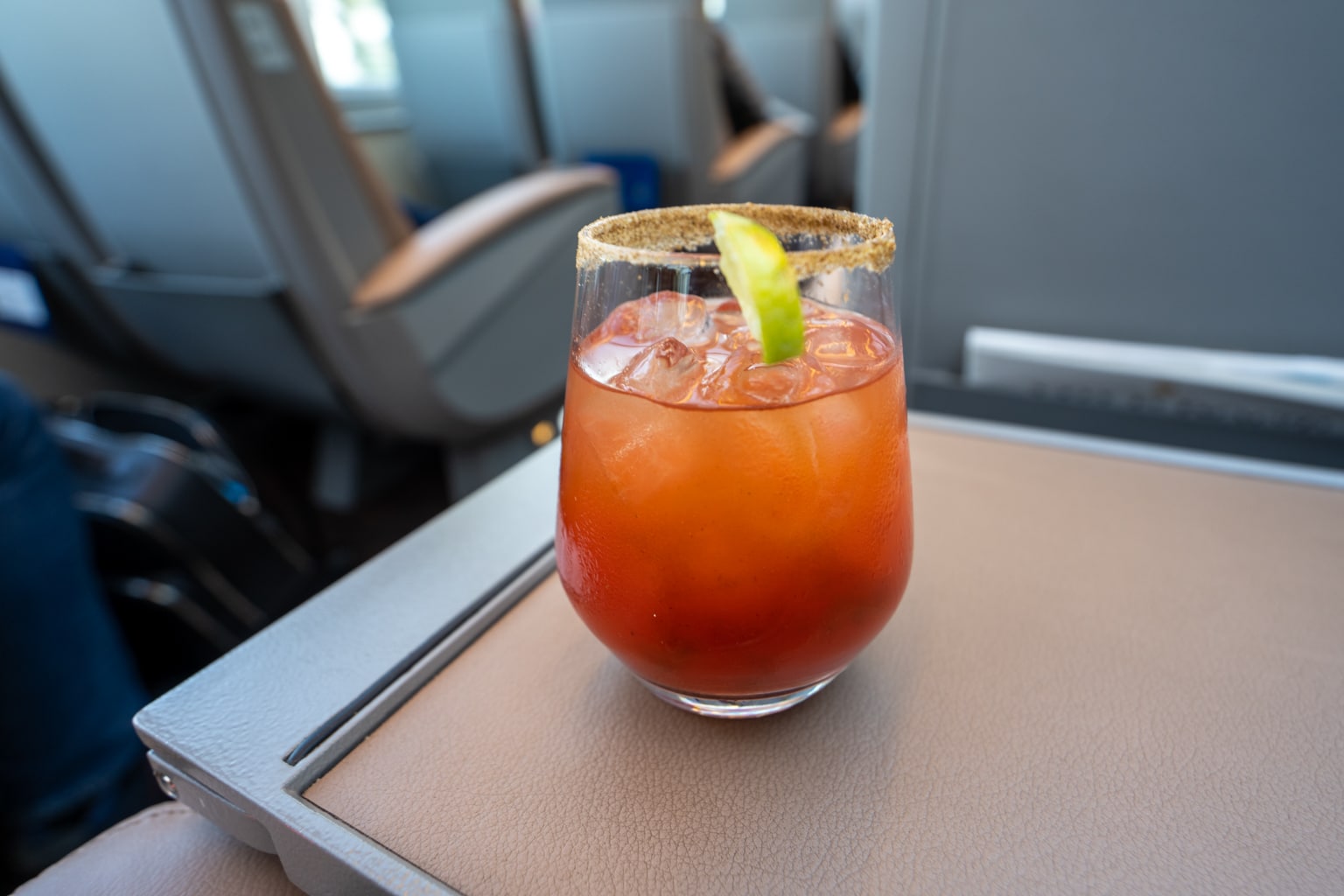
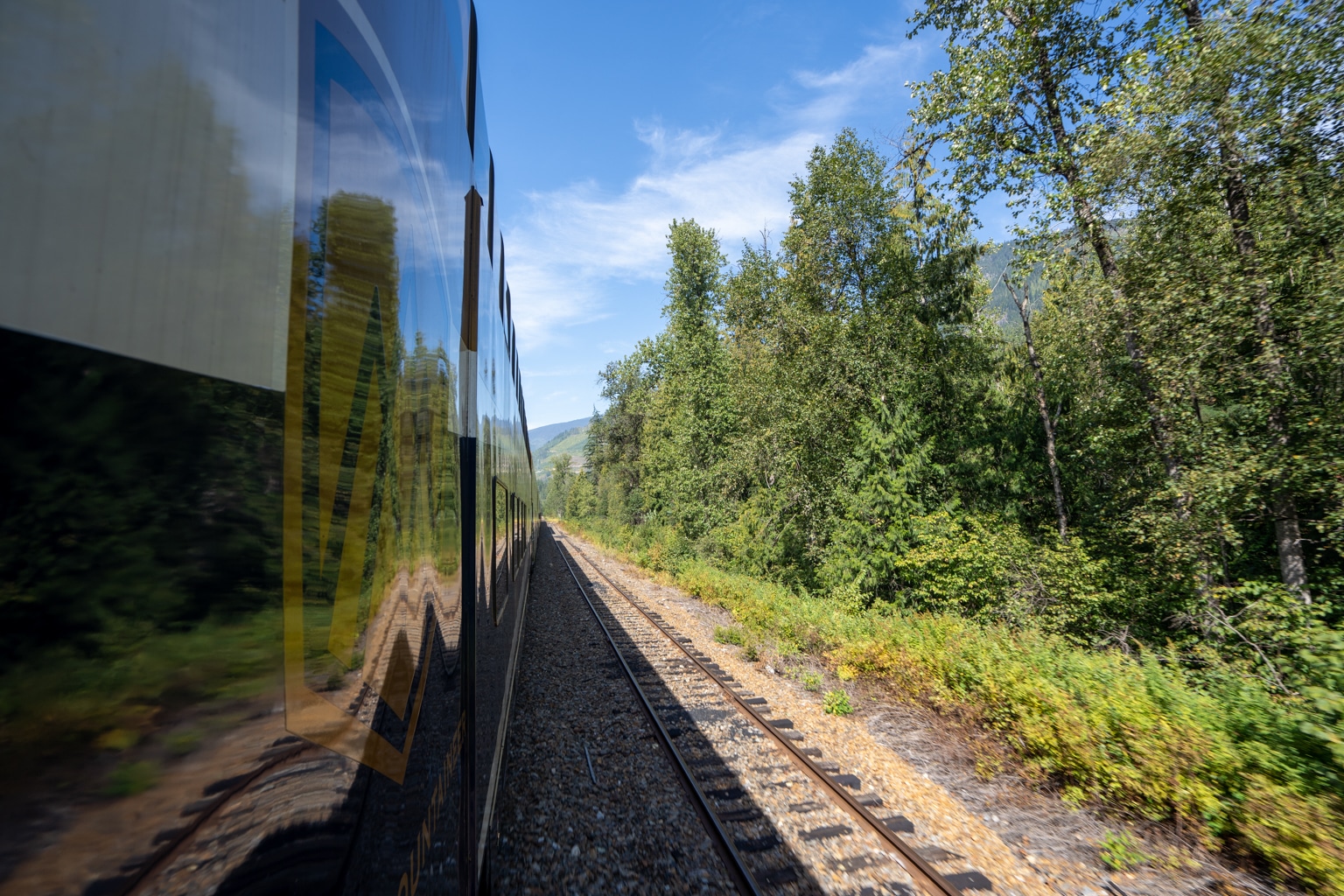
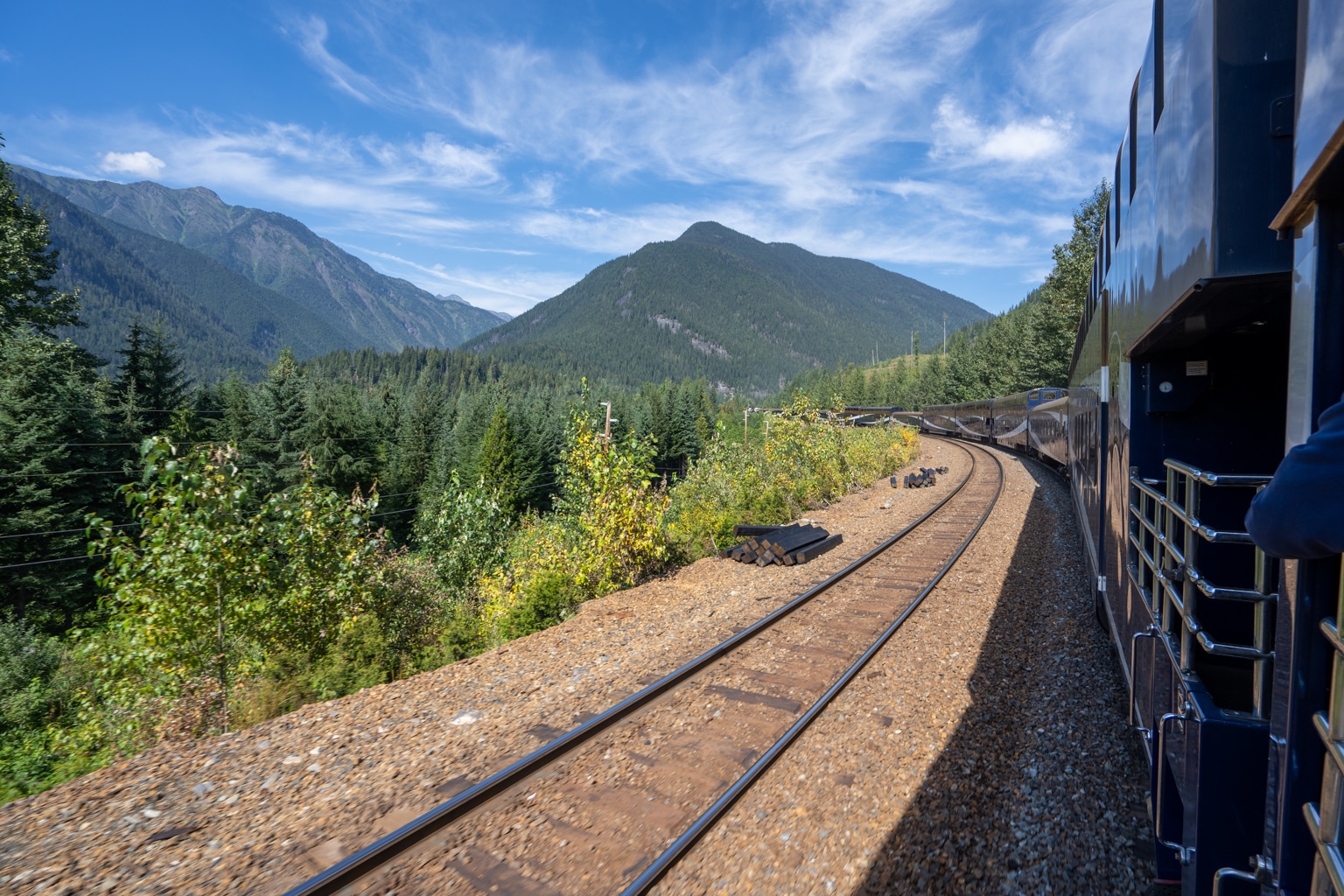
After a few hours of lovely chatter with the older Scottish couple seated opposite us, it was lunchtime once again.
For lunch, we had a charcuterie plate with blue cheese spread, some sausage, and fresh baguettes.
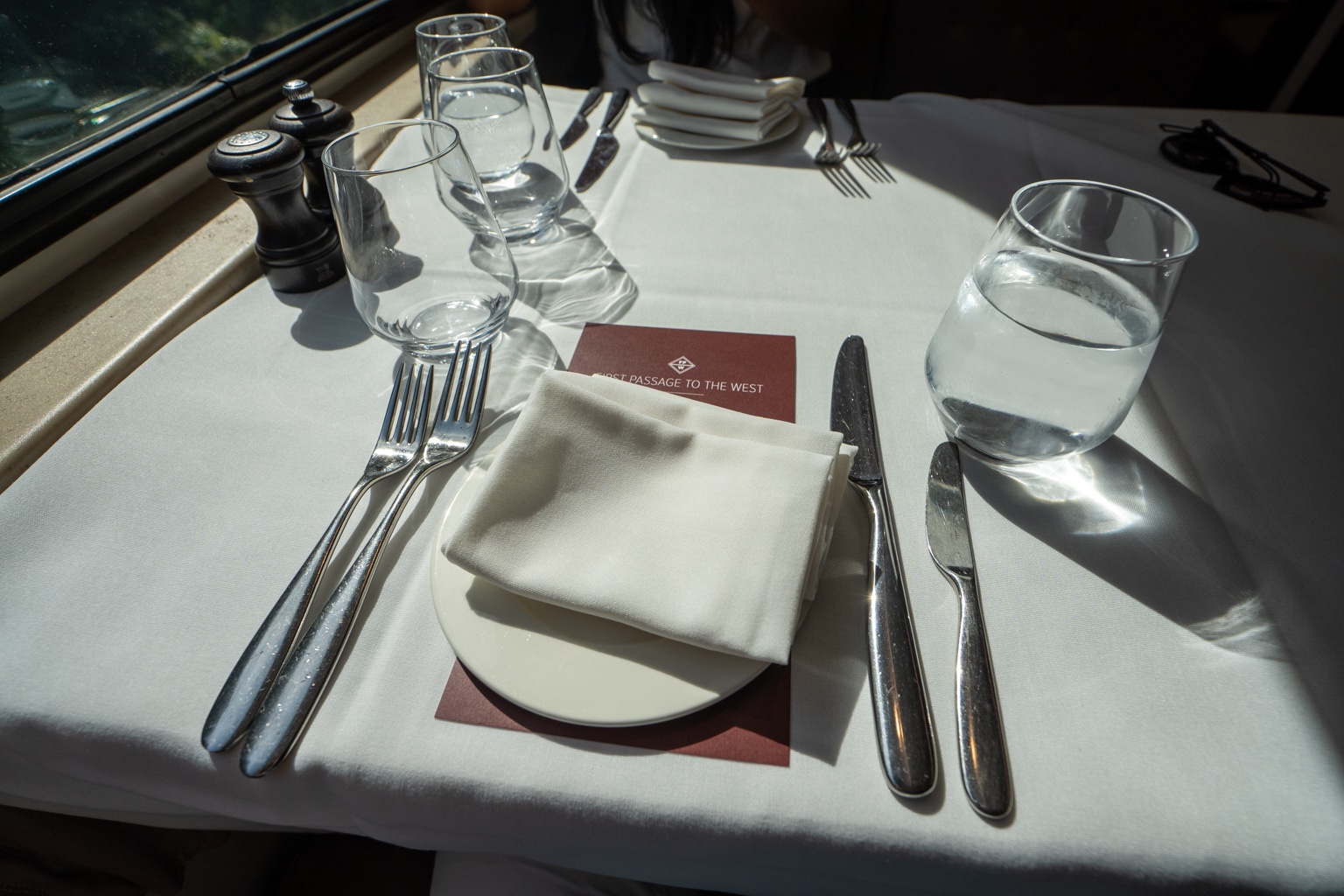
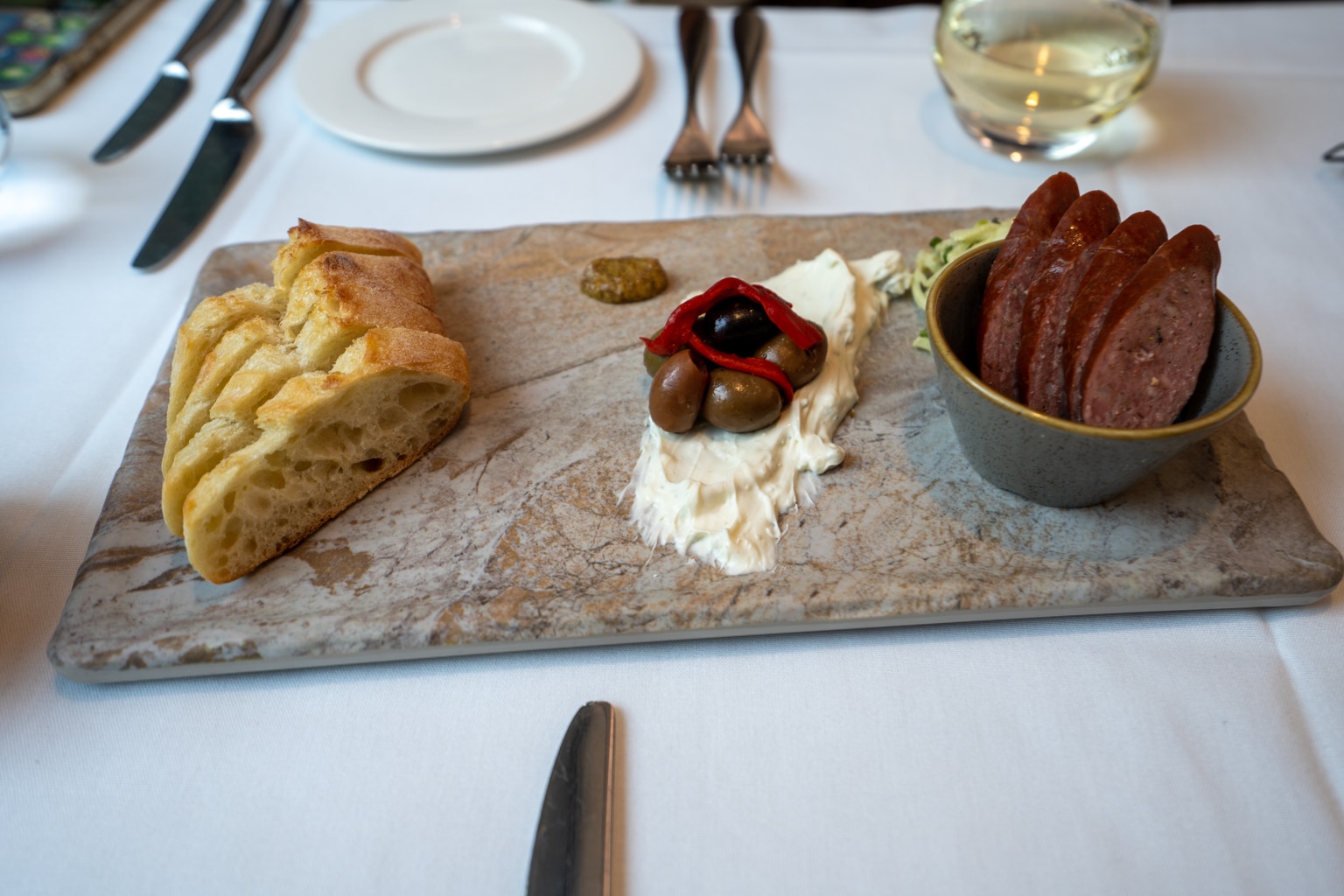
I helped myself to braised veal cheek for the main course, while Jessy had the risotto with salmon. I had a bite of Jessy’s and found it to be pretty tasty, but I wasn’t a huge fan of my veal.
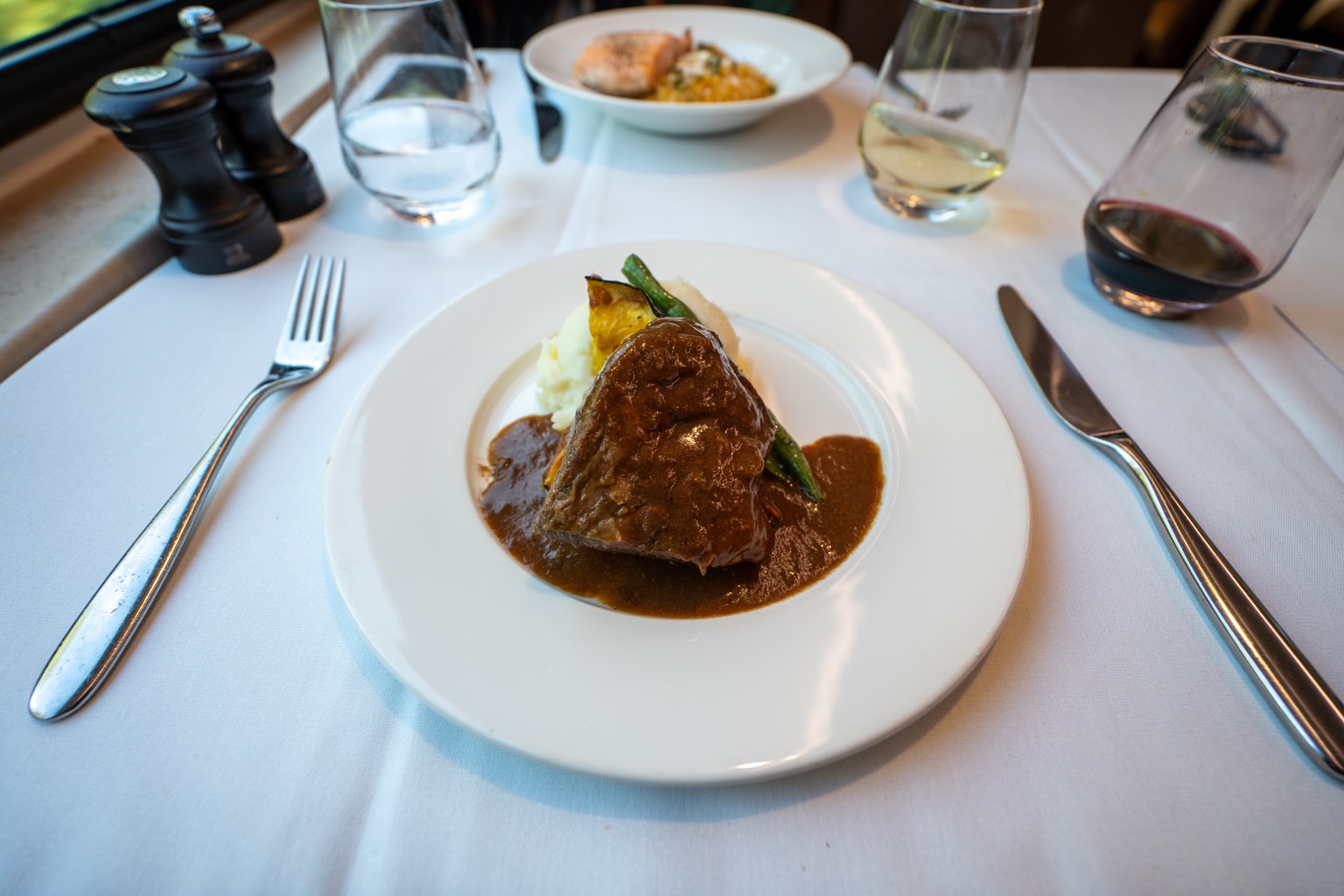
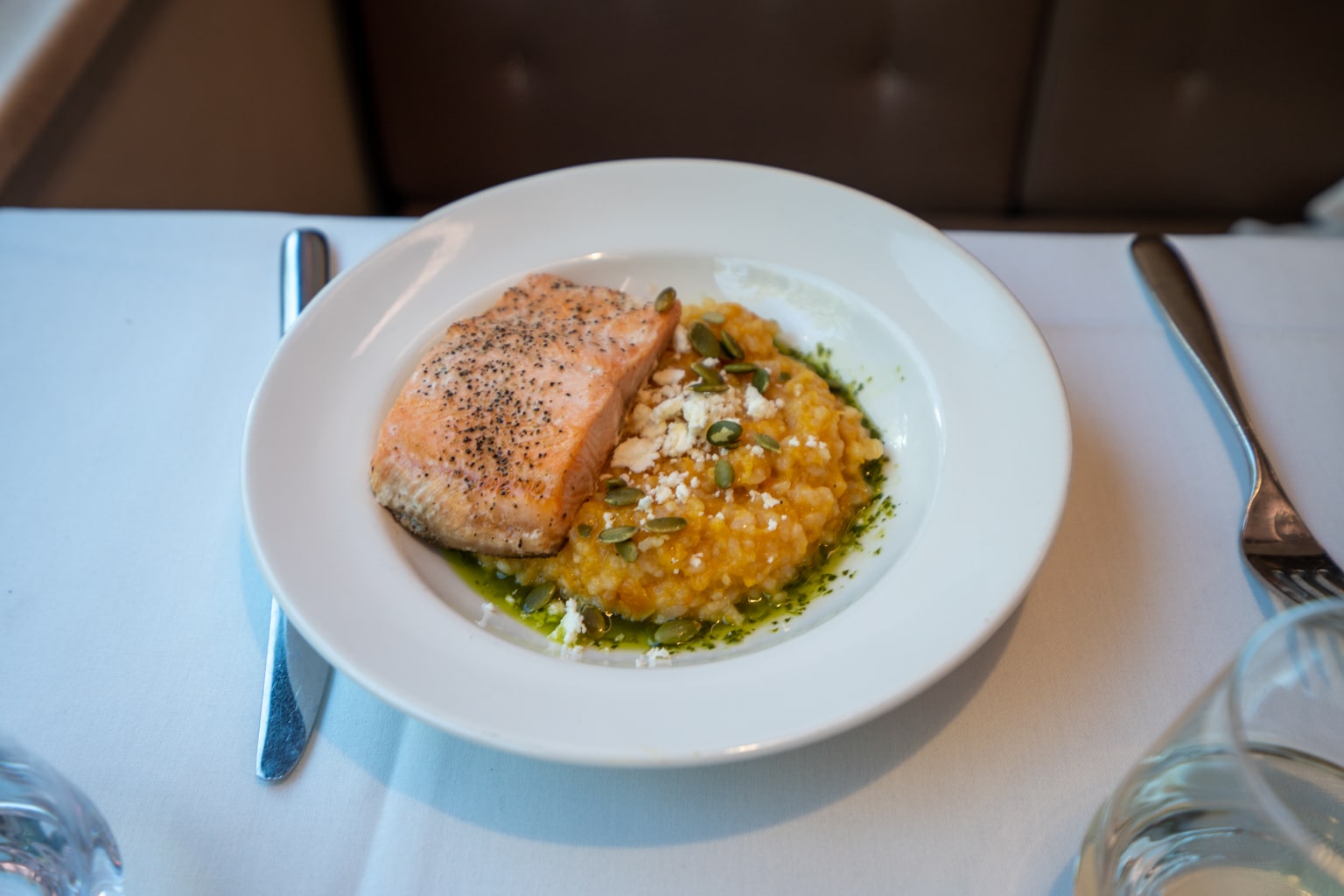
The views on Day 2 consisted of stunning wide-open ranches, rocky lakeshores, and mountain peaks set against sunny blue skies – with the first few snow-capped peaks starting to appear as we climbed towards Lake Louise in the afternoon.
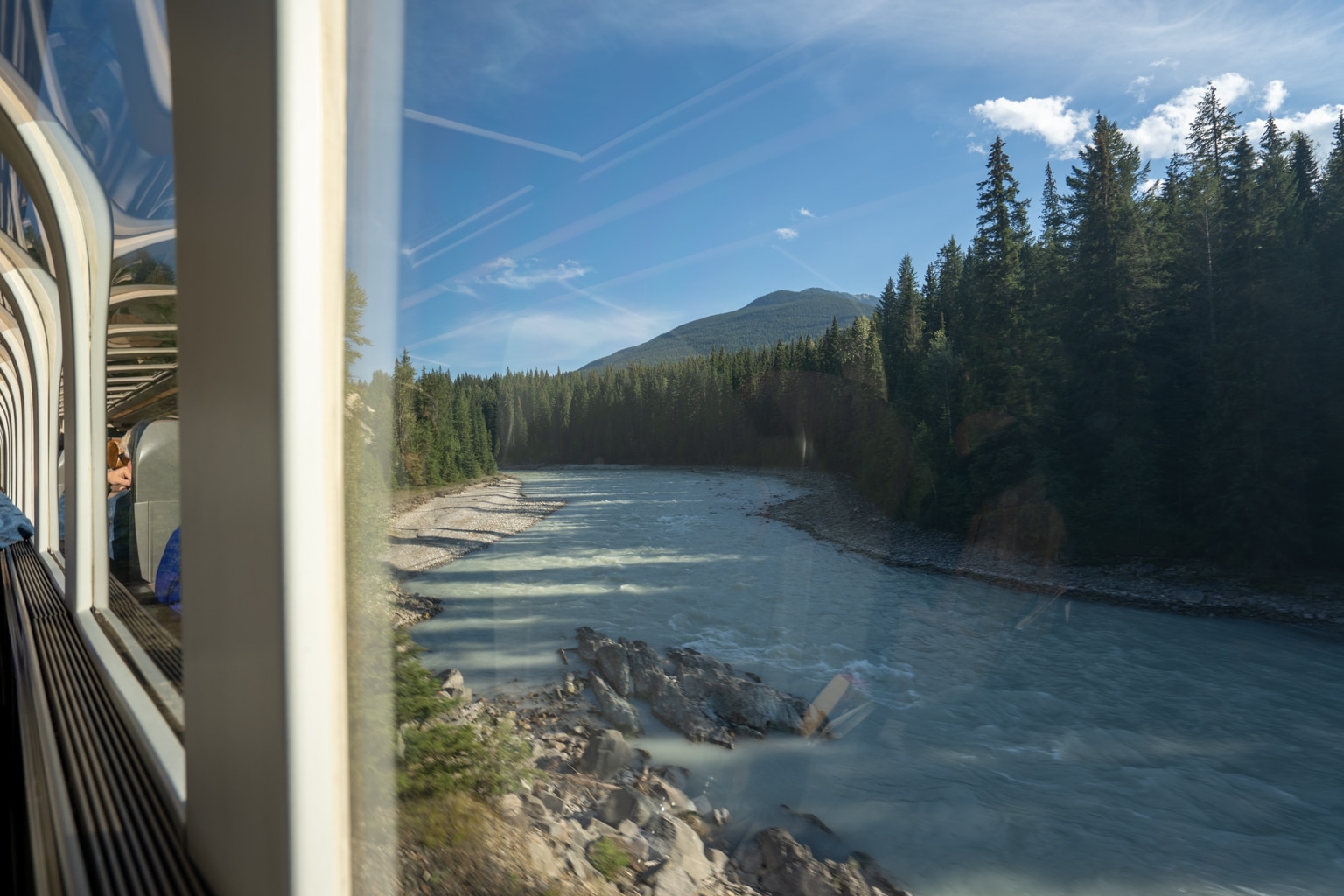

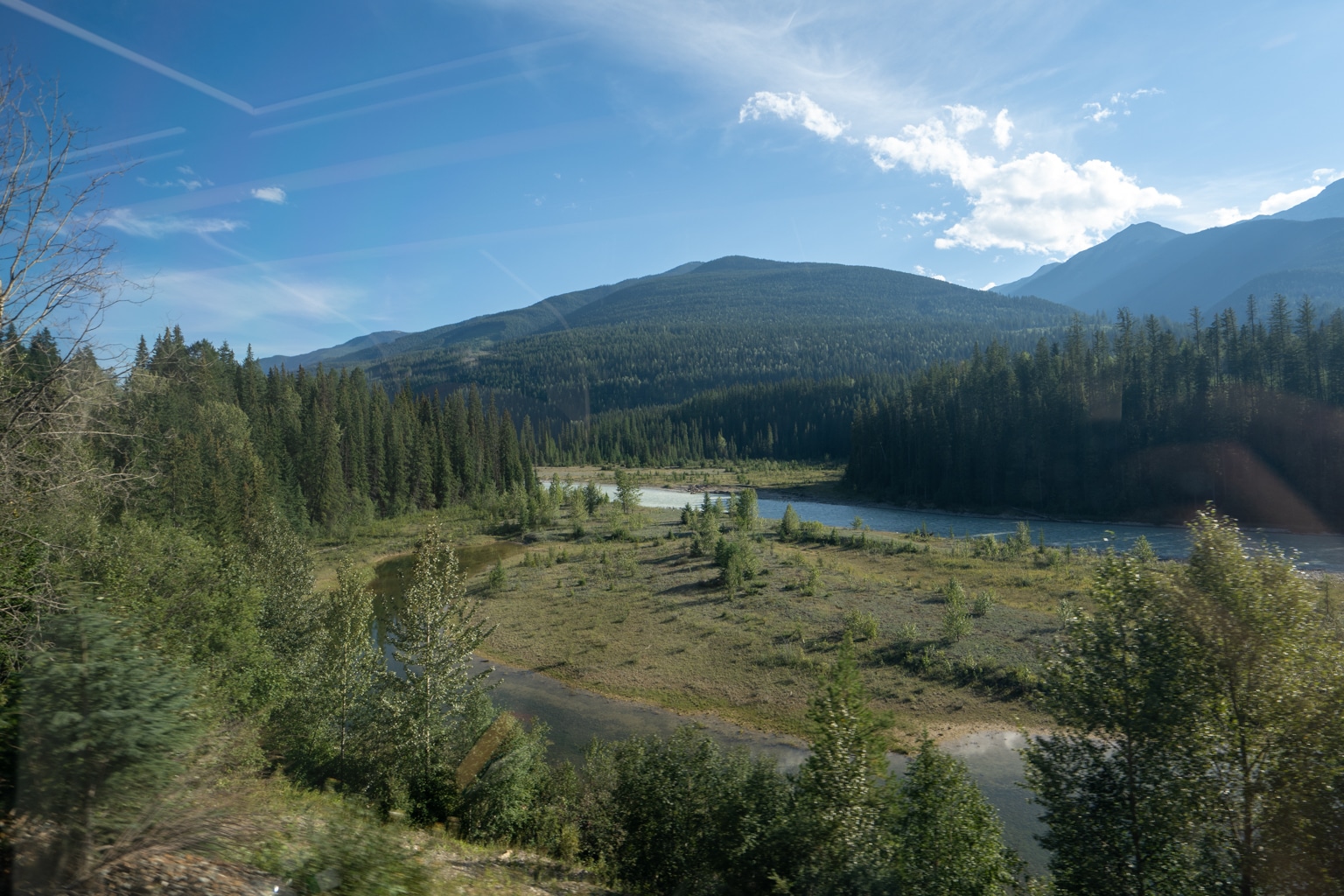
We passed by Craigellachie, where the last spike of the Canadian Pacific Railway was hammered, and then approached the spiral tunnels of Kicking Horse Pass.
These spiral tunnels are an engineering feat, in which a series of tunnels spiral within the interior of the mountain. They were designed this way so that trains can safely gain elevation here.
We were a bit delayed along the rails along the course of our journey, so we were treated to an additional snack of butter chicken in the late afternoon.
To be frank, the butter chicken wasn’t that great, but it nevertheless tided us over until our 8:30pm arrival in Banff.

By this time, we were nearing the end of our trip, so I ordered another Caesar as we approached Banff. The sun was setting over the mountains as we arrived, and the orange glow on the trees passing around us was spectacular, and left a lasting impression.

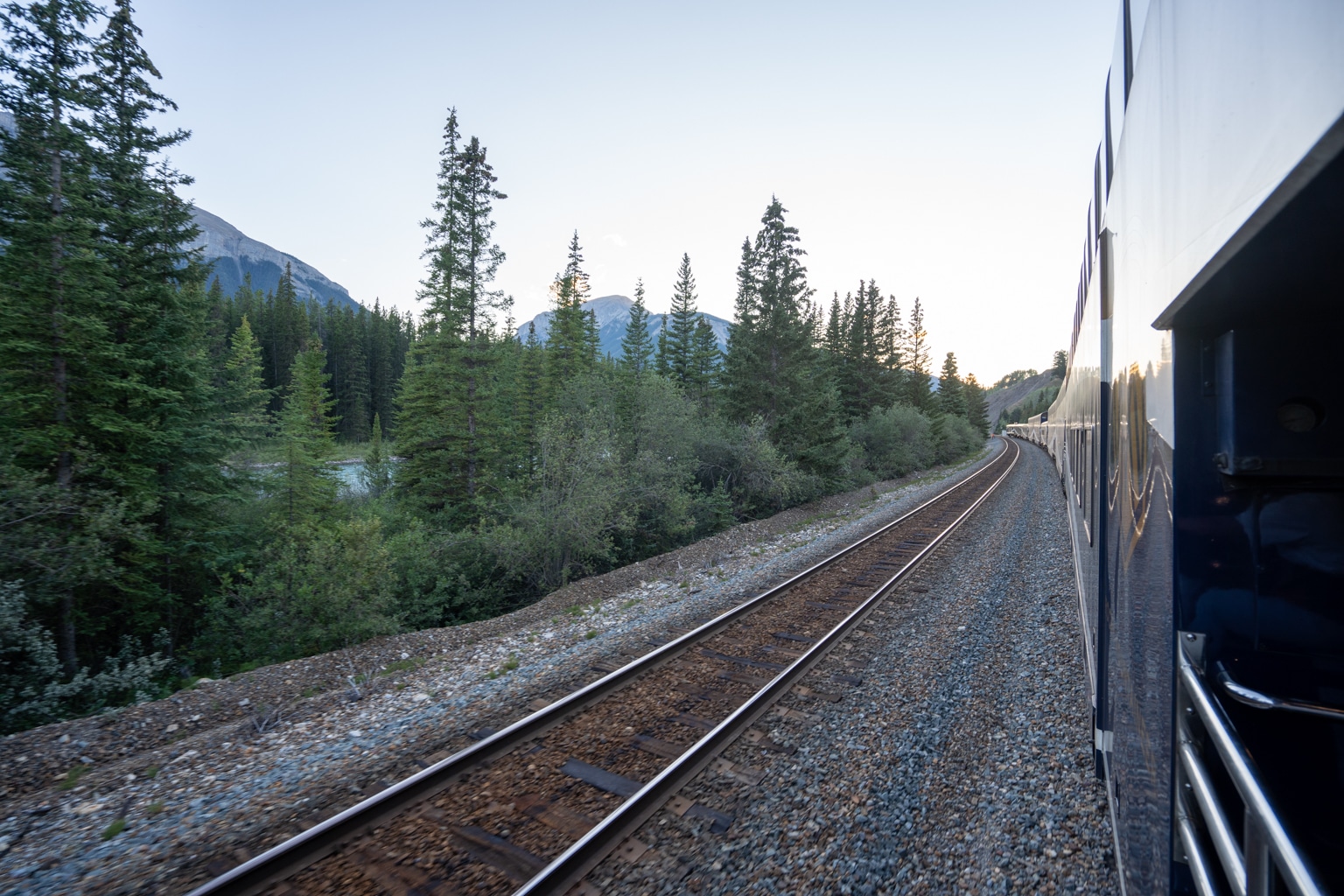
Rocky Mountaineer “First Passage to the West” – Other Facilities
The restrooms on board are situated on the lower level, and were spacious, clean, and simple. The toilet has two railings on each side for stabilizing yourself as the train moves.
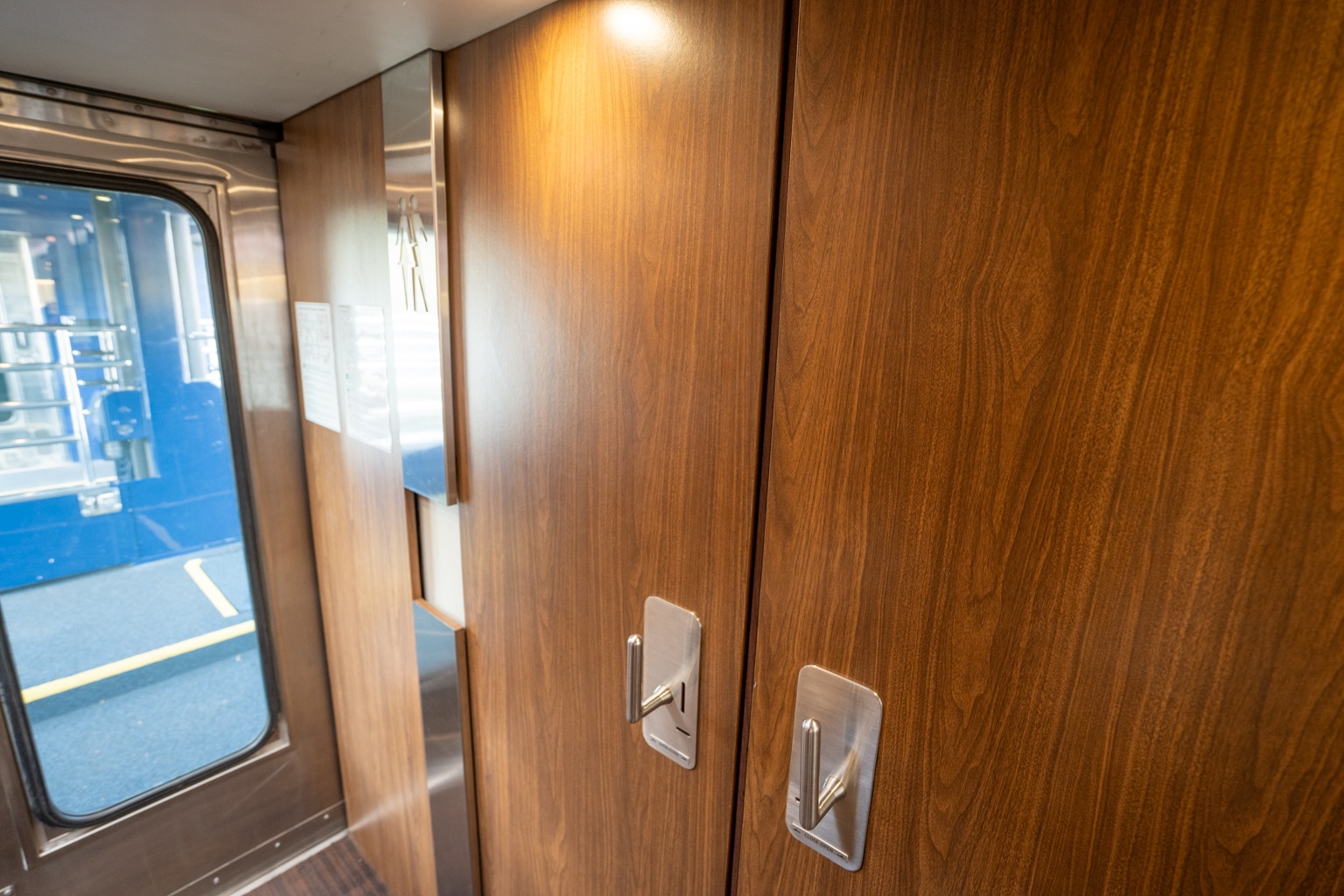
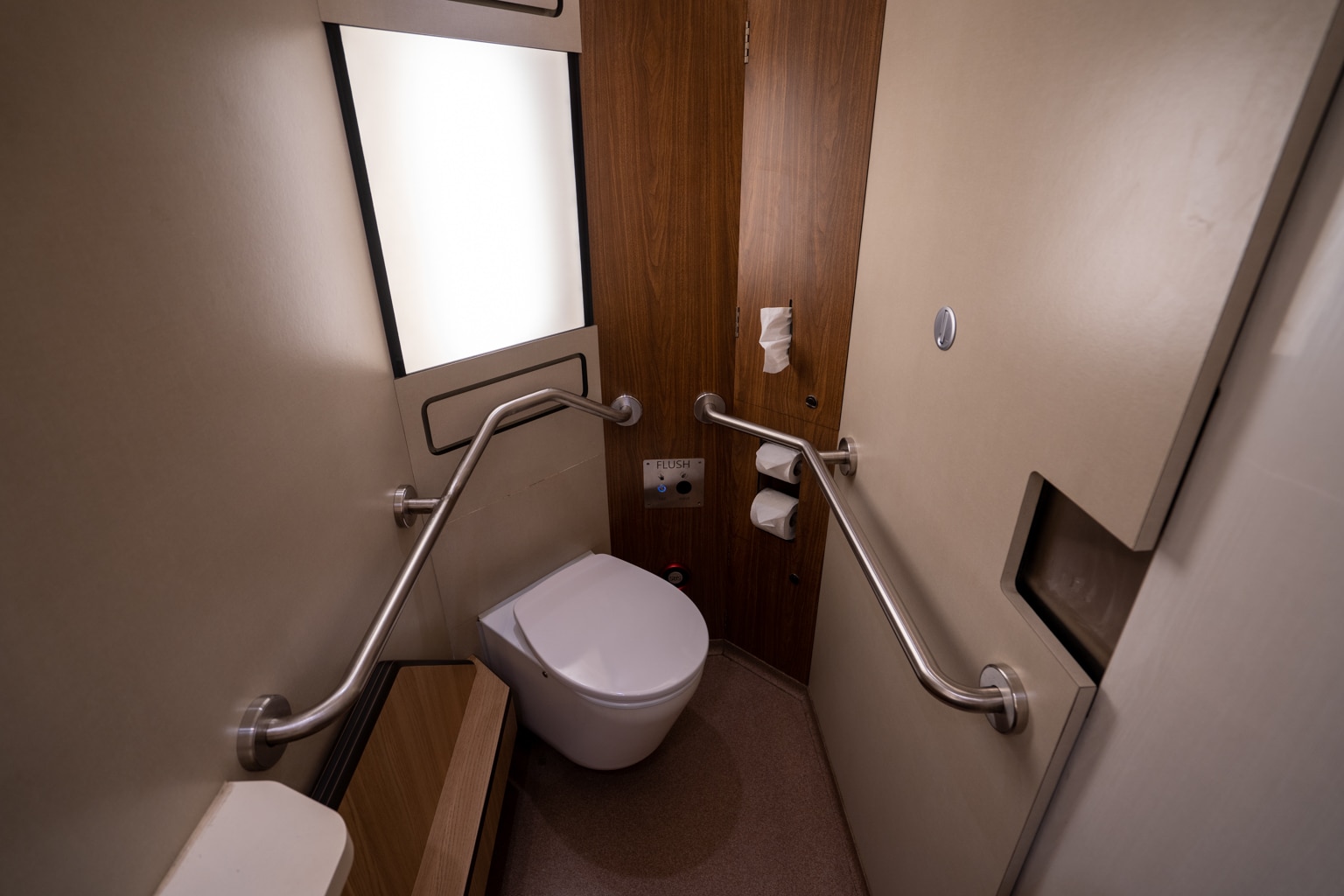
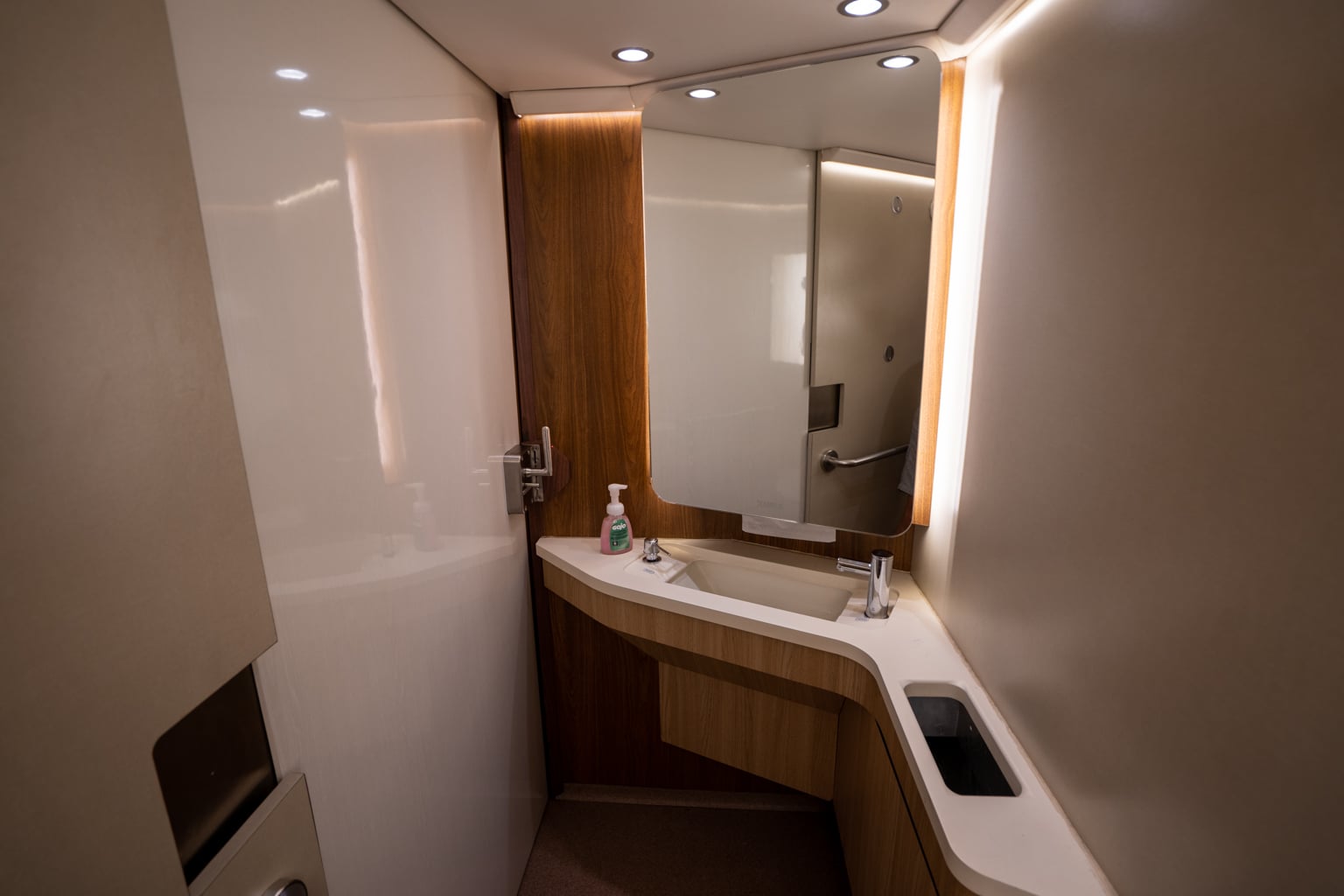
There is a bench that folds down beside the toilet, a reasonably large mirror, and a small sink below.


Aside from the glass ceiling on the viewing deck, the highlight of the Rocky Mountaineer is the outdoor vestibule. The outdoor deck allows passengers to get closer to the scenery around them.
We loved leaning over the railings and feeling the fresh air and wind on our faces, taking in the scenery as it passed by. We spent a lot of time out here simply soaking up and appreciating the views.
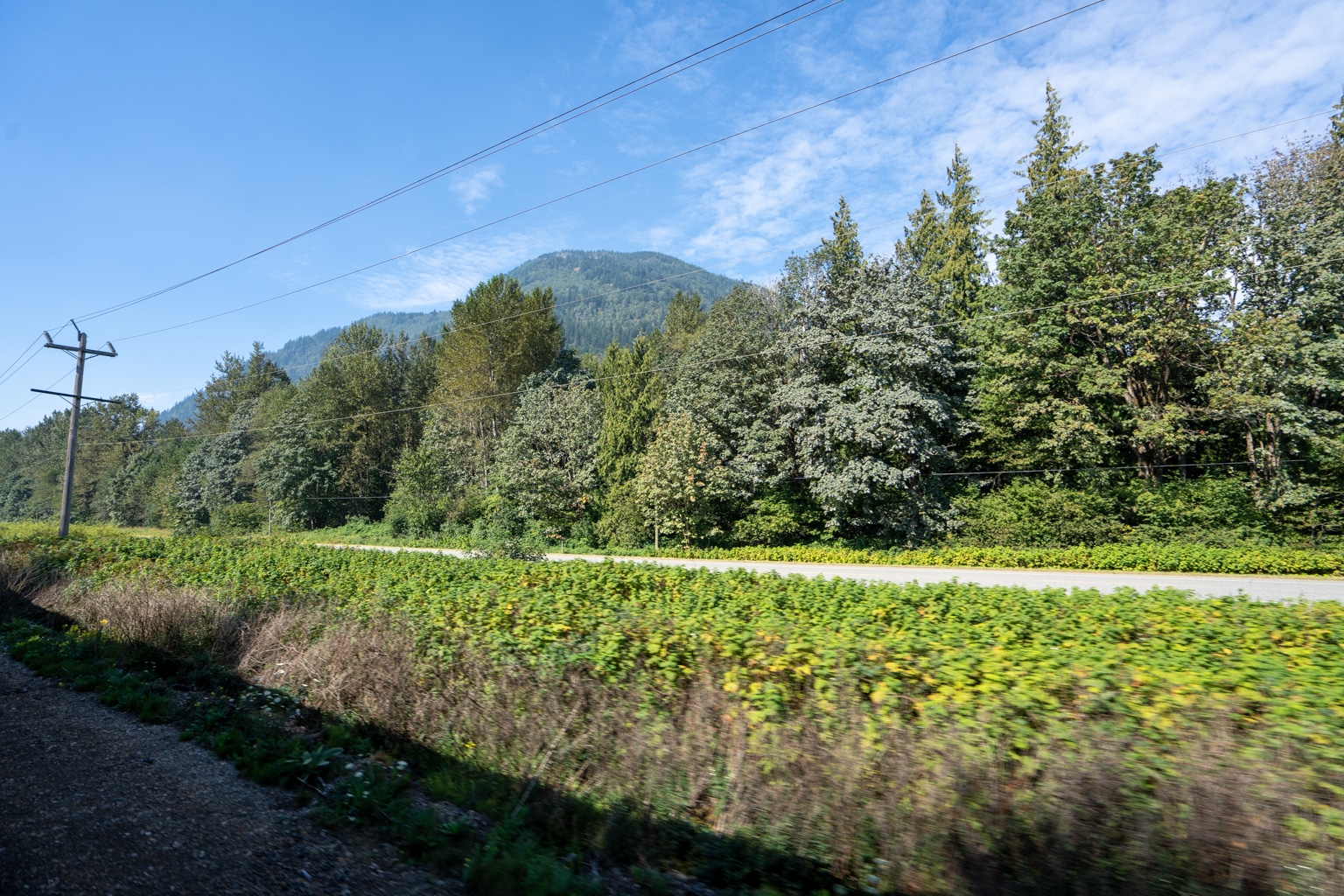
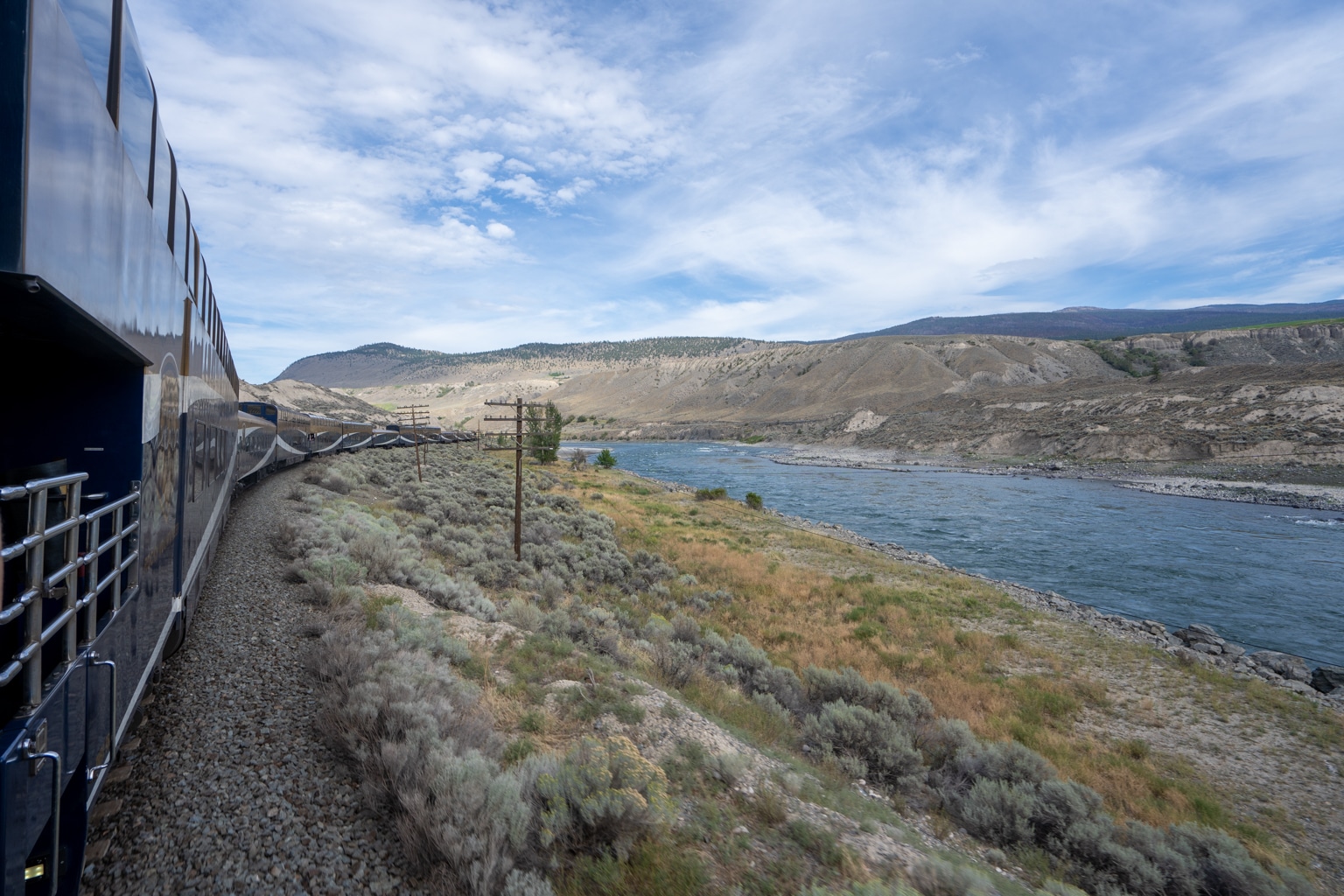

Conclusion
The Rocky Mountaineer offers a more romantic and slow-paced style of travel compared to what I’m typically used to.
After my maiden experience, I’d describe luxury train travel as a type of “land cruise”, well-suited for travellers who are happy to take in views at a leisurely pace without having to get up and exert themselves too much.
However, it’s also not going to be the right type of travel experience for everyone. To illustrate, Jessy and I were virtually the only individuals under 50 years old on board.
I’d say that the Rocky Mountaineer is ideal for travellers in their wiser years who want to relish the social element of wining and dining with fellow travellers, while also taking in the outstanding lush forests, rocky lakes, and epic mountains from the comfort of a panoramic viewing deck.
Meanwhile, for the younger travellers out there, consider bringing your parents along a special trip on the Rocky Mountaineer if this type of luxury train journey fits their travel style.
For us, this was a nice change from the typical busy airports and long flights. We certainly enjoyed our first luxury train experience, and look forward to trying out more rail adventures around the world.
















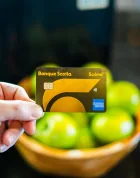
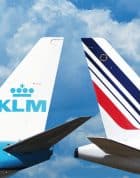
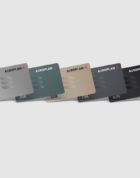

Hello there, which travel agency would you recommend to book the trip? Thank you!
Hi Annie, get in touch with us at booking@princeoftravel.com and we can assist!
Wonderful! Inquiry sent 🙂
You mention helping yourself often. Were not meals and drinks served to you? When you wanted a drink, was it self serve? I also find this voyage to be somewhat boring, and, as we are over 50, I would not even consider this voyage. That is the joy of your reviews to get inside information, and for that, I thank you.
Meals and drinks were served to us. I meant that we ordered the items, but realize the language may be confusing, so I’ll give it an update.
Sounds like you’ve got more energy in the tank and would prefer a faster-paced trip compared to many other travellers your age that we encountered on the train. That’s a good thing! 🙂